- Experiences
- Hotel Offers
- Da Nang & Hoi An
- Virtual Tour
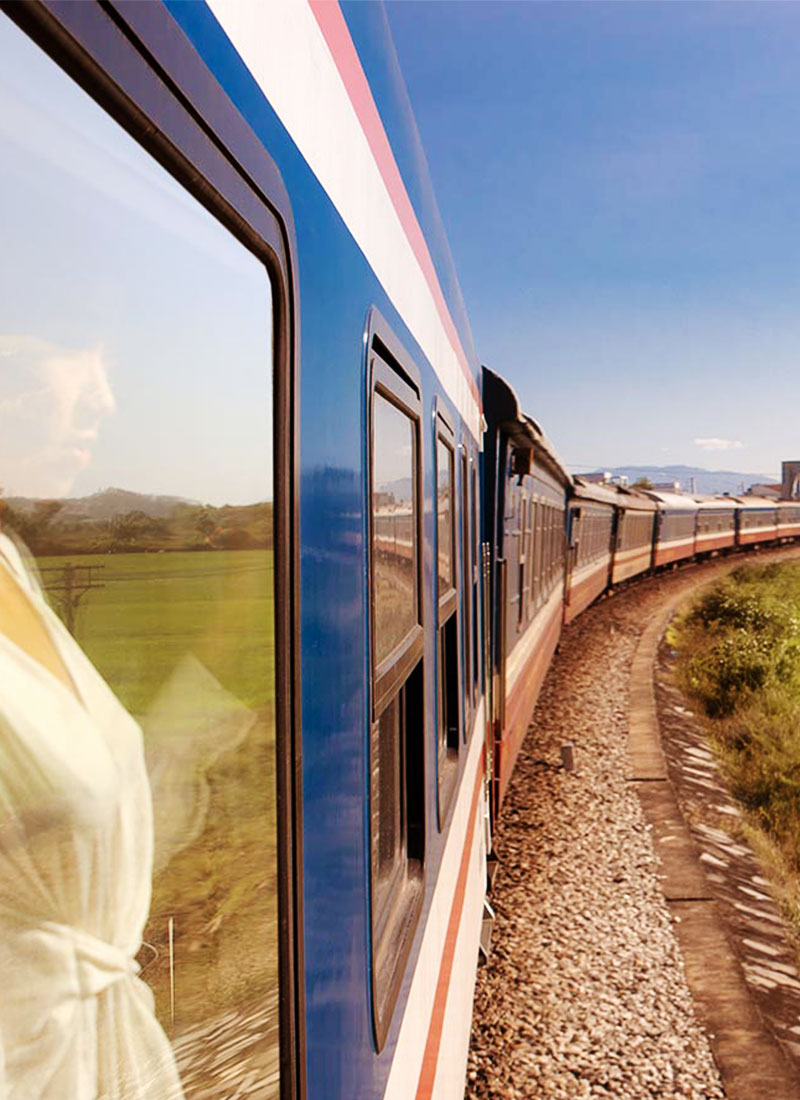

Step Aboard The Vietage
Embark on unforgettable railway adventures through the lush landscapes and spectacular scenery of Central Vietnam aboard The Vietage by Anantara luxury railway carriages. Make your Vietnam railway booking to embrace the epic romance of train travel on exquisite journeys.
From the heritage charm of Hoi An to the sparkling shores of Quy Nhon, or the bustling coastal city of Nha Trang heading north to Quy Nhon, The Vietage by Anantara combines old-world comfort, breath-taking views and gourmet dining experiences to leave you inspired, refreshed and ready for your next destination.
The Vietage has been developed by Anantara to introduce memorable luxury travel journeys through Vietnam. Two separate railway carriages run daily journeys in opposite directions, one departing in the morning from Da Nang to Quy Nhon and then on to Nha Trang and the second leaving Nha Trang in the afternoon to Quy Nhon and then continuing up to Da Nang.
Combination accommodation packages with extraordinary savings and extra perks are available with Anantara Hoi An Resort , Anantara Quy Nhon Villas or Avani Quy Nhon Resort for guests to experience these destinations and can be booked directly with us.
Destinations
Steeped in luxury and inspired by the timeless romance of rail travel, The Vietage by Anantara celebrates the art of the journey. When your adventure ends, you will be arriving at one of three very different, but equally charming, Central Vietnam destinations.
Da Nang & Hoi An
Just a short drive from Da Nang, the UNESCO World Heritage Site of Hoi An beckons with shophouse-lined alleyways, glowing lanterns, traditional teahouses and perfectly preserved architecture. Anantara Hoi An Resort is a charming luxury hideaway, edging the Thu Bon River, connecting travellers to traditional Vietnamese culture and ancient Champa kingdom treasures, the resort also is located 35 KM from Danang Train Station.
The golden shores of Quy Nhon take you off the beaten track to a place of tranquil coves, verdant national parks and ancient temples. Settle into seaside relaxation or venture out and explore the rich coastal culture of Central Vietnam at Anantara Quy Nhon Villas and Avani Quy Nhon Resort with beachfront basking and adventurous discoveries.
Nha Trang, situated along Vietnam's South Central Coast, is a captivating blend of pristine beaches, cultural landmarks, and vibrant nightlife. With its golden sands and turquoise waters, the city attracts sun-seekers and water sports enthusiasts alike. Explore the ancient Po Nagar Cham Towers or browse the lively Dam Market and indulge in the city's bustling nightlife. Nha Trang's coastal charm, rich history, and modern amenities make it a must-visit destination for a perfect blend of relaxation and adventure.
FAQs About the Vietage
Get all the information you need before your journey aboard The Vietage by Anantara.
The Vietage by Anantara operates daily, connecting the cities of Da Nang, Quy Nhon, and Nha Trang. Guests can choose to travel from Da Nang to Quy Nhon, Quy Nhon to Da Nang, Nha Trang to Quy Nhon, or Quy Nhon to Nha Trang. For the updated timetable for each route, please refer to our official schedule . Tickets for all journeys can be reserved directly with us.
The Vietage by Anantara consists of two distinct railway carriages, each undertaking daily journeys in opposite directions. The first carriage departs in the morning from Da Nang to Quy Nhon, continuing on to Nha Trang. The second carriage departs from Nha Trang in the afternoon, traveling to Quy Nhon and then up to Da Nang. The average speed of The Vietage by Anantara is 51.9 kilometres per hour.
For the six-hour journeys between Da Nang and Quy Nhon, a pre-ordered three-course gourmet meal will be served. Complimentary snacks, free-flow selected wine, cocktails, mocktails, teas, coffee, and soft drinks are included, plus a 15-minute head and shoulder treatment.
For the five-hour journeys between Quy Nhon and Nha Trang, a luxury afternoon tea experience featuring local caviar, Vietnamese artisanal cheeses, a selection of premium Vietnamese teas from Epicurean Sao and a selection of cold cuts will be served. Complimentary snacks, free-flow selected wine, cocktails, mocktails, teas, coffee, and soft drinks are included, plus a 15-minute head and shoulder treatment.
Our onboard facilities include a sit-up bar, a designated area for head and shoulder treatments, restroom facilities, six private booths with two comfortable seats per booth including power outlets, charging stations, amenity baskets featuring pillows, blankets and additional essentials, plus complimentary Wi-Fi, and a ‘Discovery Book’. Exclusively for the journey from Quy Nhon to Danang, sleeper booths are available, subject to availability.
Both The Vietage by Anantara tickets and accommodation packages can be reserved directly with us through the following channels:
- Official Website:
Visit our official website https://www.thevietagetrain.com/ to make seat reservations.
For combination stays with Anantara Hoi An Resort , Anantara Quy Nhon Villas , or Avani Quy Nhon Resort , reservations can be made through the respective resorts’ official websites.
- Reservations Team:
Contact our reservations team directly via email at [email protected] or by phone at +84 (0) 256 3686 168 to secure your seats or enquire about available accommodation packages.
- Live Chat (Daily from 8:00 am – 7:00 pm GMT+7)
Utilize the Live Chat plugin available on the bottom right corner of our website homepage https://www.thevietagetrain.com/ for real-time assistance, or through social media inbox support https://www.facebook.com/thevietage , or WhatsApp number +84 (0) 912 579 252.
The Vietage by Anantara travels daily from Da Nang to Nha Trang and Nha Trang to Da Nang with a stop in Quy Nhon in each direction. Guests are recommended to book the short journeys between Da Nang – Quy Nhon and Nha Trang – Quy Nhon with a combination stay at Anantara Quy Nhon Villas for the ultimate luxury experience and better combination rates with accommodations. The long journeys between Da Nang and Nha Trang are limited and subject to availability and can only be reserved directly with our Reservations team via [email protected] .
Children of all ages are welcome aboard The Vietage by Anantara. Children under the age of 4 are complimentary when sharing a seat and meal with an adult. Only one child is allowed per paying adult. Children aged 4 years and above will be charged as an adult price.
Guest Reviews
Hoi an to quy nhon in style.
6 hours of complete zen. One of our best travel experiences to date. With a free flow of bubbles, wines and beer parried with a 3 course delicious lunch. We enjoyed every bit and hope to be back in near future. Hats off to the chef to pulled off serving this level of food on a train, and the wonderful staff.
A luxury escape through Central Vietnam!
As we excitingly settled into our seats, The Vietage’s hosts offered refreshments alongside a plate of freshly baked French pastries. Yum! We each opted for a tasty morning coffee as our journey to Quy Nhon was underway! As the train chugged along, we took full advantage of their free-flow wines, beers, soft drinks, tea and coffee on board. We sipped sparkling Prosecco and chatted over glasses of Sauvignon Blanc all afternoon! Around noon, The Vietage’s Executive Chef brought together modern Vietnamese cuisine, French culinary techniques and international flavours to bring passengers an exquisite three-course afternoon meal. Their specially curated menu offers delectable meat, fish and plant-based dishes, which you choose prior to boarding. To start I had ordered the ‘Foie Gras Terrine & Duck Confit,’ for my main the ‘Braised Wagyu Neck’ and for dessert the chocolate ‘Crème Brulée.’ It was truly a meal to remember! Included in our journey was a 20-minute soothing head and shoulder treatment, which was the perfect little massage to fully revitalize us before reaching Quy Nhon!Our 6 hours aboard The Vietage seemed to have flown by. We chatted, laughed and sipped away the afternoon as the beautiful beachy Quy Nhon slowly came into view. To put it simply, my journey aboard The Vietage was a stand out. There is just no comparison to the absolutely incredible time we had aboard The Vietage. Its charm alone speaks to the thrill of travel as a whole and I can only wish the ride was longer!
A timeless experience…
I had the privilege to be part of this exceptional train cruise from Quy Nhon to Da Nang. The experience is wonderful in all aspects : from the comfort of the cabin which is smartly designed with lots of little storage; the food experience on board; the social experience with the other guests coming from all over the world to the nice atmosphere in the bar compartment. I must say that could not be possible without the amazing service provided by The Vietage team.
An elegant luxurious train trip
In life there are a number of bucket list trips that you hope to get too and The Vietage was one of them for us. This trip was part of our honeymoon and from the moment we checked in Da Nang Train Station until we disembarked in Quy Nhon this was a trip that we will long remember. We were greeted warmly and welcomed by the professional, courteous staff and soon settled into our cabin. It was elegantly appointed and every aspect of this trip was filled with elegance and delight. Bao and his team went above and beyond and our cabin steward was attentive and accommodating to ensure we had the most amazing. The food was another experience that will long be remembered and was carefully created by the chefs to offer tastes of French and Vietnamese influence. The bar was a great place to connect with other guests and the view of the countryside is spectacular as we made our way to Quy Nhon.

- Privacy Overview
- Strictly Necessary Cookies
This website uses cookies so that we can provide you with the best user experience possible. Cookie information is stored in your browser and performs functions such as recognising you when you return to our website and helping our team to understand which sections of the website you find most interesting and useful.
Strictly Necessary Cookie should be enabled at all times so that we can save your preferences for cookie settings.
If you disable this cookie, we will not be able to save your preferences. This means that every time you visit this website you will need to enable or disable cookies again.
- google-plus
- +84 829 098 686
- [email protected]
- Mon - Fri: 8:00 - 18:00

North Vietnam Tours
Tours in the Central
Tours in the South
- Ha Giang Tours
- Cao Bang Tours
- Mu Cang Chai Tours
- Ninh Binh Tours
- Pu Luong Nature Reserve Tours
- Cat Ba Island Tours
- Halong Bay Tours
- Son La Tours
- Lan Ha Bay Cruises
- Halong Bay Cruises
- Bai Tu Long Bay Cruise
- Hanoi Tours
- Ba Be National Park Tours
- Bac Son Tours
- Mai Chau Tours
- Ban Gioc Waterfall Tours
- Hoi An Tours
- Quang Binh Tours
- Quang Ngai Tours
- Quy Nhon Tours
- Buon Ma Thuot Tours
- Da Nang Tours
- Mekong Delta Tours
- Da Lat Tours
- Can Tho Tours
- Nha Trang Tours
- Ho Chi Minh City Tours
- Phu Quoc Island Tours
- Vung Tau Tours
- Top 10 things to do in Ha Giang
- Top 10 things to do in Mu Cang Chai
- Top 10 things to do in Ninh Binh
- Top 10 things to do in Cat Ba Island
- Top 10 things to do in Sapa
- Top 10 things to do in Halong Bay
- Top 10 things to do in Hanoi
- Top 10 things to do in Cao Bang
- Top 10 things to do in Hoi An
- Top 10 things to do in Quang Binh
- Top 10 things to do in Hue
- Top 10 things to do in Da Nang
- Top 10 things to do in Quy Nhon
- Top 10 things to do in Phu Quoc Island
- Hanoi Tour Packages
- Hanoi Photography Tours
- Hanoi Culinary Tours
- Hanoi Tours To Halong
- Hanoi Tours To Sapa
- Tours Hanoi To Ninh Binh
- Sapa Homestay Tours
- Sapa Hiking Tours
- Sapa Market Tours
- Sapa Luxury Tours
- Sapa Eco Tours
- Fansipan Trekking Tours
- 6 Best Tours in Halong
- Halong Private Tours
- Halong Seaplane Tours
- Halong Shore Excursions
- Multi-Day & Extended Tours
- Day Trip & Excursions
- Cat Ba Island
- Cat Ba Island Kayak Tour
- Cat Ba Monkey Island Tour
- Cat Ba Island Day Tours
- Cat Ba Island Boat Tours
- Cat Ba Island Tour Halong
- Cat Ba Tours From Hanoi
- Tam Coc Tours
- Cuc Phuong National Park Tours
- Quang Binh Adventure Tours
- Thien Duong Cave Tours
- Phong Nha Cave Tours
- Hue Sightseeing Tours
- Hue Walking & Food Tours
- Bach Ma National Park tours
- Tours to Quang Binh From Hue
- Tours to Da Nang from Hue
- Hoi An Tour from Hue
- Sightseeing Tours
- Danang Free & Easy
- Day Trips & Excursions
- Eco Adventure Tours
- Shore Excursions
- Hoi An Tour Packages
- Eco Tours Hoi An
- Hoi An Walking & Food Tours
- Tours from Hoi An to Hue
- Tours from Hoi An to Quang Binh
- Tours From Hoi An to Da Nang
- Con Dao Island Tours
- Vung Tau Mekong Delta Tour
- Vung Tau Tour From Saigon
- Tour from Phu My Port
Top 10 Destination in North Vietnam
- Mu Cang Chai
- Bai Tu Long Bay
Top 10 Destination in Central
- Buon Ma Thuot
- Mui Ne Beach
Top 10 Destination in The South
- Ho Chi Minh City
- Phu Quoc Island
- Suggested Vietnam Itineraries
Vietnam Rail Tours
- Vietnam Beach Holidays
- Vietnam Classic Tours
- Vietnam Family Tours
- Vietnam Photography Tours
- Vietnam Food Tours
- Vietnam Honeymoon Tours
- All Inclusive Tour Packages
- Vietnam Luxury Tours
- North Vietnam Itineraries
- Central Vietnam Itineraries
- South Vietnam Itineraries
- Vietnam Shore Excursions & Tours
NOT sure where to go next? We’re here to inspire you
The True Vietnam
Vietnam is vast and the train is the best way to see as much of it as possible (while enjoying comfort and great view, too)
Take it Slow
Stop along the way and give yourself time to explore. The trip across Vietnam can take as long as you want it to.
Local Vietnamese Tales
Your hosts onboard the train will weave stories about local history as the scenery unfolds.
Vietnam Rail tours bring the unique travel vacation within Vietnam by the main transportation by railway. These tours offer first class sleeper train Vietnam – the wonderful way to travel from North to South Vietnam. Especially, this is the great way for your first time travel Vietnam. In fact, Train journey through Vietnam conduct visitors the beautiful and scenic different province along the country.
Passing through the time and travel style, Vietnam by train itinerary has different destinations along the country. And the quality of train is improving better and better for tourism and the most comfortable for everyone. Just make Vietnam Rail tours and enjoy the iconic sights of the countryside landscapes from the train.
Let experience Vietnam as the way you are to get deeply the local life of the country.
Train Journey Through Vietnam
The best train trips in vietnam, discover north & central vietnam by train 10 days.
This trip package will bring you the unhurried way of life and enjoy the beauties of the country by train. Check it now
The Best North Vietnam Railway Trip 7 Days
This special trip will bring you to discover the beauties in North Vietnam. You will have chance to taste local Hanoi foods with special Vietnamese cuisines. Check it now
Luxury Night Train to Sapa from Hanoi 3 Days
It will be the great journey to discover the mountainous area, get trekking experience at minority village, waterfall and pleasure yourself on Victory Sapa resort with the perfect harnormy with the nature. Check now
Travel to Bac Ha Sunday Market By Train 3 Days
Wow! Get the funny at hill tribe market which you get new experience at remote area. Check it now

Ms. Angela is our experts for this itinerary and as seasoned travellers she has the inside track on the most memorable adventures.
All are tailor-made tour from Origin Travel Team
This itinerary is to give you the flavor experience we can do in Vietnam!
"What our Customers are saying"

Our difference
Origin Vietnam Responsible travel for Sharing Benefit with Local Community.
A small thing we do on our tours can make a big difference, so everyone at Origin Vietnam Travel, we strive our best to minimize the impacts while giving maximum enjoyment from your traveling experience. Continue reading ..
Top Things To Do In Vietnam
All Things need to know before travelling to Vietnam

Ai Chi Lang
Possessing rugged terrain and massive scale, Ai Chi Lang has long been considered a wall protecting Thang Long citadel from invasions from northern countries in

Top 10 Things to Do in Lang Son
Located in the northeastern region of the country, Lang Son is also affectionately known as the Xu Lang. Attracting visitors not only with unique cuisine,

Dang Mo Waterfall
Dang Mo Waterfall is one of the famous waterfalls. This is always a must – visit place in Lang Son. Although it is not easy

Huu Lung is a famous tourist destination in the midland and mountainous region of Northeast Vietnam. Not only does it make many people bewildered and

Tam Thanh Pagoda
Lang Son is the first land of Vietnam from the North, a place associated with many historical relics, temples, along with charming and poetic natural
Vietnam Travel Blog
BE INSPIRED, BE READY
Get new experience of travel stories, taste local ingredients in traditional and local cuisines. It will take you into stepping of discover hidden of Vietnam!

When Is The Best Time To See The Golden Rice Fields In The Northern Vietnam

How Beautiful Bac Son On Rainy Season?

Top 10 Foods in Lang Son
NOT sure where to go next? We're here to inspire you
Customize Private Vietnam Tours & Travels tailor-made by our local specialists. Start planning your authentic insider Vietnam holiday & trips now
YOUR TRAVEL PLAN
- Industry News
- Download Brochures
- Useful Information
- Photo Gallery
- Construction Reports
- Operations Reports

Enter your email and password and start exploding Origin Travel features
Train travel in Vietnam
Vietnam has a very extensive and good rail network from Ho Chi Minh City (South) to Lao Cai, the station for visiting Sapa in the north of Vietnam. Traveling by train through Vietnam is a lot easier than taking the bus. Although it can be slower than by bus, you have much more space and it is safer. The tracks and trains are a bit outdated, but it’s a great way to explore Vietnam. Especially the night trains, with air conditioning and beds, are a better alternative than the long bus routes.
On this page you will learn the following about traveling by train in Vietnam:
Why travel by train through Vietnam
The trains and classes.
- Buy a train ticket in Vietnam
Train times
Train stations in vietnam, the most popular train routes in vietnam.
Traveling by train in Vietnam is really an unforgettable local experience. The biggest advantage of this means of transport is the reasonable price and safety. The fare is half a flight and only slightly more expensive than the bus. The slow train goes through mountains, forests, valleys and even along the ocean, allowing you to enjoy the authentic natural view of Vietnam. Moreover, it is an interesting way to travel by train for a few hours to make friends with the locals and get a better picture of their daily lives.
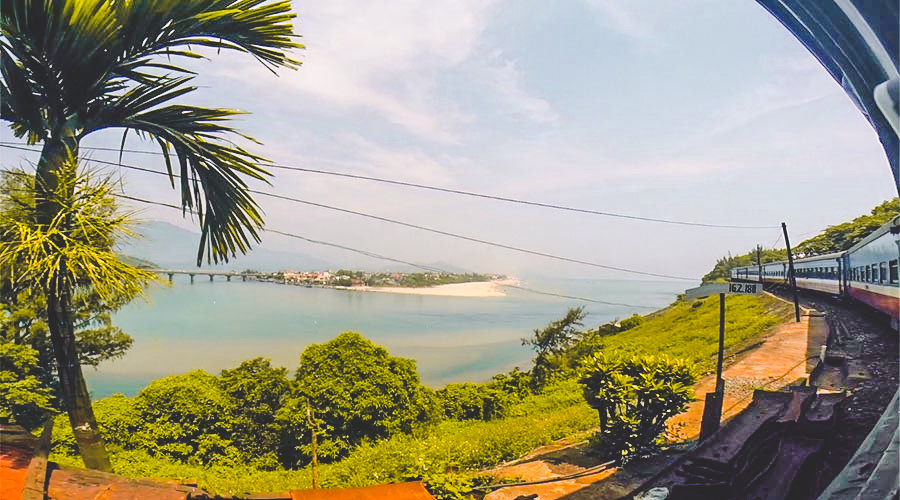
The railways of the Vietnam Railways run along the coast and connect Hanoi with Ho Chi Minh City and Hai Phong with train connections to the Chinese border. The government is modernizing the network and the trains themselves. Trains with SE are often new and faster trains. Trains that are referred to as TN are the obsolete trains. Moreover, it is an interesting way to travel by train for a few hours to make friends with the locals and get a better picture of their daily lives.
The options
You can usually choose from a hard seat or a soft seat and a hard sleeper or a soft sleeper . And then with or without air conditioning . The hard seats are the cheapest class and are often full of locals.
You can take your luggage into the wagon and put it in racks above your head or under the seat. Some travelers secure their luggage to the rack with a bicycle lock. It is even possible to take your motorcycle on the train.
Like many countries, Vietnam also has the option of using night trains, which saves an overnight stay in a hotel and a day’s travel and is often a better alternative than a long bus trip. The fastest route from Hanoi to Ho Chi Minh City is approximately thirty hours. The train runs fairly slowly; often around 50 km / h through the landscape.
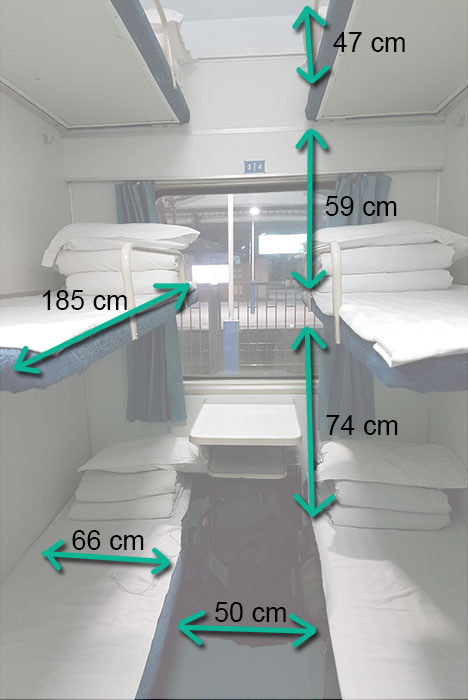
Buying a train ticket in Vietnam
Train tickets are generally more expensive than the bus, but cheaper than a domestic flight. The price of tickets depends on your train and which class you book. Hard seats is the cheapest and least comfortable option. Soft sleeper is suitable for long distances at night, but also more expensive (recommended!). For a ride from Hanoi to Hue you pay around 500,000 Dong, which is around $ 22. Often, the earlier you book the tickets, the cheaper the price.
Because the trains in Vietnam always have a limited amount of soft sleepers, it is wise to book train tickets as early as possible. Train tickets are usually available from 60 days before departure (sometimes 90 days in advance).
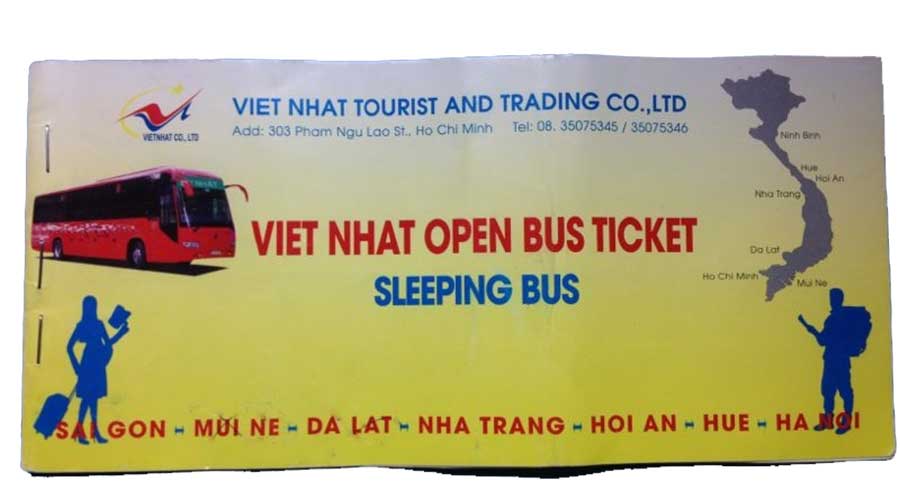
Where to book a train ticket
Tickets are available at stations and travel agencies, hotels and online via the Vietnam Railways website , Bao Lau and 12go.asia .
Several Reunification Express trains depart daily from Hanoi and Ho Chi Minh City. Train times change regularly, so check the departure times on the Vietnam Railways website.
Vietnamese trains are not always on time. There is often a delay, sometimes a few hours. Do not plan your connecting flight without a significant pause between the arrival of the train and your next departure. The weather can also cause train delays. Conditions are changing rapidly and they do not announce delays or cancellations in advance.
The most popular train stations in Vietnam are:
Train stations in North Vietnam
- Lao Cai (near Sapa)
Train stations in Central Vietnam
- Dong Hoi (near Phong Nha)
- Dieu Tri (near Quy Nhon)
Train stations in South Vietnam
- Ho Chi Minh City
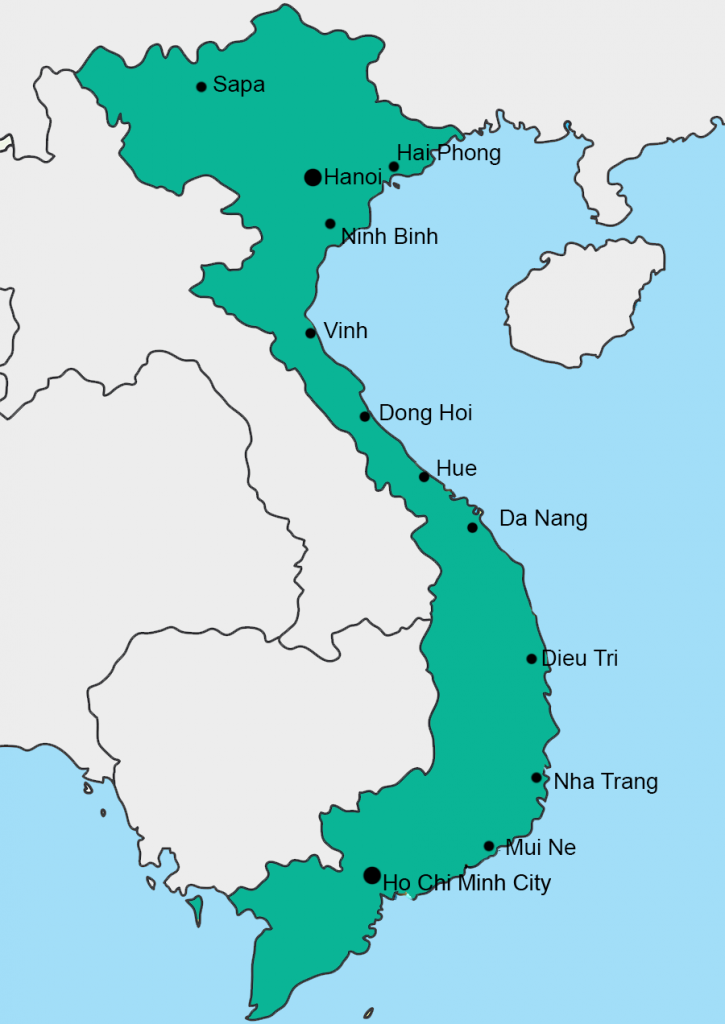
From Hue to Da Nang
The most beautiful train route is from Da Nang to Hue along the famous Hai Van Pass. On one side you have a beautiful view of the ocean and on the other side the mountain pass. A good alternative if you prefer not to drive the motorcycle over the pass.
From Hanoi to Sapa (Lao Cai)
In the past it was even the only way to get to Sapa from Hanoi, but now you have a good road and great bus connections. It is now still the most popular train connection for tourists in Vietnam. You arrive at the train station of Lao Cai, where you drive the last 40km to Sapa by taxi, bus or minibus.
From Nha Trang to Quy Nhon
Not a popular train route, but a very beautiful one is from Nha Trang to Quy Nhon. This train route rises almost the entire journey along the ocean.
From Ho Chi Minh City to Mui Ne (Phan Thiet)
This 4-hour train journey takes you past beautiful rice fields to Phan Thiet. From the station it is a short 20km to Mui Ne.
Trains are much safer than buses. Trains also don’t run fast, so you don’t have to worry about accidents. Minor crime is rare on Vietnamese trains. Thieves occasionally try to get things through the window when the train is stopped. Always keep your bag close by and attach or tie it to something, especially at night.

- Book a ticket in advance to choose the best seat!
- Bring some food for a late evening meal or snack in between if you are afraid of food quality on the train.
- A towel can be used as a blanket and keeps you warm during the long journey.
- If you sleep on a hard or soft chair, bring a neck pillow.
- Do not bring too much luggage; you cannot sleep well while you watch over your belongings all the time.
- Take small change to pay for the taxi from the station and for food on the train.
- If there are problems with your seat or the food, do not hesitate to report it to the conductor.
- Mekong Delta
- Language & travel dictionary
- Electricity
- Internet & calling
- Best travel time & weather
- Hoe does it work?
- Visa on Arrival
- Visa at embassy
- Holidays & Events
- People & minorities
- Flights to Vietnam
- Domestic flights
- Motorbike buy/rent
- Train travel
- 15 most beautiful destinations
- 20 best things to do
- 10 best off the beaten track
- 10 most stunning beaches
- 10 best rice fields places
- 10 best adventures
- 10 cultural experience
- All travel inspiration
- Package trips
- Custom made trip
- Destination Guide
- Essential Guide
- Getting Around
- Vietnam Month by Month
- Inspiration
- Vietnam blog
- Travel tips
- Custom Made Trip
- Day- & Multiple Day tours
- Holiday Packages
- Local Meo Vac Homestay
- Local Dong Van Homestay
- Our Team & Company
- Our Customers & Reviews
Copyright © 2023 Local Vietnam
Start typing and press enter to search
Free ebook vietnam travel guide.

Traveling and Exploring in Northern Vietnam
Train Travel in Vietnam → FULL Guide ☀️

1. Vietnam Train Travel 2. Historical Background 3. Types of Trains 4. Planning a Journey 5. Onboard Experience 6. Practical Travel Tips 7. Vietnam by Rail 8. Future Outlook 9. Railway Stations 10. FAQ+ Answers 🎫 Book Train Tickets
🚉 Train Travel in Vietnam – Complete Guide:
▶️ 1. introduction to train travel in vietnam:.
Vietnam stands as a captivating destination, steeped in a rich tapestry of history, adorned with breathtaking natural wonders, and vibrant with cultural treasures waiting to be discovered. Amidst the modern hustle and bustle of transportation options , there exists a timeless allure to embarking on a journey through Vietnam’s picturesque landscapes by train. In this comprehensive guide, we extend an invitation to travelers worldwide to immerse themselves in the enchanting world of train travel in Vietnam —a journey that seamlessly intertwines the past with the present, promising unforgettable experiences and insights into this captivating destination.
Overview of Vietnam’s Extensive Rail Network
- As one of Southeast Asia’s most expansive railway systems, Vietnam’s rail network spans over 2,600 kilometers, weaving its way through verdant countryside, bustling urban centers, and picturesque coastal regions. From the historic capital of Hanoi in the north to the vibrant metropolis of Ho Chi Minh City in the south, the railway network connects key destinations, offering travelers glimpses into Vietnam’s rich tapestry of culture, history, and natural beauty.
The Importance and Timeless Appeal of Train Travel in Vietnam
- Trains hold a special place in the hearts and minds of the Vietnamese people, symbolizing not only a mode of transportation but also serving as a testament to the country’s resilience, progress, and enduring spirit. For travelers, the allure of train travel in Vietnam lies in its ability to provide an immersive and authentic experience, allowing passengers to witness the captivating beauty of the country’s landscapes unfold outside their windows while forging connections with fellow travelers from all walks of life. Whether it’s the rhythmic clickety-clack of the train wheels or the ever-changing scenery passing by, each moment onboard embodies the essence of exploration and adventure.
Purpose and Scope of this Comprehensive Guide
- The purpose of this guide is to serve as a trusted companion for those embarking on a journey through Vietnam by train , offering valuable insights, practical tips, and recommendations to enhance every aspect of the experience. From planning your routes and booking tickets to navigating onboard amenities and uncovering hidden gems along the way, our aim is to empower travelers to embark on a memorable adventure through the heart of Vietnam’s railway network. With a wealth of information at your fingertips, you’ll be well-equipped to make the most of your journey and create lasting memories as you traverse this captivating country by train.
▶️ 2. Historical Background of Vietnam Railway:
The narrative of Vietnam’s railways unfolds as a tapestry woven with strands of innovation, resilience, and advancement. Its inception dates back to the late 19th century, under French colonial rule, with the laying of the first railway line between Saigon (now Ho Chi Minh City) and My Tho in 1881. This marked the genesis of a transformative chapter in the nation’s transportation history.
Significance of Trains in Vietnam’s History and Culture
- As the need for connectivity burgeoned, subsequent decades witnessed the sprawling expansion of Vietnam’s railway network, spanning from the towering peaks of the north to the fertile plains of the south. Railways emerged as vital arteries, knitting together communities, fostering commerce, and molding the country’s identity. Trains, entrenched in the collective consciousness of generations, embody narratives of fortitude, solidarity, and perseverance for the Vietnamese people. In times of turmoil, they carried the flame of optimism, kindling dreams of a brighter horizon amid shadows of uncertainty.
Evolution of Vietnam’s Train Infrastructure
- Beyond their pragmatic role, trains have woven themselves into the fabric of Vietnam’s cultural ethos. From the iconic locomotives enshrined in literature and art to the rhythmic heartbeat of trains resonating through bustling terminals, the railway has become an inseparable facet of Vietnamese identity—a symbol of progress intertwined with tradition. The trajectory of Vietnam’s train infrastructure has been one of continuous evolution, adapting to the demands of a swiftly evolving society. From the era of steam-powered locomotives to the sleek, high-speed trains of the present day, technological advancements have propelled the country’s railways into the modern era, enriching efficiency, safety, and passenger comfort.
- Investments in modernization endeavors, such as electrification schemes and the introduction of state-of-the-art rolling stock, have not only elevated service standards but also laid the groundwork for future expansion and development. As Vietnam steers its course towards progress, the railway stands as a steadfast ally, guiding the nation towards a promising tomorrow.

▶️ 3. Types of Trains in Vietnam:
Vietnam’s railway network offers a wide range of train classes and categories to suit every traveler’s preferences. From budget-conscious backpackers to luxury-seeking adventurers, there’s a train option for everyone.
1. Standard Classes Overview
- Discover the various standard classes available, including economy and first-class cabins, catering to different budgets and comfort levels.
2. Luxury Sleeper Trains
- Indulge in the epitome of luxury with sleeper cabins in luxury trains, offering spacious seating and exclusive amenities for a truly indulgent journey.
3. Immersive Sleeper Trains Experience
- Explore the convenience and comfort of sleeper trains, featuring cozy berths and deluxe compartments, allowing travelers to rest and rejuvenate amidst Vietnam’s breathtaking landscapes.
Distinguishing Local vs. Long – Distance Trains
Understand the differences between local and long-distance trains in terms of route length, amenities, and passenger demographics, to choose the ideal option for your journey.
1. Local Trains: Short Routes for Commuters
- Experience the simplicity of local trains, operating on shorter routes and offering basic facilities catering primarily to local passengers and short-distance travelers.
2. Long-Distance Trains: Extensive Routes for Comfort
- Embark on extended journeys with long-distance trains, equipped with a wider range of amenities including sleeper compartments and dining cars for a comfortable and convenient travel experience.
Comparing Seating and Sleeper Options
Explore the variety of seating and sleeper options available aboard Vietnam’s trains, from standard seats to spacious cabins, ensuring a comfortable and enjoyable journey for passengers of all preferences.
1. Seating Arrangements: Comfort and Affordability
- Find the perfect balance between comfort and affordability with a range of seating arrangements including standard seats and reclining chairs.
2. Sleeper Berths: Rest and Recharge
- Opt for sleeper berths for overnight journeys, featuring cozy bunks and spacious cabins with amenities such as bedding and personal storage space, ensuring a restful journey amidst Vietnam’s stunning vistas.
⭐⭐ Search and book train e-tickets in Vietnam easily online on Baolau ➜ or 12go.asia ➜ ⭐⭐

▶️ 4. Planning Your Vietnam Rail Journey:
Exploring Vietnam’s vast and diverse landscapes via rail beckons travelers to uncover hidden gems and cultural marvels. Before embarking on your adventure, carefully select destinations and routes that resonate with your interests and desires.
1. Discovering Captivating Destinations
- Vietnam presents a myriad of captivating destinations accessible by train, from the vibrant streets of Hanoi to the tranquil shores of Da Nang or the gateway to Sapa town in Lao Cai . Tailor your itinerary to match your preferences, whether you’re drawn to historical landmarks, nature’s wonders, or culinary delights.
2. Ticket Booking Options: Online vs. Stations
- When it comes to booking tickets for your Vietnamese rail journey, you have two primary options: online platforms ( Baolau ➜ or 12go.asia ➜ ) or railway stations. Online platforms offer convenience and flexibility, enabling you to browse schedules, compare prices, and reserve seats or berths from the comfort of your home. Alternatively, purchasing tickets directly from railway stations provides the opportunity for face-to-face interaction and personalized assistance from ticket agents, albeit requiring more time and effort.
3. Understanding Ticket Classes and Fares
- Navigating ticket classes and fare structures is crucial for a smooth journey. Vietnamese trains typically offer a range of classes, from economy to first-class cabins, each with its own amenities and price points. Fare structures vary based on factors such as distance, class, and seasonality. Familiarize yourself with fare rules, including refund policies and ticket validity periods, to avoid surprises during your travels.
4. Tips for Optimal Seat or Berth Selection
Enhance your rail experience by securing the best seats or berths with these helpful tips:
- Book in advance: Secure your preferred seats or berths by booking well ahead of popular travel dates.
- Choose off-peak times: Opt for off-peak hours or seasons for increased availability and potential fare savings.
- Consider upgrades: Upgrade to a higher class or sleeper berth for added comfort and amenities if your budget allows.
- Stay flexible: Maintain flexibility with travel dates and times to maximize seat or berth options.

▶️ 5. Onboard Experience: Comfort and Convenience
Embark on a journey of comfort and convenience as you step onto Vietnam’s trains. Whether it’s a short commute or an overnight adventure, expect a host of facilities and amenities tailored to enhance your travel experience.
1. Facilities and Amenities
Vietnam’s trains are equipped with everything you need for a comfortable journey, from spacious seating areas and clean restrooms to air conditioning and power outlets. For overnight trips, cozy sleeper compartments offer privacy, bedding, and storage space for a restful night’s sleep amidst Vietnam’s captivating landscapes.
2. Culinary Delights
Indulge in Vietnam’s mouthwatering cuisine onboard with dining cars and snack carts offering a variety of savory treats and hearty meals. From steaming bowls of pho to refreshing Vietnamese coffee, satisfy your cravings as you traverse the country’s scenic railways.
3. Social and Entertainment
Experience the social aspect of train travel by striking up conversations with fellow passengers, swapping travel stories, or simply admiring the passing landscapes. Look forward to onboard entertainment options like movies, music, and games, ensuring a lively journey whether you’re traveling solo or with companions.
4. Safety and Security
While train travel in Vietnam is generally safe, it’s essential to remain vigilant. Keep your belongings secure, familiarize yourself with emergency procedures, and follow instructions from train staff in case of an emergency. With these precautions in mind, enjoy peace of mind as you embark on your Vietnamese rail adventure.

▶️ 6. Essential Packing Tips for Train Journeys
Embarking on a journey through Vietnam’s picturesque landscapes via train requires thoughtful packing to ensure comfort and convenience.
Consider including the following essentials:
- 1. Lightweight Luggage or Backpack: Opt for luggage or backpacks that are easy to carry and maneuver, particularly when navigating crowded platforms and train compartments.
- 2. Comfortable Clothing: Dress in layers to accommodate fluctuating temperatures onboard and at various stops along your journey.
- 3. Snacks and Water: Pack snacks and beverages to stave off hunger and thirst during your travels, as onboard dining options may be limited.
- 4. Travel-sized Toiletries: Bring essential toiletries such as hand sanitizer, tissues, and wet wipes to freshen up during your journey.
- 5. Entertainment: Pack books, magazines, or electronic devices loaded with movies or music to keep yourself entertained during long stretches of travel.
Navigating Language Barriers:
While English is commonly spoken in tourist areas and on trains, communicating with locals and train staff may pose challenges, especially in remote regions. To overcome language barriers:
- 1. Learn Basic Vietnamese Phrases: Familiarize yourself with essential phrases such as greetings, directions, and common questions to facilitate communication with locals and train staff.
- 2. Use Translation Apps: Download translation apps on your smartphone to bridge the language gap and facilitate real-time communication.
- 3. Carry a Phrasebook: Bring along a pocket-sized phrasebook or language guide for quick reference when in need of assistance or clarification.
Dealing with Delays and Cancellations:
While Vietnam’s trains generally adhere to schedules, delays and cancellations can occur due to various factors. To handle such situations:
- 1. Stay Informed: Keep abreast of updates or announcements regarding delays or cancellations via station monitors, announcements, or official railway websites.
- 2. Be Flexible: Remain flexible with your travel plans and be prepared to adjust your itinerary if necessary.
- 3. Seek Assistance: Approach train staff or station personnel for assistance in rebooking or finding alternative transportation options if your train is delayed or canceled.
Interacting with Fellow Passengers and Train Staff:
Train travel in Vietnam offers opportunities for interaction and camaraderie. To make the most of these social experiences:
- 1. Strike up Conversations: Initiate conversations with fellow passengers to share insights, travel tips, or stories.
- 2. Respect Cultural Norms: Be mindful of cultural differences and customs when interacting with locals and train staff, showing respect and consideration.
- 3. Express Gratitude: Show appreciation to train staff for their assistance and hospitality throughout your journey, whether through a thank you or a small gesture of appreciation.

▶️ 7. Exploring Vietnam by Rail:
Vietnam’s expansive railway network serves as a gateway to the country’s diverse landscapes, rich culture, and captivating history. Whether you’re an admirer of nature, a history enthusiast, or simply in search of an authentic travel experience, Vietnam offers a train route tailored to every taste.
- 1. Hanoi to Ho Chi Minh City : Embark on a journey from the bustling capital of Hanoi to the vibrant metropolis of Ho Chi Minh City. Traverse picturesque countryside, encounter historic landmarks, and explore charming towns along this iconic route.
- 2. Da Nang to Hue (Hai Van Pass): Experience the allure of the legendary Hai Van Pass as you journey between Da Nang and Hue. Wind through lush mountains, marvel at breathtaking coastal vistas, and immerse yourself in the natural beauty of central Vietnam.
- 3. Hanoi to Lao Cai – Sapa : Set out on a scenic adventure from Hanoi to Sapa, where you’ll be treated to awe-inspiring views of terraced rice fields, verdant valleys, and mist-shrouded mountains in this enchanting region of northern Vietnam.
Scenic Views and Landmarks Along the Way
- As you traverse Vietnam’s stunning landscapes by rail, prepare to be enchanted by a tapestry of scenic views and iconic landmarks gracing the horizon at every turn. From the majestic peaks of the Truong Son Mountain Range to the tranquil waters in central – southern coast, each leg of your journey offers a unique glimpse into Vietnam’s natural splendor and cultural heritage.
Recommended Stops and Side Trips
No exploration of Vietnam is complete without delving into its charming towns, bustling markets, and historical sites en route. Consider adding these stops and side trips to your rail adventure:
- Hue : Immerse yourself in the grandeur of Hue, home to ancient citadels, ornate palaces, and historic pagodas, offering a glimpse into Vietnam’s royal legacy.
- Hoi An : Discover the allure of Hoi An, a UNESCO World Heritage site renowned for its lantern-lit streets, ancient temples, and vibrant markets, offering a treasure trove of cultural heritage and culinary delights.
- Nha Trang : Unwind on the pristine beaches of Nha Trang, where sun-soaked shores, exhilarating water sports, and delectable seafood await, promising a blissful retreat along Vietnam’s coastline.
Cultural Insights Gained from Train Travel
- One of the most enriching aspects of exploring Vietnam by rail is the opportunity to immerse yourself in local culture and connect with communities along the way. From engaging in conversations with fellow travelers to sampling regional delicacies at onboard dining cars, train travel provides invaluable insights into the daily lives, traditions, and customs of the Vietnamese people. As you traverse Vietnam’s diverse landscapes and vibrant cities by rail, prepare to gain a deeper understanding and appreciation for the country’s rich cultural tapestry and enduring spirit.

▶️ 8. Future Prospects and Developments:
Vietnam’s railway heritage is embracing a new era of progress and innovation. With a rising demand for efficient and eco-friendly travel solutions, the Vietnamese government is spearheading ambitious modernization endeavors to revitalize the nation’s railway infrastructure.
Investments in electrification projects, track enhancements, and the adoption of high-speed rail technologies are poised to bolster safety, reliability, and efficiency across the railway network. These initiatives not only elevate the passenger experience but also foster economic growth and environmental sustainability.
Prospects for Expansion and Enhancement
Looking forward, Vietnam’s railway network is primed for expansion and refinement, with strategic plans to extend existing routes and introduce novel lines to serve previously overlooked areas. Potential expansions include:
- Expansion of high-speed rail networks: Envisaged extensions of high-speed rail links between key cities like Hanoi, Ho Chi Minh City, and Da Nang promise reduced travel durations and heightened connectivity.
- Development of regional rail corridors: Innovative initiatives to establish regional rail corridors bridging urban hubs with rural locales aim to stimulate economic development and societal progress in remote regions.
- Integration with diverse transportation modes: Holistic efforts to augment multimodal transportation networks, amalgamating railways with other modes like buses, taxis, and bicycles, aim to provide seamless, end-to-end connectivity for passengers.
Projected Trends in Train Travel
- Surging passenger demand: With upgraded infrastructure and expanded route networks, train travel is expected to surge in popularity among both domestic and international travelers.
- Embrace of sustainable transit: Heightened environmental consciousness and a preference for sustainable travel options are anticipated to drive more individuals toward train travel, celebrated for its lower carbon footprint compared to other modes of transit.
- Enhanced passenger experience: Investments in contemporary amenities, onboard services, and digital advancements are forecasted to enrich the passenger journey, rendering train travel more comfortable, convenient, and enjoyable for passengers of all demographics.

▶️ 9. The biggest and frequented railway stations in Vietnam:
Hanoi railway station (ga hà nội):.
Nestled in the heart of Vietnam’s bustling capital, Hanoi Railway Station stands as a vital lifeline for travelers journeying across the country. As one of the busiest and most pivotal railway hubs, it serves as the inaugural point for countless North-South train expeditions. Offering an array of amenities and services, from ticket counters to waiting areas and dining options, this station ensures a seamless start to any adventure.
Saigon Railway Station (Ga Sài Gòn):
Amidst the vibrant energy of Ho Chi Minh City lies the Saigon Railway Station, a cornerstone of transportation in southern Vietnam . Positioned strategically and boasting an extensive network of rail connections, it acts as a gateway to the renowned Mekong Delta region and beyond. Here, travelers can avail themselves of a plethora of conveniences, including ticketing offices, luggage storage facilities, and dining establishments.
Da Nang Railway Station (Ga Đà Nẵng):
As a pivotal hub in central Vietnam, Da Nang Railway Station links major cities like Hanoi and Ho Chi Minh City with efficiency and modernity. Renowned for its contemporary facilities and strategic location, it caters to travelers with a variety of amenities, including ticketing services, comfortable waiting areas, and delectable food stalls.
Nha Trang Railway Station (Ga Nha Trang):
Nestled along the picturesque coastline of central Vietnam , Nha Trang Railway Station beckons travelers to explore the region’s idyllic beaches and vibrant nightlife. Serving as a convenient stopover for adventurers, it offers essential services such as ticket counters, luggage storage facilities, and easy access to transportation options.
Hue Railway Station (Ga Huế):
Set amidst the historic charm of Hue, this railway station serves as a gateway to the imperial city’s rich cultural tapestry and ancient landmarks. Travelers passing through can enjoy the convenience of essential amenities, including ticketing facilities, comfortable waiting rooms, and seamless access to local transportation.
Lao Cai Railway Station (Ga Lào Cai):
Located near the border with China in northern Vietnam, Lao Cai Railway Station stands as a crucial transit point for those venturing to the scenic town of Sapa and the surrounding mountains. While offering basic services and facilities, it serves as a convenient starting point for exploration, allowing travelers to immerse themselves in the region’s natural splendor and ethnic minority cultures.
❓ FAQ + Useful Tips – Train Travel in Vietnam:
1. how reliable is train travel in vietnam.
- Train travel in Vietnam is generally reliable, with the railway system continuously improving its services and infrastructure. While delays may occur occasionally due to factors such as maintenance work or unforeseen circumstances, overall, trains adhere to their schedules quite well, ensuring a smooth journey for passengers.
2. What types of trains are available for travel in Vietnam?
- Vietnam offers a variety of trains catering to different preferences and budgets. From standard seating options to sleeper cabins with varying levels of comfort and luxury, travelers can choose the type of train that best suits their needs and preferences.
3. How far in advance should I book train tickets in Vietnam?
- It is advisable to book train tickets in advance, especially during peak travel seasons or for popular routes. Booking tickets early ensures availability and allows you to secure preferred seats or berths for your journey.
4. Are there any scenic routes for train travel in Vietnam?
- Yes, Vietnam boasts several scenic train routes that offer breathtaking views of the country’s landscapes. Routes like the journey from Hanoi to Lao Cai , passing through the mountainous regions of Sapa, or the route along the coastline from Hue to Da Nang offer stunning vistas that make the journey memorable.
5. How is the food onboard Vietnamese trains?
- Most Vietnamese trains feature onboard dining options, offering a variety of local dishes and beverages for passengers to enjoy during their journey. While the selection may vary depending on the train class and route, passengers can typically expect to find a range of tasty and affordable meals.
6. Are overnight trains comfortable for sleeping?
- Overnight trains in Vietnam offer varying levels of comfort, depending on the class and type of sleeper berth chosen. Higher-class sleeper cabins generally provide more comfort and amenities, including bedding, privacy curtains, and storage space, ensuring a restful night’s sleep for passengers.
7. Can I bring luggage on Vietnamese trains?
- Yes, passengers are allowed to bring luggage onboard Vietnamese trains, although there may be restrictions on the size and weight of luggage depending on the class of travel. Most trains offer luggage storage areas within the compartments or designated spaces for larger bags.
8. Are there facilities for passengers with disabilities on Vietnamese trains?
- While efforts have been made to improve accessibility on Vietnamese trains, facilities for passengers with disabilities may vary depending on the train and route. Passengers with specific needs are advised to contact the railway authorities in advance to inquire about available accommodations.
9. How is the safety record of train travel in Vietnam?
- Train travel in Vietnam has a generally good safety record, with safety measures in place to ensure the well-being of passengers. Trains are equipped with safety features, and staff are trained to handle emergencies effectively, providing passengers with peace of mind during their journey.
10. Can I purchase train tickets online in Vietnam?
- Yes, several online platforms offer the convenience of booking train tickets in Vietnam from the comfort of your home. Websites like Baolau ➜ or 12go.asia ➜ allow travelers to browse schedules, compare prices, and reserve tickets for their desired routes online.
11. What amenities are available onboard Vietnamese trains?
- Vietnamese trains offer a range of amenities to enhance the travel experience for passengers. These may include comfortable seating, air conditioning, clean restrooms, power outlets for charging devices, and onboard dining options serving local cuisine.
12. How long does it take to travel by train from Hanoi to Ho Chi Minh City?
- The journey from Hanoi to Ho Chi Minh City by train typically takes approximately 30 to 35 hours, depending on the route and type of train. While it may be a long journey, passengers have the opportunity to witness the diverse landscapes of Vietnam along the way.
13. Are there English-speaking staff onboard Vietnamese trains?
- While English-speaking staff may not be available on all Vietnamese trains, personnel at major stations and ticket counters usually have some proficiency in English. Additionally, basic signage and announcements in English are commonly provided onboard for the convenience of international travelers.
14. Can I bring pets onboard Vietnamese trains?
- Pet policies vary depending on the train operator and route. In general, small pets may be allowed onboard if they are kept in a carrier and do not disturb other passengers. However, it is recommended to check with the railway authorities in advance to confirm the specific pet policy for your journey.
15. How can I get assistance if I encounter any issues?
- If you encounter any issues or require assistance during your train journey in Vietnam, you can approach train staff or station personnel for help. They are trained to assist passengers with various needs, including ticketing inquiries, luggage assistance, and emergency situations, ensuring a safe and comfortable journey for all travelers.
BOOK A PRIVATE TOUR in Vietnam ➜
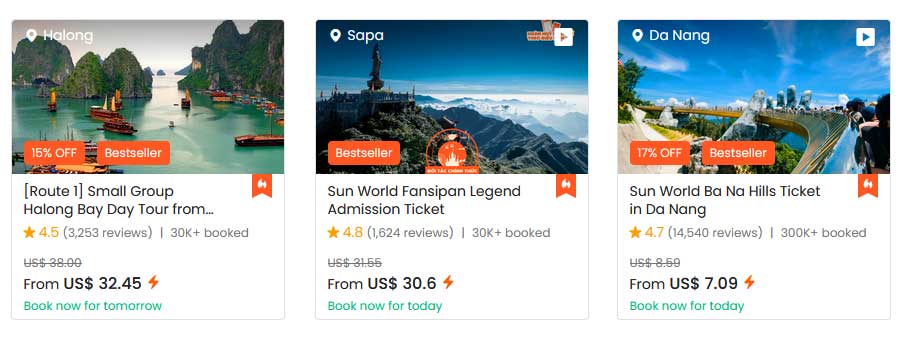
🎫 Book your train tickets in Vietnam online + Schedule:
Hanoi Airport to Ha Long | Hanoi Airport to Ninh Binh | Noi Bai Airport to Sapa | Singapore – Travel Guide | Prices in Singapore | Money in Singapore
Bus Travel in Vietnam ➔
How useful was this post?
Click on a star to rate it!
Average rating 4.9 / 5. Vote count: 15
No votes so far! Be the first to rate this post.

The Man in Seat 61
A beginner's guide to
Train travel in vietnam.
- Buy train tickets
- Buy ferry tickets
- Book a hotel
- Privacy & cookies
- Home
Train travel UK & Ireland...
Train travel in europe..., train travel in asia..., train travel in africa..., train travel in america..., train travel in australasia, train travel within vietnam.
- Southbound timetable, Hanoi to Saigon
- Northbound timetable, Saigon to Hanoi
- Fares
- How to buy tickets
- What are the trains like?
- Luggage, bikes & motorbikes on trains
- Video guide: Hanoi to Saigon by train
International travel to/from Vietnam
Why trains are the way to go.
Vietnam's air-conditioned trains are the best way for independent travellers to get around Vietnam. You might even meet some Vietnamese people! Inexperienced travellers think they'll save time using internal flights, but an overnight train from Hanoi to Hué or Danang actually saves time, because the train leaves Hanoi in the evening and arrives in Hué next morning, city centre to city centre. It saves a hotel bill too. But more than this, the train is a genuine Vietnamese experience, an integral part of your trip.
Air-conditioned trains link Hanoi, Hué, Danang, Nha Trang & Saigon (Ho Chi Minh City). The historic UNESCO-listed town of Hoi An is just 30 km by bus or taxi from Danang. There are also trains from Hanoi to Haiphong (for Halong Bay) and Hanoi to Lao Cai (for the hill resort at Sapa). See interactive route map of trains in Southeast Asia .
The view from the train
Rice fields, palm trees, water buffalo, Vietnamese towns and villages. You get a real insight into Vietnam when you travel by train which you don't get from 35,000 feet. If you people watch you'll get insights on board the train, too - the real Vietnam is as much inside as outside the train. The most magical part of a Hanoi to Saigon train journey is between Hué & Danang where the train runs along the South China Sea, snaking from cliff to jungle-covered cliff past beaches and islands, then heads through the lush green mountains via the Hai Van Pass to reach Danang. World class scenic! In Vietnamese it's Đèo Hải Vân meaning Ocean Cloud Pass , and I can't think of a better name. In the bright Vietnamese sun, the vivid blue skies, green waters and yellow beaches will take your breath away. See the video, Hanoi-Saigon by train .
Ho Chi Minh or Saigon?
Since the end of the Vietnamese war, the official name for the conurbation as a whole has been Ho Chi Minh City (HCMC). However, the city centre is still officially called Saigon , which is the city's traditional historic name. In fact, the city appears as Sai Gon in all Vietnamese railway timetables, it will say Sai Gon on your train ticket and as you can see from the photo, it actually says Sai Gon in big letters on the station itself. The ruling elite may toe the line and call it Ho Chi Minh, but everyone else calls it Saigon. So do what the locals do, call it Saigon!
Back to top
Useful country information
The reunification line.
Trains between Hanoi & Saigon are often referred to as the Reunification Express , although there are a range of trains on this route and no single train officially carries this title. The line was completed by the French in 1936 and trains linked Hanoi with Saigon until 1954, when Vietnam was divided into north and south. Trains resumed on 31 December 1976, unifying the country. You too can travel the length of Vietnam on the reunification railway, an experience in itself. Over the last decade the Hanoi-Saigon train service has steadily improved with more trains & newer more comfortable rolling stock. Here are the principal trains, there are additional trains at peak times such as the Tet holiday period .
Schematic map of Vietnamese Railways routes .
Interactive map of Hanoi-Saigon Reunification Railway
Interactive map of train, bus & ferry routes in SE Asia .
Quick links : Fares Ticket advice Buy tickets online What are the trains like? Recommended hotels
Timetable southbound 2024
Timetable northbound 2024, notes by train number.
These trains run every day, additional trains may run at busy periods. You can check these times using dsvn.vn .
Hanoi to Saigon is 1,726km or 1,070 miles. Map showing Saigon station . Map showing Hanoi station .
If a 5am arrival in Saigon or Hanoi seems early, remember that in Southeast Asia it's usual to rise early and you'll find plenty of taxis available at this time.
SE1, SE2, SE3, SE4: The best trains, with air-conditioned soft sleepers (4-berth), air-conditioned hard sleepers (6-berth), air-conditioned soft seats .
Trains SE3 & SE4 were equipped with smart refurbished cars in 2015, trains SE1 & SE2 got similar refurbished cars in 2016. Trains SE1 & SE2 also have a handful of VIP 2-berth compartments (only about 4 per train). SE1 & SE2 also convey privately-run Livitrans tourist sleepers between Hanoi, Hue & Danang. Trains SE3 & SE4 also convey privately-run Violette Trains tourist sleepers between Hanoi, Hue & Danang, see the Livitrans & Violette section below .
SE5, SE6, SE9, SE10: Air-conditioned soft sleepers (4-berth), air-conditioned hard sleepers (6-berth), air-conditioned soft seats , air-conditioned hard seats , ordinary hard seats . Trains SE5 & SE6 were re-equipped with some of the latest modern seats cars & sleeping-cars in 2018.
SE7, SE8: Only runs at busy times, check online if it's running a month or two ahead . Air -con soft sleepers , air-con hard sleepers , air-con soft seats .
SE19, SE20: Air-conditioned soft sleepers , air-conditioned hard sleepers , air-conditioned soft seats , air-conditioned hard seats , ordinary hard seats .
SE21, SE22: Air-conditioned soft sleepers , air-conditioned hard sleepers , air-conditioned soft seats , air-conditioned hard seats .
SE11, SE12, SE25, SE26: On certain dates you'll find additional seasonal trains. I have not shown them here.
SNT1, SNT2: Air-con soft sleepers (both older & newer types), air-con hard sleepers (both older & newer types), air-con soft seats. Ask for a 'chat luong cao' (newer higher quality) sleeper. Also has privately-run Golden Trains sleepers attached. If you use this train and get photos, please get in touch !
SPT1/2, PT3/4: Air-con soft seats, also has various sleepers.
Livitrans, Violette, Lotus Train tourist sleepers, Hanoi-Hué-Danang: Private company Violette Trains sells its own 4-berth soft sleepers on train SE1/SE2/SE3/SE4, private company Livitrans does the same on train SE3/SE4, private company Lotus Train doers so on SE19/SE20. These cost around twice the price of normal Vietnamese Railways soft sleepers, although they are identical to the regular sleepers with some free snacks and different colour blankets, see the photos, information & advice below .
Livitrans and Golden Trains tourist sleepers, Saigon-Nha Trang on trains SNT1 & SNT2, see the photo below . Private companies Livitrans and Golden Trains offer their own soft sleepers between Saigon & Nha Trang on trains SNT1 & SNT2. Fare $38 for a bed in a 4-berth sleeper, bookable at www.baolau.com or 12Go.Asia - look for the Golden Trains or Livitrans logo rather than VR logo in the search results.
How to get to Hoi An : See the Hoi An section
How much does it cost ?
Train fares in Vietnam are cheap, and sleeper trains save hotel bills and the cost of taxis to/from airports way outside the cities. The fares shown below are typical fares for the best carriages on the best trains, SE1, SE2, SE3 & SE4.
Fares vary by season, by train number (the less prestigious SE 5/6/7/8/21/22 are slightly cheaper) and by carriage type (fares for seats or berths in older car types are a bit cheaper). The old system of charging foreigners higher fares than Vietnamese citizens was abolished way back in 2002.
For Livitrans & Violette Trains tourist sleeper fares, see the Livitrans & Violette section .
Children aged 0 to 4 travel free, children 5 to 9 travel at 25% off. Children 10 and over pay full fare.
Fares are shown in 1000s of Vietnamese Dong. £1 = approx 30,000 Dong. $1 = 24,000 Dong.
Tickets & reservations
Do i need a reservation can i stop off.
Yes and yes. But you cannot buy an open ticket and hop on & off trains at random, as all trains require a reservation.
All tickets come printed with a specific date, train number, car number and reserved seat or berth number. So you need a separate ticket for each individual train journey you make. If you want to travel from Saigon to Hanoi (or vice versa) stopping off on the way, no problem, you simply need to book separate tickets for each stage of the journey, either bought in advance or bought at the station as you go.
Do I need to book in advance?
Booking opens 60 days before departure, and sometimes over 90 days before departure, at least for the end-to-end journey, for example Hanoi to Saigon on trains SE1 or SE3. Shorter segments - for example Hanoi to Hue or Nha Trang to Saigon on the SE1 or SE3 - open later, with the really short hops only opening a week or two ahead.
At peak holiday periods such as Tet (Vietnamese new year, in late January or February) you should pre-book as soon as booking opens, but at other times it's not usually difficult to buy tickets at the station a few days in advance if you're not fussy about the exact date, train or class. If you're booking for the same day or the following day, you might find the best quality SE trains full, but slower trains may have berths available, or perhaps you'll find the soft sleepers full, but hard sleepers available, so be prepared to be flexible. However, you're unlikely to get stuck as there's usually something available to your destination even at fairly short notice.
If it's mission-critical to be on a specific train on a certain date in a certain class, I recommend pre-booking tickets online through 12Go.Asia or www.baolau.com , as shown below .
Can I buy all 4 berths to have a compartment to ourselves?
Privacy-loving westerners often ask this - even though they'll happily sleep with 300 strangers on a long haul flight. Yes, you can pay for 4 tickets for sole occupancy of a 4-berth soft sleeper if you really want to, but you may need to politely but firmly repulse any attempt by other passengers to join you, or by staff to allocate passengers to your spare beds. My advice is don't bother, you'll be safe and comfortable sharing a 4-berth soft sleeper and might meet some Vietnamese people this way, rather than sitting in isolation.
Vietnamese Railways offer 2-berth 'VIP' compartments on train SE1 & SE2, but only two such compartments per train, and only on SE1 & SE2, so best forget it unless you're very lucky. The Livitrans & Violette Trains tourist sleepers offer 2-berth compartments, you could use those.
How to buy tickets online
Option 1, buy from 12go.asia.
12Go.Asia provides an excellent service for booking train tickets in Vietnam and other countries in Southeast Asia. They show real-time availability of seats & berths, booking confirmation is instant and international credit cards are accepted.
You can now click an option to choose exact seats or berths from a seating plan, to make sure you're all together in one compartment.
12go sells tickets for both regular Vietnamese Railways trains and many privately-run cars such as Livitrans, Violette, Fansipan, Orient Express and Golden Trains.
Bookings can only be made when Vietnamese Railways open reservations, usually 60 days ahead for longer distances such as Hanoi-Saigon, perhaps only a week or two for shorter hops such as Hue-Danang. So if the train you want is labelled unavailable come back later. Livitrans & Golden Trains reservations may open further ahead.
12Go.Asia charge the official Vietnamese Railways price plus around 60,000 dong ($2.70) service fee per ticket plus around 4% of the price (perhaps $3 per ticket for Hanoi-Hue, for example) for online credit card payment.
You will be emailed an e-ticket which you can either print out or keep on your phone to show when boarding the train. It's now really easy, as for regular Vietnamese Railways trains there is no need to collect tickets or have them sent anywhere, just show your e-ticket!
Children under 6 go free with no ticket required, unless you want to give them their own berth. Children under 10 get 25% off berth prices or 50% off seat prices. Children 10 & over pay full price.
If your bank card is rejected , don't assume it's 12go that's the problem. They accept all cards from all countries, but your own bank may be blocking a Vietnamese transaction, so call them.
By default, they'll put all your party together in the same compartment, except where that's not possible if for example there are only a handful of berths left on the train.
Option 2, buy from www.baolau.com
Train & bus booking agency www.baolau.com offers easy online booking in plain English with international credit cards accepted. The availability shown by Baolau is 'live' and seats are instantly confirmed. In most cases you simply print your own tickets. Feedback has been very positive, further feedback is always welcome .
Baolau's system now allows you to choose your exact seats or berths from a seating plan graphic. This works for all regular Vietnam Railways seats & sleepers although not for the privately-run sleepers.
Tip: To travel in a VIP 2-berth sleeper on train SE1 or SE2, first select 4-berth soft sleeper , then select berths in a 2-berth compartment on the berth plan graphic. There are only two such compartments on the train. The price will change to the 2-berth price after you proceed.
Baolau charge the official Vietnamese Railways price + 40,000 dong ($1.80) service fee per ticket + 2.7% of the price (perhaps $1.40 per ticket for Hanoi-Hue, for example) for online credit card payment.
You will be emailed an e-ticket which you can either print out or keep on your phone to show when boarding the train. It's now really easy, as for regular Vietnamese Railways trains there is no need to collect tickets or have them sent anywhere, just show your e-ticket.
Children under 6 free, aged 6 to 9 get 25% off berth prices, 50% off seat prices, 10 and over full price.
If your credit card is rejected , don't assume it's Baolau that's the problem. They accept all cards from all countries, but your own bank may be blocking a Vietnamese transaction so call them.
Private sleepers on key routes: As well as the regular Vietnamese Railways cars, Baolau also sells tickets for Violette & Livitrans on the Hanoi-Hue-Danang route, for Livitrans & Golden Trains on the Saigon-Nha Trang route, and for Fansipan, Orient Express, Sapaly, King Express & Chapa Express on the Hanoi-Lao Cai route.
Option 3, order from these agencies
You can also order tickets through one of these reliable Vietnamese train booking agencies, obviously with a small fee or mark-up for their service:
VietnamImpressive: www.vietnamimpressive.com are a reliable Hanoi-based agency which specialises in train bookings and has the Vietnamese Railways ticketing system installed in their offices. They get regular glowing reports from seat61 correspondents. Indeed, I have used them myself and seen their offices in Hanoi, and met their MD. They answer emails promptly and are very helpful.
International Rail Australia: If you live in Australia, New Zealand, Asia or Africa, you can order Vietnamese train tickets using the contact & booking form at www.internationalrail.com.au . This is a reliable Melbourne-based train specialist who can arrange tickets for you through their contacts in Vietnam. Book at least 7-10 days before travel to allow them to turn around your booking.
Option 4, buy from Vietnamese Railways
Vietnamese Railways launched online booking in 2014 at dsvn.vn (DSVN = Duong Sat Viet Nam = Vietnamese Railways). For English, click the UK flag top right. Until 2022 it only accepted Vietnamese-issued credit cards, but it should now accept overseas cards.
Tip: At the time I write this, DSVN are geo-blocking, it's crazy how many websites around the world now do this to reduce cyber attack risk. If it says access denied simply set your VPN to a Vietnamese IP address. Haven't got a VPN? What is a VPN and why you need one .
How to use dsvn.vn
Go to dsvn.vn , click the UK flag for English and use the journey planner in the usual way. In the search results, select a train, select a carriage with the class you want, and select an exact seat or berth and click to buy. Soft sleepers are shown as a side view with 4 beds (two upper, two lower) in each compartment, hard sleepers are also shown as a side view with 6 berths per compartment, upper middle & lower. Seats are shown as a top-down view with two-abreast seats either side of a centre aisle - it's obvious if you think about it. You may need to fake a Vietnamese mobile phone number with a +84 country code if it rejects your real one. If it doesn't accept your non-Vietnamese credit card, use 12go or Baolau instead, as explained above. .
Remember that the official Vietnamese Railways website is dsvn.vn : vietnamrailways.net, vietnam-railway.com, vietnamrailway.com are not Vietnamese Railways themselves but travel agencies pretending to be.
Option 5, let Railbookers arrange a tour
The easiest option, though not the cheapest, is to let a professional tour company such as Railbookers organise your hotels, trains, transfers and stopovers as a package. Railbookers offer several suggested tours of Vietnam including a journey from Hanoi to Saigon on the Reunification Railway with a stopover in Hoi An. These can be customised to your own requirements, I recommend asking them to add a stopover in Hue. As it's a package, they'll take care of you if for example anything disrupts one part of the trip. They have offices in the UK, USA & Australia.
How to buy tickets at the station
It's easy to buy train tickets at the station when you get to Vietnam. Trains are busy, but except at peak holiday times such as Tet , if you book a day or two ahead you'll usually find tickets available, even if your first choice of class or train is sold out. Reservations were computerised in 2002 and you can buy tickets for most train journeys in Vietnam at Saigon and Hanoi booking offices. So you can buy both a Saigon-Hue ticket and a Hue-Hanoi ticket in Saigon, for example. However, at other stations such as Hue, Danang or Nha Trang, you may only be able to book journeys starting at that station. At ticket offices, you pay in Vietnamese Dong, US dollars are not generally accepted, nor are non-Vietnamese credit cards.
Tip: If you have internet access such as hotel WiFi, see for yourself what trains & classes are available on the Vietnamese Railways website dsvn.vn . Then book online, selecting the option to collect tickets & pay at the station within 24 hours. This avoids long conversations at the ticket counter about what trains & classes remain available and hurried decisions about which to choose.
Buying tickets in Hanoi
At Hanoi main station on Le Duan Street, enter by the main central doors and turn right through a narrow passageway to the ticket office, see the photo bottom right. Go to the window marked Tourist .
Buying tickets in Saigon
At Saigon station, the smaller downstairs ticket office (shown below, centre picture) used to be for travel today, but now seems to handle advance bookings too. There is a larger ticket office is upstairs, but recent reports suggest this is now only handling booking changes and you may even find it closed. A numbered queuing system may be in operation, so look out for it. Press the button and take a ticket from the small box at the entrance to the ticket office, take a seat and watch the screens which will show you which counter to go to when your number comes up. Feedback on ticket purchase in Saigon is always appreciated!
Tip: If you don't mind a 50,000 dong ($2.50) fee per ticket, buying at the city centre ticket agency at 275C Pham Ngu Lao saves you going to the station. It's open 08:00-17:00 every day. It can be tricky to spot, see the photo below on the far right.
Luggage, bikes & motorbikes
You take your bags - of whatever size - onto the train with you and store them near your seat or berth, so you have access to them throughout the journey.
Bikes and even motorbikes can be transported on Vietnamese trains for a fee, although they don't necessarily on the same train as you. You take your bike or motorbike to the luggage office, pay the fee and hand it in. If it's a motorbike, the fuel tank must be drained and empty. They'll put a label on your bike and give you a receipt. You travel on the train as normal. At the other end you collect your bike from the station luggage office when it arrives, it usually travels on a separate train and it may take a day or two before it can be collected. Feedback appreciated .
What are Vietnamese trains like ?
Air-conditioned soft sleepers.
Most visitors to Vietnam choose soft sleeper if their journey involves overnight travel. Soft sleeper is a safe, pleasant and enjoyable way to go, especially on the best trains, SE1, SE2, SE3, SE4, SE5 & SE6 - although you should expect even newer cars to be a little tatty by western standards as they are intensively used.
Each soft sleeping-car has a corridor running down one side with seven 4-berth compartments opening off it, each of which can be securely locked from the inside. Each compartment has 4 berths, two upper and two lower. Each berth has an individual reading light and is supplied with pillow, sheet and duvet. By day you simply sit on the lower berths. You keep all your bags with you, there is luggage space beneath the bottom bunks and in the large recess above the compartment door.
The most modern cars used on trains SE1 to SE8 have a 2-pin power socket for recharging your mobile or camera, and you'll find a western-style toilet usually kept supplied with soap and toilet paper at one or both ends of the corridor. Several windows on the corridor side open which is useful for photography, but the compartment windows don't open. At night, there's a lock and usually an additional security catch on the door - flip out the security catch and the door can't be opened more than an inch or two even with a staff key.
There's a free water dispenser at the end of the corridor for both boiling and cold water, handy if you bring some powdered soup, instant coffee or hot chocolate with you, or buy some dried noodles from one of the stalls at the station. A trolley service comes down the train serving snacks, coffee, soft drinks and beer, and at meal times a member of the train staff will sell you a meal ticket for around 35,000 dong (£1 or $1.60). A set meal with mineral water will then be delivered to your compartment around half an hour later from the kitchen car.
See the section below about the Livitrans & Viollete tourist sleeping-cars attached to SE1 & SE2 between Hanoi, Hué & Danang.
Which trains have the best cars? Trains SE3 & SE4 received smartly-refurbished air-conditioned carriages branded '5-star' in January 2015, in red & blue with a broad white stripe. Trains SE1, SE2, SE5, SE6, SE7 & SE8 received similar refurbished cars in 2016. Though there is no sign of any WiFi as originally reported in the press. Newly-built '5-star' cars were delivered in 2017, in white with a thin red stripe & blue around the windows, these are now making their appearance on trains SE1 to SE6, see the photos below. Vietnam Railways charge a fraction more to travel in the nicer, newer cars.
2-berth VIP soft sleepers on trains SE1 & SE2: Soft sleepers usually have 4-berths per compartment, but since 2018 one of the most modern soft sleeper cars on trains SE1 & SE2 has two 2-berth VIP sleeper compartments, with two lower berths. The fare includes non-alcoholic drinks and meals, served in your compartment. The fare is round twice the price of normal 4-berth soft sleeper. However, with only 2 such compartments on the whole train (just 4 beds) you need to book early -and be very lucky - to get one.
Air-conditioned hard sleepers
If the soft sleepers are full, or if you're in a group of 5 or 6 people, there's no reason why you shouldn't travel hard sleeper, especially if it's an overnight journey such as Hanoi to Hue with relatively little daytime element so you'll spend most of the time in your berth. Hard sleeper compartments have 6 berths, lower, middle and top on each side, but apart from the extra two berths, the facilities are exactly the same as for soft sleepers in terms of power sockets, water dispenser, toilets, luggage space and meals.
Air-conditioned soft seats
These can be recommended for daytime journeys such as Hue to Danang or Hanoi to Vinh, but for overnight trips always book a soft or hard sleeper so you can sleep properly. In the most modern cars used on the SE-numbered trains, you'll find power sockets in the wall for charging mobiles or cameras.
Air-conditioned hard seats
These have wooden seats in modern air-conditioned cars. A bit hard on the rear for a long journey, but perfectly acceptable for a few hours.
Ordinary hard seats
Wooden seats in much older cars without air-con. However, these cars have windows that open, which can be an advantage for photography. The photos below show an ordinary hard seats car on train LC3 from Hanoi to Lao Cai, similar cars operate on trains LC4, TN1 & TN2.
Livitrans , Violette, Lotus Train
Several private companies sell their own 4-berth soft sleeper compartments on trains SE1/SE2/SE3/SE4/SE19 between Hanoi, Hue & Danang, aimed at foreign tourists. Livitrans offer soft sleepers on SE1/SE2 , Violette offer soft sleepers on SE1/SE2/SE3/SE4, Lotus Train on SE19/SE20.
You can book 4 places to have sole or dual occupancy on a whole 4-berth compartment if you like. All these companies are fine with very little to choose between them, as their prices, sleeper compartments and service are very similar.
How much does it cost?
These privately-run soft sleepers cost roughly double the price of normal Vietnamese Railways soft sleepers. Livitrans, Violette & Lotus Train charge similar prices.
Hanoi to Hue costs around US$75 one-way per person in a 4-berth air-conditioned soft sleeper.
Hanoi to Danang costs around US$85 one way per person in a 4-berth air-conditioned soft sleeper.
Is it worth paying double the price?
Not really. Originally, these private companies used special carriages painted in their their own colour scheme, fitted with an interior superior to the regular sleeping-cars which DSVN (Vietnamese Railways) used at the time. A few years ago, DSVN upgraded trains SE1/2/3/4 trains with comfortable modern sleeping-cars and it stopped these private companies using their own (older) cars. Livitrans, Violette & Lotus now rent out one or more 4-berth compartments in one of DSVN's regular sleeping-cars and resell these berths with some free snacks and different bedding at much higher prices. In high-season these companies might lease a whole car, on low-season departures the Violette accommodation can be as little as one 4-berth compartment within a standard DSVN sleeping-car full of Vietnamese travellers who are amused that a westerner has paid double to travel in an identical compartment in the same car, simply with purple blankets rather than brown ones and a few packets of free crisps. If all the regular DSVN sleepers have sold out, these more expensive tourist cars can be useful, but don't expect them to be vastly superior to the regular Vietnamese Railways soft sleepers, as they are the same.
How to buy tickets
You can book Livitrans, Violette & Lotus Train tickets online at www.baolau.com & 12Go.Asia , look for the Livitrans, Violette or Lotus logos in the search results.
The Man in Seat 61 says , :Livitrans, Violette & Lotus Train now use exactly the same '5-star' air-conditioned soft sleepers that Vietnamese Railways (DSVN) themselves use on the SE1/2/3/4 trains, just compare the photos below with the photo of a refurbished regular DSVN soft sleeper above . On some departures, it's not even a separate sleeping-car, just one or more 4-berth compartments in a standard DSVN sleeping-car occupied by normal Vietnamese travellers, with literally the only difference to justify the extra cost being the colour of the blankets and a few free snacks."
Golden Trains, Saigon to Nha Trang
The privately-run Golden Trains sleeping-car is a cut above the regular Vietnamese railways sleepers between Saigon (HCMC) and the beach resorts of Nha Trang. It runs attached to the regular SNT1/SNT2 overnight train, see the timetable above . It is similar to the Livitrans & Violette 4-berth sleepers shown above.
How to buy tickets: You can buy Golden Trains tickets at www.baolau.com or 12Go.Asia - look for the Golden Trains logo rather than the VR logo in the search results.
Video : Hanoi to Saigon by train
This 9-minute video shows the 1,079 mile journey from Hanoi to Hue, Danang & Saigon on trains SE1 and SE3, showing the scenery, the food, the Livitrans sleeper from Hanoi to Danang and the regular DSVN soft sleeper from Danang to Saigon. The video was made before the SE1 & SE3 were re-equipped with the smartly-refurbished cars in 2015-2016.
Getting to Hoi An
Hoi An is a historic UNESCO-listed town featuring on most visitor's itineraries, see en.wikipedia.org/wiki/Hội_An .
Hoi An is 30 km south of Danang, but has no station of its own. See location map . To reach it, first take a train to Danang, see the Reunification Line section above ,
Then take a taxi or minivan from Danang to Hoi An taking 30-45 minutes. There are several options:
Option 1, pre-book a minivan or taxi from Danang city centre to Hoi An at 12Go.Asia . Shared minivans from USD 3 upwards, taxis from USD 15 upwards.
Option 2, take a taxi from Danang station to Hoi An, this costs around 350,000 dong (USD 15) depending on your negotiation skills. There are always taxis waiting.
Option 3, local bus 01 used to link Danang and Hoi An before the pandemic, but it was then diverted away from the city centre and has not so far resumed. But for the record in case it resumes, here is the original pre-pandemic information: Bus 01 runs (or rather, ran) every 20 minutes between 05:00 & 17:30 every day, fare 20,000 dong + 10,000 dong for bags over 10Kg. To take the bus, leave Danang station, cross the square and go into Hoang Hoa Tham road. At the next intersection, turn left into Le Duan street. The bus stop will be on your right, ignore the old bus stop next to house number 299, it is currently (temporarily?) moved to outside the shop at number 151 Le Duan street, indicated by a blue bus sign ( See location map ). Bus number 1 is coloured yellow & runs to Hoi An every 20-30 minutes. Board through the back door and take a seat. The conductor will come through to collect your fare. Have a 20,000 dong note handy (or 30,000 if you've luggage) as he won’t give change - the official price in May 2017 is 20,000 dong. Smile and ignore any further requests for money as there is no difference in ticket price for locals and tourists - it's just 20,000 dong + 10,000 dong for a bag over 10Kg! The bus reaches Hoi An bus station in about 1 hour, you can walk the remaining 2 km to Hoi An town centre. Further feedback always appreciated .
Hanoi to Lao Cai & Sapa
Sapa is a hill station established by the French in 1922, and its beautiful scenery and colourful local tribal people make it popular with overseas visitors. The best way to get there is by overnight train from Hanoi to Lao Cai, then transfer by bus, car or taxi the final 38 km (24 miles) to Sapa. There are 2 or 3 overnight sleeper trains between Hanoi & Lao Cai, you can book a regular Vietnamese Railways soft or hard sleeper or choose from a wide range of privately-run tourist sleeping-cars of a higher standard. The line from Hanoi to Lao Cai was built by the French and opened in 1910 as part of the metre-gauge Vietnam to Kunming railway. The Lao Cai to Kunming section was destroyed landslides in 2002, but onward train travel from Lao Cai to Kunming is possible again on a new standard-gauge railway opened in 2014, see the Hanoi to Kunming section below . Hanoi to Lao Cai is 296 km (185 miles). The timetables below are compiled from the timetables on Vietnamese Railways websites dsvn.vn & www.gahanoi.com.vn (in Vietnamese only). Click here for a Vietnamese Railways route map .
Train timetable
Here are the fares are for the regular Vietnam Railways carriages. For the privately-run tourist sleeping-cars, see the next section .
£1 = approx 30,000 Dong. $1 = 24,000 Dong
Children aged 0 to 4 travel free, children 5 to 9 get 25% off. Children 10 & over pay full fare.
Upper berths cost slightly less than lower berths, but for simplicity only one price per class is shown above.
Which station in Hanoi?
Buy tickets online at 12Go.Asia or www.baolau.com .
These are two reliable train & bus booking agencies, see the section above . You usually print your own ticket.
12Go.Asia or www.baolau.com sell tickets for the regular Vietnamese Railways sleepers and also for the privately-run sleeping-cars operated by Fansipan, Orient Express, Sapaly (three of the best companies, see below ), King Express, Chapa Express.
www.baolau.com lets you select your exact seats or berths from a plan showing which seats & berths are available, so you can make sure you're all in the same compartment together. This feature works for Vietnamese Railways seats & sleepers (but not the privately-run sleepers) as long as you book more than 72 hours ahead.
Buying at the station
You can buy tickets at the station when you get to Vietnam, assuming you want tickets for the regular Vietnamese Railways seats or sleepers, not tickets for the high-quality tourist sleepers . Tickets to Lao Cai can be bought either at Hanoi's main station ticket office (easiest to reach), or at the 'B' station on the far side of the tracks which has its own ticket office.
Apart from peak holiday periods such as Tet (Vietnamese new year, in late January or early February), it's not difficult to book a soft sleeper a few days in advance or even on the day, especially if you can be flexible on your choice of departure date. On weekdays you may find berths available even the day before, at weekends berths can be harder to get as that's when the locals travel.
At ticket offices, you pay in Vietnamese Dong. If you're sure of your itinerary and it's important to be on a specific train on a specific date, then pre-book with 12Go.Asia or www.baolau.com .
Traveller Rob Damen travelled from Hanoi to Lao Cai and back: "We just went to Hanoi station 2½ hours before departure and had no problem buying tickets. We bought them at the small ticket window in the waiting area, for the price stated on the boards at the station. Our train arrived about 45 minutes before departure so we had plenty of time to get comfy in our beds. Back from Lao Cai to Hanoi we took the daytime train [this no longer operates] and we were able to arrange soft seats. In order to get the correct tickets I used your shortlist of Vietnamese words and made a note that I gave to the lady at the ticket window. She looked a bit surprised but she got the message so we got two soft seats for 168,000 dong each. The ride took 11 hours which was quite long and we had a lot of young children in the coach so it was rather noisy. The views from the train are not spectacular but that was ok, as we passed time playing games like yahtzee and some card games. We arrived right on time at Hanoi Station.
Traveller Jens Kupsch travelled on the daytime LC4 train: "We crossed the border from China around 07:30, and bought tickets to Hanoi at Lao Cai station about an hour ahead of departure. It didn't seem to be a problem."
Arranging a transfer from Lao Cai to Sapa
The train to lao cai & sapa in pictures, hanoi to sapa by tourist sleeping-car.
In addition to the regular Vietnamese Railways (Duong Sat Viet Nam = DSVN) sleepers & seats, overnight trains SP1/2/3/4 between Hanoi & Lao Cai convey a bewildering range of privately-run sleeping-cars aimed at tourists. Before forking out $33 for a bed in a privately-run sleeper rather than $16 for a bed in a regular Vietnamese Railways air-con soft sleeper, read the advice below.
All these private operators offer berths in shared 4-berth air-con soft sleeper compartments, some also offer berths in 2-berth air-con soft sleeper compartments, basically a 4-berth with the two upper berths unused, for more or less double the price. If the allocation of 2-berth compartments has sold out you can pay for all 4 berths in a 4-berth, the price is pretty much the same.
The privately-run sleepers all have air-conditioning, fresh clean bedding, complimentary mineral water and (in some cases) snacks, and clean western-style toilets. These private sleepers are all very comfortable, just remember that this is still Vietnam with Vietnamese standards, you'll enjoy the trip more if you don't turn up with unrealistic expectations of 5-star western-style luxury for $33!
Is paying for a privately-run sleeper worth it?
Until about 2015, the various private sleeping-cars had remodelled interiors a cut above the regular Vietnamese Railways (DSVN) soft sleepers, and some were nicer than others. For example, many had smartly wood-panelled interiors instead of the dated formica in DSVN's own sleepers. And the private cars were all painted in the operator's own colours and branding, which made for a colourful train.
But in 2015 DSVN replaced its own cars with more modern air-conditioned sleeping-cars and revoked the operating licences for the private operators' older cars. The private operators had to lease the new type of DSVN sleeping-car, with interiors exactly the same as those now used by DSVN themselves, see the photos below. And the private car exteriors are now the same red white & blue as DSVN's own cars. No more private branding, other than a sticker in the window stating who operates the car.
So has that sunk in? If you pay $33 for a bed in a privately-run sleeper, you get exactly the same type of compartment with exactly the same décor as if you had paid $16 to travel in a regular Vietnamese Railways soft sleeper.
So what's the difference? The private cars are staffed by the operator's own staff. There's usually a vase of flowers on the table, and some small complimentary bottles of water. Bedding is provided by the operator, so may be branded and maybe a bit better than the regular bedding in the DSVN cars. Of course, you'll end up travelling with other western tourists rather than actual Vietnamese people, which you may consider an advantage or disadvantage depending on your point of view. And the private cars may be kept slightly cleaner than the regular cars.
To quote one recent traveller , "I had a good look at both the SP3 & SP1. The tourist cars were easily identified because of the vase of plastic flowers and the complimentary bottles of water. But for all of them, everything else was identical to the VR [=DSVN] soft sleeper cars – cabin, bunks, sheets, pillows, etc."
Can I buy all 4 berths in a compartment to have a room to ourselves? Yes, if you insist, if the very few compartments allocated for 2-berth occupancy are sold out as they often are. But meeting fellow tourists and talking over a beer into the night is great fun. Would I recommend paying double to miss all the fun and sit in glorious isolation? No!
Video : Hanoi to Lao Cai by Orient Express
Note that this shows the earlier wood-panelled incarnation of the Orient Express, before the introduction of the new standard sleeping-cars across all private operators as well as Vietnamese Railways themselves. But it gives you a good idea of the trip.
Phan Thiet & Miu Ne
The seaside resort of Phan Thiet is at the end of a 15 km branch line from Binh Thuan, a junction station on the main Saigon-Danang-Hue-Hanoi Reunification line, formerly known as Muong Man. One or two direct trains run from Saigon to Phan Thiet, shown in the timetable below. When you arrive at Phan Thiet station you'll find plenty of buses & taxis waiting to take you to the popular resort of Mui Né, 24 km northeast of Phan Thiet, a 25-30 minute drive. Alternatively, you can take any mainline train from Saigon to Binh Thuan station and then a taxi to Pan Thiet (15.7 km) or Mui Né (38 km). See Phan Thiet & Mui Ne map . See Vietnam train route map .
* Train SPT3/SPT4 only runs on key holiday dates, check if it's running on a given date using www.baolau.com .
Train SPT1/SPT2 runs every day, with these classes:
- air-con soft seats in a regular car with 64 seats, shown as NML or A64LV at www.dsvn.vn or when booking on www.baolau.com .
- air-con soft seats in a VIP car with only 48 seats, shown as NML48 or A48LV at www.dsvn.vn or when booking on www.baolau.com .
- air-con soft sleeper used in day mode.
Bus or taxi connection Phan Thiet station to Mui Né: Bus number 9 (the red bus) runs from the road outside Phan Thiet station to Mui Né every 20 minutes from 05:30 until 20:00, bus fare 6,000 dong ($0.30) The bus runs the length of Mui Né stopping at various points all across the resort. Alternatively, there are plenty of taxis, it's a 25-35 minute drive and will cost in the region of 230,000 dong ($12)
How to buy tickets: Buy tickets at the station or at Saigon's city centre ticket office as shown here or book online at www.baolau.com . If Baolau won't show the direct train, try booking online at the Vietnamese Railways site www.dsvn.vn , it may work or may reject your credit card, give it a go.
Alternative: If the times of these direct trains don't suit you, simply take any mainline train between Saigon & Bin Thuan shown in the main Reunification line timetable above for around 170,000 dong (£6 or $8), then catch a taxi between Bin Thuan & Phan Thiet (15.7 km) or Mui Ne (38 km), cost to Mui Ne around 500,000 dong (£15 or $24), taxi journey around 1 hour. You can book a Saigon to Phan Thiet train+taxi journey at www.baolau.com .
Traveller Andrew Stewart took the train from Phan Thiet back to Saigon and comments : "It was a nice trip. Much better than the bus that I took to get there. So many roadworks on that road. It took 8hrs and 30mins from Saigon on the bus."
Hanoi, Hue or Danang to/from Phan Thiet or Mui Né
Simply take a train from Hanoi, Hue or Danang to Binh Thuan station as shown in the timetable above . Then use a local taxi between Bin Thuan station and Phan Thiet (15.7km) or Mui Ne (38km). A taxi between Bin Thuan and Mui Ne costs around 500,000 dong (£15 or $24) and takes around an hour.

Hanoi to Haiphong & Cat Ba
Trains link Hanoi with Haiphong, for ferries to Cat Ba island. See route map .
All t hese Hanoi-Haiphong trains have air-conditioned soft seats. Hanoi to Haiphong is 102 km (63 miles).
Hanoi Long Bien station is 3 km northeast of Hanoi main station, immediately south of the huge steel Long Bien bridge over the Red River (which was a target for American bombers on several occasions during the Vietnamese war). The small road outside the station is only accessible to pedestrians, bicycles and motorbikes, not cars, so if your taxi drops you on the main road by the river, don't worry, it's just a 100m walk up the side road and round the bend to the station. Map of Hanoi showing main & Long Bien stations .
Hanoi's 'Train Street' : These trains pass through Hanoi's famous train street between Hanoi main station & Long Bien.
How to buy tickets: You can book online at www.baolau.com or 12Go.Asia . Or buy at the station.
Ferries to Cat Ba Island: There are various ferries from Haiphong to Cat Ba island. You can book one of up to 6 departures per day at www.baolau.com . This starts with a bus transfer from 41 Ben Bính, Minh Khai, Hong Bang in Haiphong which is 1.5 km 18-minute walk from Haiphong station, see walking route .
Hanoi's train street
Northern train street : You may hear of a narrow street in Hanoi where trains squeeze through and street life magically makes way, while intrepid tourists sit in trackside cafes and take photos. There have been occasional accidents and at times the street has been closed off with warning signs - you'll have to check whether it's currently open or not. But of course you can always see it safely by train! The street is between Hanoi main station and Hanoi's Long Bien station on the railway from Hanoi to Haiphong. So you'll pass through this street if you take any train to or from Haiphong that starts/terminates at Hanoi main station, or you could simply take a train one stop between Hanoi main station and Long Bien station, see the timetable above . Map of Hanoi showing location of both 'train streets' .
Southern train street : There is also a less touristy, less well-know 'train street' to the south of Hanoi station, on the reunification line from Hanoi to Saigon. All trains between Hanoi and all points south pass through this train street 1 minute after leaving or 1 minute before arriving at Hanoi main station. You'll also find a selection of trackside cafes here. Map of Hanoi showing stations & location of both 'train streets' .
Hanoi to Halong Bay by train
The beautiful Halong Bay is on many visitors' lists of Vietnam highlights to visit. There are two ways to travel there from Hanoi:
Option 1, take a train from Hanoi to Haiphong as shown above , then use local buses between Haiphong and Halong.
Option 2, a direct train runs between Hanoi and Halong as shown below. This is a regular Vietnamese Railways train, not a tourist train, although there have been abortive attempts to run a tourist train between Hanoi & Halong in the last few years. This loss-making regular train was reported in the Vietnamese media as slated for withdrawal in December 2013, but it's still in operation, a rustic 4-carriage train used by the locals and an experience! Feedback would be appreciated.
* UPDATE 2024: This train has not resumed post-pandemic.
Yen Vien station is in the suburbs of Hanoi, you'll need a taxi given the early start from Hanoi, although buses 10 or 54 run there from Long Bien bus station during the day. Map showing location of Yen Vien station .
Fare: 70,000 dong (£2.50, $3), hard class seats only.
How to buy tickets: You can easily check these times & buy tickets online in English at reliable ticketing agency www.baolau.com .
Feedback would be appreciated!
Traveller Matthias Meuller report (December 2016): "The train runs! It was one of my best trips ever. It's a train for women who buy fruits, vegetables, tomatoes, herbs, chicken and so on cheap in the mountains and sell it on at a little market in Halong. They take the goods by train from Mao Khe to Halong. No tourists there! You sit for two hours in the market and they want that you eat, drink, hold their babies. It's wonderful, yet none of the travel agencies in Hanoi want to believe that this train exists. I rode back to Hanoi with the train. It takes 6 hours but it's wonderful, slung in a hammock, talking with the girls from the market, who count their money and play cards. Buses link central Hanoi with Yen Vien station every 10 minutes."
Traveller Graham Phelan reports (October 2016): "I took this train in October as I love train travel and didn’t want to take the tourist bus to Halong City - I would do anything to avoid tourists! I took a taxi in the morning to Yen Vien station from my place in Hanoi, it wasn’t expensive just 166,000 VND (about €7) and cheaper if you’re leaving from Hanoi Old Town. I was absolutely wrecked getting the morning train so I missed a lot of the landscapes on the way to Halong City but I enjoyed them on the way back! People have to be aware that this train is not a comfortable train, you have to sit on a wooden seat! So make sure you bring some entertainment, a small cushion if you can find one, some toilet roll and most importantly food! This trip showed me the real Vietnam and it was a massive culture shock but I don’t regret it at all. Also make sure to get your hotel or wherever you’re staying to book a taxi for you at the station as there are absolutely none there. On arrival back into Hanoi buses do run to go to the main city bus station, the cost is 7,000 VND, about €0.25. Or you can just do as I did and find a taxi on the street since they’re so cheap."
Traveller Ferry Quast reports (September 2016): "Yes, the Hanoi-Halong train is running. It consists of 4 standard-gauge cars. These cars are some of the oldest I've ever taken. One had bench seats, the other 3 were empty and aimed at passengers with loads of vegetables and fruit [see the photo below]. For the first 2-3 hours the train was quite busy, but for the rest of the trip we were almost alone on the train. It was very slow and we think that we never had more than 25 or 30 km/h. Great experience if you want to get in touch with locals. In contrast to the train, Ha Long's train station was the newest I've seen in Vietnam. Reaching downtown Hanoi after arrival in Hanoi Vien Yen station shouldn't be a problem, there are still buses - until 10pm or so as locals told us."
Beijing & Nanning to Hanoi by train
There is a safe, comfortable & affordable overnight sleeper train between Beijing & Nanning every day, connecting with an equally safe & comfortable daily sleeper train between Nanning, Guilin & Beijing. Twice a week, these two trains convey a direct soft sleeping-car between Hanoi & Beijing. You can also use the Hanoi-Nanning sleeper train in conjunction with Nanning-Shanghai or Nanning-Guangzhou (for Hong Kong) trains. After a brief spell in early 2015 reduced to twice a week, the Hanoi-Nanning train went back to running every day, and Beijing-Hanoi through cars have been restored, twice a week.
U pdate 2024: International trains between China & Vietnam remain suspended post-pandemic.
Beijing - Nanning train Z5/Z6 runs every day in each direction, taking 1 night.
Nanning - Hanoi train T8701/T8702 runs every day in each direction, taking 1 night.
A through sleeping-car with 36 soft sleeper berths runs direct between Beijing & Hanoi leaving Beijing West on Thursdays & Sundays and leaving Hanoi on Tuesdays & Fridays, taking 2 nights. It's attached to the Z5 then T8701 southbound, the T8702 & Z6 northbound.
So you can travel between Beijing and Hanoi any day of the week with a change of train at Nanning using two separate tickets OR you can travel between Beijing and Hanoi in a direct soft sleeper twice a week with just one ticket.
At the time I write this, e-visas aren't valid for entering or leaving Vietnam by train via Dong Dang (only for arriving or leaving at Dong Dang by road), so you either need a regular visa or use the 15-day visa exemption if available for your nationality.
Beijing to Hanoi is 2,996 km or 1,861 miles. Nanning to Hanoi is 396km. How to buy tickets .
Gia Lam station is 6km from Hanoi's main station, across the river. Map of Hanoi showing Gia Lam station .
Southbound fares
(1) Beijing to Nanning costs RMB 752 ($124 or £80) in a soft sleeper or RMB 473 ($78 or £50) in a hard sleeper, bought at the station or online with small extra fee from www.chinahighlights.com/china-trains .
(2) Nanning to Hanoi costs RMB 248 (£28 or $38) in a soft sleeper bought at the station or $35 + booking fee if you pre-book from outside China through agency www.chinahighlights.com/china-trains .
(3) Beijing to Hanoi using the direct twice-a-week sleeping-car costs $336 bought from www.chinahighlights.com/china-trains .
Northbound fares
(1) Hanoi to Nanning costs around CHF 31.53 = 750,000 dong (£22 or $36) in a soft sleeper.
(2) Nanning to Beijing costs RMB 752 ($124 or £80) in a soft sleeper or RMB 473 ($78 or £50) in a hard sleeper using a domestic Chinese ticket.
(3) An international through ticket from Hanoi to Beijing costs CHF 293 (about $294) converted into dong, in a soft sleeper.
To buy southbound tickets from China to Hanoi
To buy tickets from Beijing, Guilin or Nanning to Hanoi in advance from outside China, you can book online from reliable ticketing agencies www.baolau.com or www.chinahighlights.com/china-trains . On Chinahighlights you'll find Hanoi listed under 'G' as Gia Lam, Hanoi .
On days when the direct through car runs Beijing to Hanoi you can book Beijing to Gia Lam, Hanoi as one ticket. If you want to travel on the other 5 days of the week, simply book Beijing to Nanning on train Z5 then buy another separate ticket from Nanning to Gia Lam, Hanoi on train T8701.
What's the journey like?
The daily Z-category sleeper train between Beijing & Nanning has air-conditioned 4-berth soft sleepers, air-conditioned hard sleepers and a restaurant car serving freshly-cooked Chinese dishes. It passes through some excellent scenery in southern China. Exterior photo courtesy of Nandakumar Narasimhan, interior & scenery photos courtesy of Chris "Mzungu" Holden.
The sleeper train between Nanning & Hanoi
Hanoi gia lam station.
Gia Lam station ( see location map ) is a tiny suburban station across the river in northern Hanoi, a 20 minute taxi ride from the main station. Why does the train to Nanning start here? Its Chinese carriages are standard gauge 4' 8½", as used in Europe, China & North America. Vietnam's railways are metre gauge, just over 3'. A third rail has been laid as far as Gia Lam station, making the tracks dual gauge, allowing the Chinese train to run that far but no further. You can see the three rails in the photo above.
Buying your ticket to Nanning, Guilin or Beijing : At Hanoi main ('A') station on Le Duan street, go to the ticket counter for foreigners & international trains, open 07:00-17:30 daily. You will need to show your passport and a valid visa for China. You can pay in Vietnamese dong or (reportedly) US dollars. Credit cards are not accepted, even though there's a MasterCard sign.
Alternatively, tickets are also sold by Vietnam Hanoi Railways Tourist Company (Travel Agency - 152 Le Duan Street, Hanoi, email [email protected] or call (84-4) 3518-6782. Again, you'll need to show your passport and Chinese visa to buy a ticket.
If you're going to Nanning, it can help to know that Nanning is 'Nam Ninh' in Vietnamese.
Incidentally, Vietnamese Railways cannot book domestic trains within China, so don't bother asking for onward tickets from Nanning to Shanghai or Guangzhou or wherever.
Getting a Chinese visa in Hanoi
You'll need a visa to enter China, and indeed you will need to show your Chinese visa at Hanoi station when buying a train ticket to Beijing. In 2010 it was reported that the Chinese embassy in Hanoi wouldn't issue visas for anyone who wasn't a Vietnamese citizen or resident but in 2012 a later report says they now will. If they won't, either get your visa in your home country before you leave, or arrange your Chinese visa in Hanoi through a suitable travel agency such as www.hanoibackpackershostel.com .
Traveller Peter Day reports : Tickets (soft class only) are available from Window 7 at Hanoi main railway station. There is a system in place where you get a number which indicates your place in the line - locals ignore it, you should too. Tickets are available to purchase in cash only, Vietnamese dong only as far as one could tell. You go to the window first and the lady tells you how much, then you go get the cash and return to buy the tickets. The cost of two tickets to Guilin was over 6 million dong, clearly Beijing would be more - getting that amount of dong out of ATMs is problematic because of limits on each transaction and number of daily withdrawals allowed. We had to use 2 cards. They check you have visas for China.
Traveller Alex Hartland reports : "I booked my Hanoi-Beijing train ticket yesterday at Hanoi station. I was sent from window 10 to window 1 to window 6 and finally window 8. The woman at window 8 spoke pretty good English, but I don't think it's the standard window for Hanoi to Beijing bookings. The paperwork took a while to process (about 45 minutes) and the final cost was 4,635,000 dong. She told me I could pay in dollars if I wanted to, but again not sure if this is standard procedure. She checked my passport & Chinese visa, too."
Buying tickets in Beijing
You can't buy an international ticket to Hanoi at any Beijing station, or at normal ticket outlets either. But here's how you can buy in person in Beijing. If you have any further feedback, please email me !
Traveller Laurent Fintoni reports : "I was told to go to Bei Feng Wo Lu (a street near Beijing West station) and look for a shop opposite the Tian You hotel. So I would say for anyone else, the easiest might be to get a cab or directions to Tian You hotel on Bei Feng Wo Lu. Opposite the hotel is what looks like a travel agent, though when I went it had the shutters pulled down - however it was open, not quite sure why that was. The shop sign is blue, and you can tell you found it as there is a small window on the side of the shop's main doors which says they sell train tickets. However, you want the main shop not the window. Once in there if you tell them you want to buy Beijing to Hanoi tickets, I had a sentence written in Chinese for me, she pulls out what seems to be the same form that Que Clothier mentions. The woman speaks no English, just point at the answers on the form and she does it all for you. I was charged only 1086 RMB without a 50 RMB charge, but not quite sure why as she answered in Chinese when I asked her if she wanted the charge. Her form mentions the charge, making the price 1166, the same as Chris Emmerson reported. She'll also point at a calendar and ask for dates as well as how many tickets. There are about 3 banks within 100 to 200 metres of the shop on Bei Feng Wo Lu, all do currency exchange and have ATMs however none seem to change Travellers Cheques so be careful. Once you pay her it's all done, it was really easy, the trickiest part is finding the shop, but with the Tian You Hotel being quite big (and having its name written in English on the front in big letters) it shouldn't be too difficult."
Traveller Chris "Mzungu" Holden reports (2011): "I got my tickets from the same place as Laurent Fintoni [ see above ] got his. It was easy to find, took me about 30mins to get the tickets from a helpful and friendly chap who spoke no English but pointed to the booking forms and a calendar when needed. It cost me RMB 2,200 (2150+50 commission) from memory."
Buying tickets in Nanning
Tickets are sold at the station reservations office at Nanning main station, counter 16, but according to one recent report now counter 1. It's not difficult to get places even on the day.
Travellers reports
Traveller Richard Brown travelled Nanning to Hanoi: "We have just arrived in Ha Noi this morning, 30 December 2014. Several agents online offer booking services but most sources we could speak to told us the Nanning-Hanoi tickets must be booked in Nanning. I am not sure that is the case but you definitely have to go to the train station to pick them up as they are not the typical Chinese train tickets. They issued one ticket for the two of us. Tickets are printed on multi-carbon paper using an antique pin-printer.
We can confirm that at Nanning main station, counter 1 is currently the one where you get the Ha Noi tickets. It is also labelled "English Speaking Counter" but the clerk could not speak English; she did get another clerk with reasonable English skills and, despite our Mandarin deficit, things went smoothly. At least at this time of the year, I believe you could get tickets on the day of travel. We booked our tickets on Saturday around 6:00pm for the Monday train. They offered us tickets for the next day and there were probably berths available on Saturday but they close sales for same day tickets at around 4:00pm.
On Monday the train included several carriages with seats numbered 1-15 and then a separate string at the end numbered confusingly 4-1. The end string were the sleeper cars. Only one of these carriages had passengers so I suspect there were plenty of empty berths. The sleeper carriages were the only ones that made the trip to Ha Noi from Pingxiang at the border. The attendant in our carriage was selling water and the ubiquitous cups of dried noodles. Boiling water was of course free.
We arrived at Pingxiang at 10:00pm and the English announcement said we would be there for an hour and 40 minutes. Immigration and customs was routine. We all re-entered the carriage after about 20 minutes and waited. One or two passengers joined us from Pingxiang. After about two hours we were off to Dong Dang. After 20 minutes we arrived in Vietnam. Clearing immigration and customs took about 45 minutes. Even though it was literally the middle of the night a woman was changing US$ or RMB to VND and selling sim cards and snacks. The exchange seemed fair.
The train left Dong Dang and made no further stops until reaching Ha Noi. I believe that the station we arrived was different than your site currently reports . I almost certain that we arrived at Ga Yen Vien Nam; our taxi ride took about 20 minutes and we paid 300,000 VND. We knew were getting ripped off as we were told the "meter not working" story but we had few options at 6:00am local time. The roughly US$15 fare should have been about US$7 but we arrived unscathed.
One thing we learned in China is to expect the unexpected. None of what happened to us may happen tomorrow so anyone reading this should not take it as the gospel truth. But we found reading what others had experienced better prepared us for what came our way."
Traveller Steve Mercer reports from a northbound trip in 2013: "This train was by far the best of them all. There was carpet in the corridor & compartments. Plus there were free plastic shoes, although 5 sizes too small. Very handy. The taxi dropped us off at the station but I have to admit it’s not immediately apparent where you go to check in or wait. We went into the first waiting room, but a guard frantically shouted 'Nanning' at us and pointed at the correct waiting room. Boarding the train was very organised. We showed our passports before getting on and we also gave the Guard our tickets which he swapped for a credit card size card. We would give this back at the end of the journey. He then showed us to our berths. It was a good trip with no interruptions apart from the borders. Just before the Vietnam border we were woken and told we must take all our bags with us. This border point was a bit disorganised. When you put your bag on the scanner belt it was set up so you had to turn around and fight your way through the crowd behind you to get to the other side of the scanner. Then you hand your passport in. It’s not a quick process as I was waiting for it to be handed back when he looked up and gestured us to go and sit down. I’m always a bit reluctant to let my passport out of my sight, but it was all good. They did them in batches and then called your name out to come and get them. However as we were the only Western foreigners there, he came and handed them to us. It was then back on the train and off to the Chinese border. This time someone came round and handed out the immigration cards for us to fill in than came round again to collect them and our passports. We got off with all our bags and went into the immigration hall. A bit more organised this one. I can’t remember but I’m not sure if they were scanned. An immigration officer did some random checking of the bags though. It was back on the train and wait for our passports to be returned before heading off to Nanning. There were no more interruptions."
Traveller Melissa Jacka reports from a southbound trip in 2013: "Tickets for the Nanning-Hanoi train were only available from Nanning train station, we got them about 20 hours in advance and following the advice on Seat 61 we went straight to counter 16 - the queue took about 20 minutes, and we had to show our passports and Vietnamese visa. We had no problem getting soft sleeper tickets for a Sunday night train. Adults were 190 RMB and the kids were 90 RMB. As mentioned in earlier advice the beds were reallocated by the conductors. Dinner in the dining car was simple, but fresh, tasty, clean and cheep - rice, chicken dish & beer for one was 30 RMB. The train now leaves at 18:20 and arrives at around 05:30 the next day (but this includes winding the clock back 1 hour at the border), and includes two stops where you and your luggage get off the train, the first at about 21:30 and the second at about 00:30."
Nanning - Hanoi by bus
If the train is full or you prefer daytime travel, there are several daily buses between Nanning & Hanoi, using modern coaches and travelling by day. Buses reportedly leave Nanning bus station at 08:30. 09:00 & 09:30, journey time 7-8 hours, fare around RMB 150 (£15 or $25). The scenery is reported as well worth the trip!
Hong Kong to Hanoi by train
It's easy to travel between Hanoi & Hong Kong by train with a change of train in Nanning & Guangzhou. You can choose to make the journey in 2 nights & 1 day using the Hanoi-Nanning sleeper train and a Nanning-Guangzhou sleeper train, with a day exploring Nanning in between. Or you can make the whole trip in under 24 hours using the Hanoi-Nanning sleeper train then a 300km/h high-speed train to Guangzhou and another high-speed train to Hong Kong. It costs as little as $86 or so in total one-way, and it's a genuine overland travel experience. Remember that you'll need a visa for China, so you'll need to satisfy any return/onward ticket requirements, which is usually more of a logistical headache than the actual travelling. If you have any more information including fares for travelling via this route, please e-mail me .
Covid-19 update : Travel to China remains restricted, international trains are suspended.
Hanoi ► Hong Kong classic option
The fare is around VND 568,000 ($30) with a comfy soft sleeper berth.
There are several possible trains all running every day: Train K1234 leaving Nanning at 17:50 and arriving Guangzhou main station at 07:25 next morning, train K398 leaving Nanning at 19:15 and arriving Guangzhou main station at 07:48, and train K1206 leaving Nanning at 22:50 and arriving at Guangzhou East station at 11:46 next day. All these trains have soft & hard class sleepers.
The fare is about 285 RMB ($47) in a soft sleeper, or 184 RMB ($30) in a hard sleeper.
Hanoi ► Hong Kong high-speed option
Fare around VND 568,000 ($30) with a comfy soft sleeper berth.
Hong Kong ► Hanoi classic option
The fare is about 285 RMB ($47) in a soft sleeper, or 185 RMB ($30) in a hard sleeper.
Hong Kong ► Hanoi high-speed option
To buy tickets starting in Hanoi, in advance over the internet
Step 1, arrange your Hanoi to Nanning ticket through either www.baolau.com or www.chinahighlights.com/china-trains , both are reputable agencies . You can collect tickets from their offices in Hanoi, or have them delivered to your hotel in Vietnam.
Step 2, book the Nanning to Guangzhou train online using either www.baolau.com , www.china-diy-travel.com or www.chinahighlights.com/china-trains . You collect tickets from the ticket office at Nanning station. Booking opens 60 days before departure.
Step 3, book from Guangzhou to Hong Kong West Kowloon as a second transaction at www.baolau.com or www.china-diy-travel.com with ticket collection at either Nanning or Guangzhou South stations, obviously it makes sense to pick up your Nanning-Guangzhou and Guangzhou-HK tickets together in Nanning.
Arranging tickets this way means you have the necessary proof of entry & exit to apply for a Chinese visa.
To buy tickets starting in Hanoi, in person
You can easily buy a Hanoi to Nanning ticket at the international booking counter at Hanoi main station on Le Duan street, reported as open 07:00-17:30 daily. You'll almost always find places available, even on the day of departure. It can help to know that for Nanning is 'Nam Ninh' in Vietnamese. Alternatively, tickets are also sold in Hanoi by Vietnam Hanoi Railways Tourist Company (Travel Agency - 152 Le Duan Street, Hanoi, email [email protected] or call (84-4) 3518-6782.
You'll need to show your passport and Chinese visa when buying tickets , so arrange your Chinese visa first. It's easiest to get a visa in your home country before you leave, but you can also get a visa in Hanoi. It was reported back in 2010 that the Chinese embassy in Hanoi wouldn't issue visas for anyone who wasn't a Vietnamese citizen or resident, but since 2012 they apparently now will. If they won't, you can still arrange a Chinese visa in Hanoi through a suitable travel agency such as www.hanoibackpackershostel.com . Remember you will need to comply with any entry/onward ticket requirements when applying for a Chinese visa.
You can buy an onward ticket from Nanning to Guangzhou and Guangzhou to Hong Kong when you get to Nanning station, or you can arrange the Nanning to Guangzhou ticket online with reliable Chinese train ticket agency www.china-diy-travel.com and collect the ticket at the station in Nanning.
To buy tickets starting in Hong Kong, in advance over the internet
Step 1, arrange your Nanning to Hanoi train ticket, through agencies www.baolau.com or www.chinahighlights.com/china-trains . Pre-booking overcomes the annoying requirement for an onward ticket when applying for your Chinese visa.
Step 2, now book your train from Guangzhou to Nanning online at www.baolau.com or www.chinahighlights.com/china-trains or www.china-diy-travel.com . Booking opens 60 days before departure and you can collect tickets at Guangzhou South station.
Step 3, now book your train from Hong Kong West Kowloon to Guangzhou at www.baolau.com or www.chinahighlights.com/china-trains or www.china-diy-travel.com and collect tickets at the station. Or if using the slower intercity through trains from Hung Hom (Hong Kong) to Guangzhou East, book online at www.it3.mtr.com.hk .
To buy tickets starting in Hong Kong, in person
You can buy Hong Kong to Guangzhou and Guangzhou to Nanning tickets at the China railway office at Hung Hom railway station. They may be able to do the Nanning to Hanoi ticket, but if not, buy it when you get to Nanning.
Alternatively, you can buy tickets from Hong Kong to Guangzhou, Guangzhou to Nanning and (if they can do it) the Nanning to Hanoi at the CTS (China Travel Service) Central branch or CTS Mongkok branch in Hong Kong, as these two branches are equipped with the Chinese Railways ticketing system. Again, if they cannot do the Nanning to Hanoi train, buy this when you get to Nanning at the station.
The Nanning to Hanoi train can easily be booked at Nanning station reservations office counter 16, though a more recent report says counter 1. You'll usually find places available even on the day of travel.
Chinese visas
You'll need a Chinese visa to cross China between Hong Kong and Hanoi, either a transit visa or tourist visa. The requirements vary depending on your nationality and where you apply for the visa, but you'll often have to prove you have a ticket into and out of China. This can be a pain when you can only buy train tickets close to departure, or you plan to buy as you go, at the station on the day. It can also lead to a 'Catch 22' if you plan to buy train tickets in Hanoi and need to show the visa to get the train tickets. One way round this is to use a local Hong Kong or Vietnamese travel agency to sort all your tickets, using the agency's booking confirmation to get the visa, even though the agency can't get the tickets themselves until close to departure time. The ultimate fall-back is that old favourite, buy the cheapest refundable airline ticket into & out of China, make a free-cancellation hotel booking for all of the nights you plan to be in China using a hotel site such as booking.com, use these to get your visa (which won't specify entry points or itinerary) then cancel everything.
What are the trains like?
Travellers' reports.
Traveller Hendryk went from Hong Kong to Hanoi: "At the Hung Hom station in Hong Kong there's now a china-railway-office where you can book the tickets to Guangzhou East (190 HKD) and onwards to Nanning for between 268 HKD and 298 HKD, soft sleeper for the next day or later (same day was fully booked). They charge a service fee of 200 HKD for that. We took the 11:28 train to Guangzhou East and the 15:43 sleeper train to Nanning, it also departs from Guangzhou East, so no changing station necessary. We arrived in Nanning at 7:07am. We almost overslept, but a good sign to get off is when the stewards change your placeholder cards back to your ticket. In Nanning as said above, it was very crowded in the train station, maybe because of that weekend. At the counter number 16 (you should ask that before at the train info - no English signing anywhere) we had to wait for more than an hour but we got the soft sleeper tickets to Hanoi Gia Lam for 1.10.2012, departing 18:20, for 215 RMB each. [2012]
Kunming to Hanoi by train
Until 2002 a twice-weekly metre-gauge sleeper train linked Kunming in China with Hanoi, but floods and landslides damaged the Chinese part of the line and it was discontinued. However, a brand new standard-gauge Kunming-Hekou railway line was completed and in December 2014 trains ran once more between Kunming and the border town of Hekou. It's possible once again to travel between Kunming and Hanoi by train, safely, comfortably and affordably, using a Chinese train from Kunming to the Chinese border town of Hekou, then a taxi a few km to the border post, walking across the border and on to Lao Cai station in Vietnam for a Vietnamese sleeper train to Hanoi. Here's how.
U pdate 2024 : International trains between China & Vietnam remain suspended post-pandemic.
Kunming ► Hanoi
Step 1, travel from Kunming to Hekou North (= Hekoubei) by train. There are several trains a day, for example the K9832 leaving Kunming at 09:29 arriving Hekou North at 15:53, and the K9822 leaving Kunming at 16:00 and arriving Hekou North at 21:44. The fare is 70.5 RMB ($11) for a regular hard seat (comfortable enough) or RMB 182 ($30) with a seat in a soft sleeper. There's even an overnight train with hard sleepers, departing 22:48 arriving 06:07. You can check times & fares (and if you don't mind a few dollars booking fee, buy tickets) at www.chinahighlights.com/china-trains .
Step 2, transfer from Hekou North station in China to Lai Cai station in Vietnam: Either take a bus the several kilometres from Hekou North station to the Hekou border point for RMB 2, journey time 10-15 minutes, or take a taxi for around RMB 10-15, there will be plenty of taxis waiting at the station. Walk across the border to the Vietnamese side (border controls can take up to an hour) then walk another 25 minutes or take a 5-minute taxi ride into Lao Cai, just 2.5km (1.5 miles) from the border post. There are hotels in both Hekou and Lao Cai if you need them.
You may want to visit the pleasant hill station at Sapa for a day or two before going on to Hanoi, Sapa is just 40km from Lao Cai by taxi, bus or minibus, see details here .
Step 3, travel from Lao Cai to Hanoi by overnight sleeper train, see the train times & fares above . There are several sleeper trains every night, some with cheap DSVN (Vietnamese Railways) soft & hard sleepers and others with a variety of comfortable privately-run soft sleeping-cars with 2 & 4-berth compartments aimed at tourists.
If you use this route using the new trains, feedback & any photos would be much appreciated .
Hanoi ► Kunming
Step 1, travel from Hanoi to Lao Cai by overnight sleeper train, see the train times & fares above . There are cheap DSVN (Vietnamese Railways) soft & hard sleepers and a variety of comfortable privately-run soft sleeping-cars with 2 & 4-berth compartments aimed at tourists. You may want visit the pleasant hill station of Sapa for a day or two before going on into China, Sapa is 40km from Lai Cai by taxi, bus or minibus.
Step 2, transfer from Lao Cai station to Hekou. Lao Cai is just 2.5 km (1.5 miles) from the Chinese border. You can walk (25 minutes) or take a taxi (5 minutes) from Lai Cai station to the border post and walk across into Hekou on the Chinese side. Passing through both sets of customs takes about an hour. In Hekou, the Hekou North (=Hekoubei) station is a few kilometres away. You take a taxi for around RMB 10-15.
Step 3, travel from Hekou to Kunming by train. There are several trains a day, for example you should easily make the K9694 leaving Hekou North station (= Hekoubei) at 16:16 arriving Kunming at 22:29. The fare is 70.5 RMB ($11) for a regular hard seat (comfortable enough) or RMB 182 ($30) with a seat in a soft sleeper. There's even a sleeper train to Kunming with hard sleepers, leaving Hekoubei at 23:20. You can check times & fares (and if you don't mind a few dollars booking fee, buy tickets) at www.chinahighlights.com/china-trains .
For photos of the Hanoi to Lao Cai trains, see the section above . Photos below courtesy of Jan Bockaert .
Traveller's reports
Traveller Jan Bockaert travelled from Hanoi to Kunming by train in December 2014: "Two days ago, I took the train from Hanoi to Kunming in China over the new line from Hekoubei to Kunming. The trip went exactly as described on your site.
Lonely Planet has some warnings about the border crossing from Lao Cai to Hekou. But it went butter smooth, very friendly and professional at both sides of the border. It took me about half an hour, an hour and a half if you factor in the time difference between China and Vietnam.
Hekou North [Hekoubei] station is quite far from the city centre, in the middle of nowhere. You can get a taxi from the border post to the station for 20 yuan, but the first driver I took asked 40. (about 5 euro) None of the drivers wanted to use the meter.
The station building isn’t finished yet. You can’t leave your luggage yet, and there is no shop in the station, although there was a small stand in front of the station. Part of the station crew was also still in training. The ticket office was open from 5:30 till 6:20 from 9:00 till 11:00 and from 14:30 till 16:30. The woman selling me the ticket spoke decent English.
I booked a hard seat at around 10 in the morning, and by the time we left, the compartment was fully booked. Most of the wagons seemed to be sleepers however.
The first part of the line goes (literally) trough some very spectacular mountains, i guess the first hour or so, about 80 percent of the trip went trough tunnels. The view on the other 20 percent of the line is very nice. Once you are out of the mountains, it gets dark quickly.
Europe to Vietnam by Trans-Siberian Railway
If you have the time (we're talking around two weeks), you can travel from London to Vietnam by train.
Step 1, London to Moscow by train . There are daily departures via Brussels, Berlin & Warsaw. The journey takes 2 nights, from around £250 one-way with sleeper.
Update 2024: Trains to Russia are suspended due to Covid-19 and now sanctions .
Spend at least 1 night in Moscow.
Step 2, Moscow to Beijing by Trans-Siberian Railway . Two direct trains every week all year round, 6 nights. Fares from around £500 one-way with a bed in a 4-bed sleeper.
Update 2024: Moscow-Beijing trains remain suspended post-pandemic.
Spend at least 1 night in Beijing.
Step 3, Beijing to Hanoi by train . There are two direct trains a week, 2 nights, about $320 or £220 one-way in soft sleeper. Alternatively, there are daily trains with a change in Nanning. Spend at least 1 night in Hanoi.
Update 2024: Trains between China & Vietnam remain suspended post-pandemic.
How to plan & book this trip
There aren't any travel agencies who can arrange the whole trip, so you will need to plan it out and arrange each stage of the journey yourself. It's an exercise in project management! Unless time is no object, you should book the key sections in advance through various travel agencies.
Book London-Moscow as shown on the London to Russia page .
Book Moscow-Beijing through a local Russian agency such as Real Russia, as shown on the Trans-Siberian page .
Book Beijing to Hanoi as shown above .
You'll need to pre-arrange visas for Belarus, Russia, possibly Mongolia, China & Vietnam, and in many ways complying with the various visa requirements (which sometimes require confirmed onward tickets to be held) is actually the biggest challenge, not buying the tickets, so check this out carefully using the relevant embassy websites.
Where do you start? First, read through the seat61 pages linked above. Then sketch out your itinerary using a simple spreadsheet like this , deciding where and for how long you want to stop off. Next, check out the visa situation for each country. Finally, follow the advice on each seat61 page to buy tickets for each train journey that you want to pre-book.
Buy at Amazon.co.uk or Amazon.com
Alternatively, you can download just the chapters or areas you need in .PDF format from the Lonely Planet Website , from around £2.99 or US$4.95 a chapter.
Hotels in Vietnam
In saigon: continental hotel.
The famous and historic Continental Hotel is one of my favourite hotels worldwide, not merely a place to stay but a Saigon landmark since 1880. Indeed, the Continental is the backdrop for much of the action in Graham Greene's novel 'The Quiet American', set in Saigon during the Franco-Vietnamese war. If it's in your price range or if you can stretch your budget, the Continental is superbly located, right next to the Opera House in the centre of Saigon and a stone's throw from Saigon's distinctive town hall, post office and cathedral. It's quiet, understated, clean and comfortable with high ceilings, marble floors and wood panelling, and not a corporate clone like so many chain hotels. The breakfast buffet is good, and it has a pleasant central courtyard and bar if you prefer to eat or enjoy a beer al fresco. There's free WiFi, too. A double room costs around $140 (£88) per night. Tripadvisor reviews . Nearby, the famous Rex Hotel was where many American officers stayed during the Vietnam war. If you prefer something more glitzy and glamorous, try the impressive Majestic Hotel , a mere parvenu dating from 1925 with many art nouveau features, located across the road from the Mekong river.
In Hanoi: Budget: Hanoi Trendy Hotel . Top end: Sofitel Metropole
A little budget gem, the Hanoi Trendy Hotel & Spa (formerly the Hanoi Art Hotel) may not be historic or grand, but it's an excellent low-cost choice from $45 a night for a room with toilet & shower, tea & coffee making facilities, free WiFi, safe, free mineral water, a great breakfast, and great staff at reception who really put themselves out to help you. It's well located in central Hanoi, a short walk from the War Remnants Museum, a 10-15 minute taxi ride from Hanoi's main station. Of course, at the luxury end of the scale we have Hanoi's most venerable and upmarket hotel, the luxurious and expensive Sofitel Metropole , which comes complete with outdoor swimming pool and lido bar.
In Hué: Budget Than Thien Hotel , top end La Residence Hotel & Spa .
At the top end, look no further than La Residence Hotel & Spa , located in the former French governor's residence on the banks of the Perfume River. For the budget-conscious, try the equally central Than Thien Hotel . Both get great reviews.
In Sapa: Victoria Hotel
The best hotel in Sapa, now renamed BB Resort & Spa, which even runs its own train from Hanoi, see the section here . You'll find a real log fire burning in the lobby and restaurant, and they do an excellent breakfast buffet. The hotel features an indoor swimming pool and adjacent spa, too. If your budget can stretch, this is the place to stay!
You might also want to check Tripadvisor's recommendations: Tripadvisor Vietnam hotels .
Flights to Vietnam
Overland travel by train & bus around Vietnam is an essential part of the experience, so once there, don't cheat and fly, stay on the ground! But if a long-haul flight is unavoidable to reach Vietnam in the first place, check Opodo and also try the Skyscanner search tool to compare flight prices & routes worldwide across 600 airlines.
1) Check flight prices at Opodo, www.opodo.com
2) use skyscanner to compare flight prices & routes worldwide across 600 airlines.

3) Lounge passes
Make the airport experience a little more bearable with a VIP lounge pass, it's not as expensive as you think! See www.loungepass.com
Travel insurance & other tips
Always take out travel insurance.
Never travel overseas without travel insurance from a reliable insurer, with at least £1m or preferably £5m medical cover. It should also cover cancellation and loss of cash and belongings, up to a sensible limit. An annual multi-trip policy is usually cheaper than several single-trip policies even for just 2 or 3 trips a year, I have an annual policy with Staysure.co.uk myself. Here are some suggested insurers. Seat61 gets a small commission if you buy through these links.
Get an eSIM with mobile data package
Don't rely on WiFi, download an eSIM with a mobile data package for the country you're visiting and stay connected. Most newer mobile phones can download a virtual SIM card so you don't need to buy a physical SIM, including iPhone 11 & later, see device compatibility list . Maya.net is a reliable eSIM data retailer with a 4.5 out of 5 Trustpilot rating and a range of packages including unlimited data .
Get a Curve card for foreign travel
Most banks give you a poor exchange rate, then add a foreign transaction fee on top. A Curve MasterCard means no foreign transaction fees and gives you the mid-market exchange rate, at least up to a certain limit, £500 per month at time of writing. The money you spend on your Curve card goes straight onto one of your existing debit or credit cards.
How it works: 1. Download the Curve app for iPhone or Android . 2. Enter your details & they'll send you a Curve MasterCard - they send to the UK and most European addresses. 3. Link your existing credit & debit cards to the app, you can link up to two cards with the free version of Curve, I link my normal debit card and my normal credit card. 4. Now use the Curve MasterCard to buy things online or in person or take cash from ATMs, exactly like a normal MasterCard. Curve does the currency conversion and puts the balance in your own currency onto whichever debit or credit card is currently selected in the Curve app. You can even change your mind about which card it goes onto, within 14 days of the transaction.
I have a Curve Blue card myself, it means I can buy a coffee on a foreign station on a card without being stung by fees and lousy exchange rates, just by tapping the Curve card on their card reader. The money goes through Curve to my normal debit card and is taken directly from my account (in fact I have the Curve card set up as payment card on Apple Pay on my iPhone, so can double-click my phone, let it do Face ID then tap the reader with the phone - even easier than digging a card out). I get a little commission if you sign up to Curve, but I recommend it here because I think it's great. See details, download the app and get a Curve card , they'll give you £5 cashback through that link.
Get a VPN for safe browsing. W hy you need a VPN
When you're travelling you often use free WiFi in public places which may not be secure. A VPN encrypts your connection so it's always secure, even on unsecured WiFi. It also means you can select the geographic location of the IP address you browse with, to get around geoblocking which a surprising number of websites apply. See VPNs & why you need one explained . ExpressVPN is a best buy with a 4.7 out of 5 Trustpilot ranking which I use myself - I've signed up as an ExpressVPN affiliate, and if you go with expressvpn.com using the links on this page, you should see a special deal, 3 months free with an annual subscription. I get a small commission to help support this site.
Carry an Anker powerbank
Tickets, reservations, vaccination records and Interrail or Eurail passes are often held digitally on your mobile phone, so it's vital to keep it charged. I always carry an Anker powerbank which can recharge my phone several times over if I can't get to a power outlet. Buy from Amazon.co.uk or from Buy from Amazon.com .
Back to home page

- TRAVEL BLOG
- Vietnam 5 days
- Vietnam 7 days
- Vietnam 10 days
- Vietnam 2 weeks
- Vietnam 3 weeks
- Hiking & Trekking Tours
- Vietnam Beach Holidays
- Vietnam Family Tours
- North Vietnam Tours
- Vietnam and Cambodia Tours
- Vietnam Cambodia Laos Tours
- Vietnam Thailand Tours
- Vietnam Cambodia Thailand Tours
- Vietnam Cambodia Laos Thailand Tours
- Vietnam travel guide
- Essential Travel Advice
- Best activities
- Best destinations
- Vietnamese culture
- Thailand 10 days
- Thailand 2 weeks
- Thailand 3 weeks
- Northern Thailand Tours
- Thailand Family Holidays
- Thailand Vietnam Tours
- Thailand travel guide
- Thailand visa
- How to get to Thailand ?
- Best time to visit
- Cambodia 5 days
- Cambodia 7 days
- Cambodia 10 days
- Cambodia 2 weeks
- Cambodia and Thailand Tours
- Cambodia travel guide
- Cambodia visa
- How to get to Cambodia ?
- Laos 5 days
- Laos 2 weeks
- Laos 7 days
- Laos, Vietnam, Cambodia and Thailand tour
- Laos and Cambodia Tours
- Laos travel guide
- How to get to Laos ?
- Our travel agency Our testimonials Meet us Sales terms Our activities

- Travel Blog
- Vietnam Travel Blog
Train Travel Vietnam: Complete Guide and Routes in 2024
If your travel experiences have been confined to buses and airplanes, you're missing out on one of the most enchanting ways to explore the world: the train. Not only increasingly budget-friendly, but a scenic train journey can even feel like a vacation in itself. If you're planning a trip to Vietnam, this guide will provide you with everything you need to know about train travel in Vietnam and will help answer all your questions.

1. Focus on Vietnamese railways
2. why choose a vietnam train trip, 3. the most beautiful train journeys in vietnam, 4. how to choose your seat on a train in vietnam, 5. how to book your train ticket.
A true colonial heritage, the Vietnamese railway system was introduced to Vietnam at the time of French domination. Construction of the North-South railway began in 1899 and took more than 30 years to complete. On October 2, 1936, the entire 1726 km Hanoi – Saigon line was officially put into service. It was and remains today the only railway line connecting Hanoi and Saigon . Unfortunately, during the war years in the 20th century, fighting against occupying foreign forces with relentless bombing by the Americans almost marked the end of the railway.
.jpg)
Rebuilding the crumbling network quickly became a priority after the country's reunification in 1975. The heavily damaged and war-torn North-South line was restored and returned to service in 1976 . It was then renamed “Reunification Express” as a symbol of Vietnamese unity.
Vietnam train map
The “Reunification Express” line is operated by Vietnam Railways (VNR), a Vietnamese state company. With a length of 2600 km, the Vietnam train serves almost all cities and provinces in Vietnam, including many cultural and tourist destinations from north to south. Find the train map in Vietnam here:
.jpg)
Before traveling by train in Vietnam, it is important to note that Vietnamese rail is not as modern and developed as that in your country. With a speed of 50 to 60km/h , it will take you more than 30 hours to travel from Hanoi to Saigon.
Some lines are even nicknamed “Vietnam TGV” , the humorous tone of which can be understood in the sense of “Great Vibration Train”. This results from metric railways, namely narrow tracks with a gauge of 1m kept since the colonial period, which are now becoming out of date. But then, is the Vietnam train really worth trying? What are the assets that make up its picturesque reputation today?
In the modern world, speed is often more valued, but this is not always the case in travel. Sometimes the best way to get the most out of a travel experience is to...slow down a little. Sit back, relax and enjoy the beautiful scenery through the wagon window. Thus, the trip becomes a moment of relaxation rather than a stressful journey between home and the destination.
.jpg)
All the splendor of the trip lies in its incredible landscapes. Many railway lines cross mountains, forests, valleys which offer incredibly breathtaking and charming panoramas . The train even travels on paths where other means of transport cannot go. You will therefore have an up-close and personal view of the hidden parts of Vietnam which are exclusively accessible to you. In addition, its fairly slow speed allows you to enjoy the spectacular view outside while taking photos or videos to remember the unforgettable moments you spent during your Vietnam train trip.
.jpg)
Therefore, this is the reason why the train is still a popular and highly demanded option for many travelers, although the interprovincial bus system and especially domestic flights have been significantly improved in recent years. On the other hand, the affordable price is another reason to choose the railway for traveling. Compared to the price of flights, train tickets are much cheaper, costing around half or a third less than the price of a plane ticket, depending on the route.
And finally, great security is also an advantage of this means of transport. The railway system in Vietnam has recently been significantly rebuilt and developed to accommodate new innovations in the railway industry worldwide. Thus, security conditions are much better than before. Additionally, the train in Vietnam is not a fast means of transportation and there is only one train running on a railway, so the accident rate for the train is tiny.

3.1 Hanoi Sapa night train
Sapa is a hill station in Lao Cai province established by the French in 1922. The line from Hanoi to Lao Cai was built by the French and opened in 1910 as part of the Vietnam-Kunming meter gauge railway. The stunning scenery and colorful local tribes of misty Sapa make it a popular stop on many visitors' itineraries. If you want to save a night on accommodation, one of the best ways to get there is to take the Hanoi Sapa night train . There are 2 sleeper trains between Hanoi and Sapa each day.
SP1 and SP2: This train offers private sleeping cars for tourists, served by companies such as Fansipan, Livitrans, Orient Express and The Pumpkin Express.
SP3 and SP4: Much of this train consists of private sleeping cars, including Sapaly, Chapa, Laman and Victoria Express. The latter is one of the most luxurious trains on the Hanoi – Sapa route, accommodating 40 passengers with luxury cabins, bar and restaurant.
3.2 Train Hanoi Hue
The Imperial City of Hue is an attractive destination in Vietnam to discover its historical and cultural heritage, pristine beaches, beautiful landscapes and unique cuisine. The Hanoi Hue train can take around 14 hours and costs from $36 to $80 . Every day, there are 5 trains serving this line including Vietnam Railways night or day trains and luxury tourist train companies such as Livitrans (SE3 and SE4), Laman (SE19), Lotus (SE19 and SE20) and Violette (SE1 and SE3). The latter companies generally offer the Hanoi Hue night train with high-end services.
.jpg)
3.3 Train Saigon Nha Trang
Being known as one of the best seaside resorts in Vietnam, the coastal city of Nha Trang is undoubtedly a must-see stop when passing through the central region. It is accessible from Saigon by a train journey of 8 to 9 hours . There are 6 trains per day on this line, which are operated by Vietnam Railways and Livitrans (SNT1 and SNT2). The ticket price varies between $30 to $40 .
3.4 Trains like no other
Rack railway in dalat.
It is known that the romantic city of Dalat is home to the most beautiful train station in Vietnam with Art Deco style in its architectural structure and its striking resemblance to Deauville train station. But few people know that it once had one of the rarest cog railways in the world . This is a railway track system with a third central toothed rail between the running rails. This rail engages with a toothed wheel under the locomotive, providing traction for the very steep slopes between Dalat and Thap Cham (of Ninh Thuan province) while preventing the train from sliding too quickly when descending.
This railway line, with a length of 84 km , was one of the rarest railways in the world because at the time there were only two tracks of this type, one in Dalat and the other in Switzerland. : the Jungfraujoch route. The steam locomotives used were manufactured in Switzerland and were among the most modern in the world.
.jpg)
However, the rack railway became obsolete after the Reunification of the country in 1975 because the track was almost destroyed during the war. The line was then gradually dismantled and its infrastructure was used to repair the heavily damaged north-south Reunification line. At the same time, the old steam locomotives, meanwhile, began their return to their homeland in 1990 and were then restored to their former glory on the Furka rack railway in the Alps. Today, a small section of the rack railway and a steam locomotive are still on display in Dalat Station. From there, a 7km line connecting Dalat – Trai Mat , but with the regular track, is put into service for tourists.
.jpg)
Luxury train “Indochina” Danang – Quy Nhon
Welcoming passengers from July 1 , 2020 , the new The Vietage train line connecting Danang Station and Dieu Tri Station (Quy Nhon) is remarkable because of its interior decoration whose design is not without recall the context of old Indochinese films. The cabin is decorated with wooden floors, combined with traditional yellow rattan seats.
The Vietage train departs from Danang Station every morning for a 6-hour journey to Quy Nhon and returns to Danang every evening. Designed for maximum passenger comfort and privacy, in addition to 12 seats, Vietage also offers a range of services such as restaurants, bars and relaxing massages.
.jpg)
There are four main categories of Vietnam train tickets:
- Hard seat : Mainly used for day trips, this is the cheapest and least comfortable ticket type.
- Soft seat : mainly used for day trips, these seats are more comfortable and more expensive than hard seats
- Hard berth : used for the Vietnam night train, it has three levels of beds (six per compartment). Prices vary depending on the level of the berth (the ones closest to the top are the cheapest). These compartments do not have a door.
- Soft sleeper : used for the Vietnam night train, it has two levels of beds (four per compartment). All bunk beds are charged the same rate.
Some private companies such as Victoria Express, Orient Express, Livitrans, Violette, Laman and several others rent compartments from Vietnam Railways then better equip them, provide services and resell tickets to tourists. These companies offer private sleeping cars with superior quality berths intended for tourists. They also provide private compartments of 2 soft berths. The Vietnam sleeper train has air conditioning, clean beds, free mineral water and (in some cases) snacks and clean Western-style toilets.
If you are looking for an unforgettable adventure in the north of Vietnam, you should check out our Top 8 Best North Vietnam Tours ! And if love trekking, check out Top 10 Best Vietnam Trekking & Hiking Tours !!
.jpg)
If you want to buy a train ticket online , go to the official website of Vietnam Railways: dsvn.vn In the search results, select a train, select a carriage with the desired class and click to buy. You may need to fill out a Vietnamese cell phone number with a country code. And it definitely won't accept your non-Vietnamese credit card.
If this seems too complex for you, it is easy to buy Vietnam train tickets directly at the station when you arrive in Vietnam. However, trains are always busy, especially during rush hours, holidays like Tet, and holidays. It is therefore recommended to book your ticket a few days in advance.
Alternatively, you can travel with a local travel agency in Vietnam who will take care of your reservations and transfers to and from the station.
.jpg)
There you have it, you have a general overview of Vietnam rail transport, we hope that this practical information will help you in organizing your future Vietnam train trip, which will prove to be unusual and unforgettable.

Sources: dsvn.vn , momo.vn
>>> Related Articles:
- Quang Phu Cau Incense Village and Vietnamese Worship Culture
- Train Street in Hanoi: Complete Guide by Locals 2024
- Guardians of Time: A Journey Through the Vietnamese Zodiac
- Mai Chau travel guide: 7 questions about the beautiful northern valley
- Travel Diaries
- Thailand Travel Blog
- Cambodia Travel Blog
- Laos Travel Blog

10 Days, 10 Colors: A Journey from South to North Vietnam
In this 10-day journey through Vietnam from south to north, experience the vibrant diversity of the country as you travel from the bustling streets of Ho Chi Minh City to the serene waters of Halong Bay. Explore the lush landscapes of the Mekong Delta, the charming ancient town of Hoi An, the historic capital of Hanoi, and the picturesque scenery of Ninh Binh. Each destination has been carefully selected to capture the essence of Vietnam's unique and iconic landscapes, ensuring you make the most of your exploration time and create unforgettable memories.
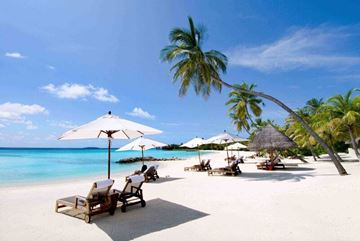
2-Week Coastal Getaway in Vietnam from Halong to Phu Quoc Island
Are you planning a 2-week trip to Vietnam, with a relaxing seaside stay at the end of your journey? Look no further! This highly recommended itinerary covers the country from the enchanting Ha Long Bay in the North to the serene island of Phu Quoc in the far South. Begin your adventure by exploring the wonders of Ha Long aboard a traditional junk and conclude your trip with a tranquil seaside retreat.
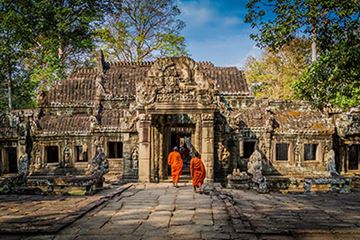
Glimpse of Cambodia Vietnam and Laos Tour in 2 Weeks
Begin an extraordinary adventure through Indochina with our Vietnam Cambodia Laos 2 weeks tour, where you'll have 15 days to discover the cultural and natural wonders honored and safeguarded by UNESCO. This immersive journey will lead you from the breathtaking landscapes of Halong Bay to the rich historical heritage of Hue, and from the awe-inspiring marvels of Angkor to the soulful heart of Laos, Luang Prabang. Our wide array of excursions will offer you an authentic and profound insight into these precious gems of Southeast Asia. Embark on this Vietnam Cambodia Laos 2 weeks tour for an unforgettable experience.

20 Fascinating Days in Vietnam, Cambodia and Thailand
When mentioning Southeast Asia, we cannot fail to mention the 3 most prominent and visited countries, which are Vietnam, Cambodia and Thailand. This tour will give you a trip to Thailand, Cambodia and Vietnam 20 days exploring the hidden beauty of these countries. You will have the opportunity to discover the beautiful destinations, culture, history and cuisine of Vietnam, Cambodia and Thailand. The last point of this trip is Phuket, there is nothing more perfect than lying on the long white sand, enjoying a glass of wine and sunbathing on the beach, one of the most beautiful beaches in Thailand.
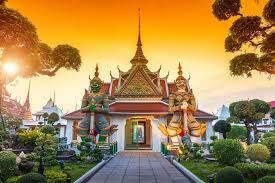
A 21-day adventure through Vietnam, Cambodia & Thailand
Experience an extraordinary 21-day tour through Vietnam, Cambodia, and Thailand, meticulously crafted for nature and culture aficionados. Discover the most captivating landscapes, delve into rich cultural tapestries, and savor delectable cuisines. Amidst these adventures, indulge in moments of luxury and relaxation, ensuring an unforgettable escapade.

A 3-Week Discovery of Vietnam Off the Beaten Track
Are you seeking a profound exploration of our nation? Then choose "A 3-Week Discovery of Vietnam Off the Beaten Track". This extensive cross-country journey spans three weeks, encompassing all the prominent destinations across Vietnam. Your adventure will include a memorable junk cruise...

A Journey Through Vietnam's Highlights in 2 Weeks
Our Vietnam 2-week itinerary from north to south offers an overview of the country's three main regions, shaped like an S. To the north, you will visit Hanoi, the thousand-year-old capital, experience both the maritime and terrestrial beauty of Halong Bay, and make an excursion to the splendid mountains of Sapa. In the center, explore the ancient imperial city of Hue and the charming old town of Hoi An. The journey concludes in the south with visits to Ho Chi Minh City and the vibrant Mekong Delta. Below are our program suggestions for a comprehensive 14-day tour in Vietnam.
+84 2436983617 (fixe)
+84 33 371 7599 (hotline)

- Travel to Vietnam
- International

Travel by train Vietnam: complete guide and itineraries

The scenic route from Hanoi to Danang a second-to-none experience
If your travel experiences are limited to buses and planes, you’re missing out on one of the best ways to see the world: the train. Not only increasingly attractive to the pocketbook, a scenic train ride can even be a holiday in itself. If you’re planning a trip to Indochina, this guide will provide you with everything you need to know about travel by train Vietnam and help answer all your questions.
If you want an inexpensive yet exciting trip to travel along Vietnam from the North to the South, train could be a perfect choice. Many parts of the railways system in Vietnam go along or even through mountains, forests, valleys, plain and sea, so you would certainly have chance to contemplate the incredibly magnificent and fascinating scenery.
1. Focus on Vietnam railways
The Vietnamese railway system was introduced to Vietnam during the period of French rule and is a true colonial legacy. The construction of the North-South Railway began in 1899 and took more than 30 years to complete. On 2 October 1936, the entire 1726 km Hanoi – Saigon line was officially opened. It was and remains today the only railway line connecting Hanoi and Saigon. Unfortunately, during the war years in the 20th century, fighting against occupying foreign forces with relentless bombing by the Americans almost marked the end of the railway.

The reconstruction of the ruined network quickly became a priority after the reunification of the country in 1975. The heavily damaged and war-torn North-South line was restored and put back into service in 1976. It was renamed the “Reunification Express” as a symbol of Vietnamese unity.
Map of Vietnam’s trains
The Reunification Express line is operated by Vietnam Railways (VNR), a Vietnamese state-owned company. With a length of 2600 km, the Vietnam train serves almost all cities and provinces in Vietnam, including many cultural and tourist destinations from north to south. Find here the map of trains in Vietnam:

2. Why choose travel by train in Vietnam?
Before travelling by train in Vietnam, it is important to note that the Vietnamese railways are not as modern and developed as those in your country. With a speed of 50-60km/h, it can take up to 30+ hours to travel from Hanoi to Saigon.
Some lines are even nicknamed “Vietnam’s high-speed train”, the humorous tone of which is understood to mean “High Vibration Train”. This is a result of the metric tracks, i.e. the narrow gauge tracks with a gauge of 1m kept since the colonial period, which are now becoming outdated. But then, is the Vietnam train really worth trying? What are its assets that make its reputation so picturesque?

In the modern world, speed is often more appreciated, but this is not always the case in travel. Sometimes the best way to get the most out of a travel experience is to…slow down a bit. Sit back, relax and enjoy the beautiful scenery through the carriage window. This way, the journey becomes a relaxing time rather than a stressful journey from home to destination.
The splendour of the journey lies in its incredible scenery. Numerous railways run through mountains, forests and valleys that offer incredibly breathtaking and charming views. The train even travels on paths where other means of transport cannot. This gives you an up-close and personal view of hidden parts of Vietnam that are only accessible to you. Moreover, its slow speed allows you to enjoy the spectacular view outside while taking pictures or videos to remember the unforgettable moments you spent during your Vietnam train trip.

Therefore, this is the reason why the train is still a popular and much sought-after option for many travellers, although the inter-provincial bus system and especially the domestic flights have been greatly improved in recent years. On the other hand, affordability is another reason to choose the railway for travel. Compared to the price of flights, train tickets are much cheaper, costing about half or a third of the price of a plane ticket, depending on the route.
And finally, high safety is also an advantage of this means of transport. The railway system in Vietnam has recently been rebuilt and developed significantly to adapt to the new innovations in the railway industry in the world. Thus, safety conditions are much better than before. In addition, the train in Vietnam is not a high-speed means of transport and there is only one train running on a railway, so the accident rate for the train is minuscule.
3. The most beautiful train journeys in Vietnam
3.1 hanoi sapa night train.
Sapa is a mountain resort in Lao Cai province established by the French in 1922. The line from Hanoi to Lao Cai was built by the French and opened in 1910 as part of the Vietnam-Kunming metric railway. The beautiful scenery and colourful local tribes of the misty town of Sapa make it a popular stop on many visitors’ itineraries. If you want to save one night on accommodation, one of the best ways to get there is to take the Hanoi Sapa night train. There are 2 sleeper trains between Hanoi and Sapa each day.
Please note:
SP1 and SP2: This train offers private sleeping cars for tourists, served by companies such as Fansipan, Livitrans, Orient Express and The Pumpkin Express.
SP3 and SP4: Much of this train consists of private sleeping cars, including Sapaly, Chapa, Laman and Victoria Express. The latter is one of the most luxurious trains on the Hanoi – Sapa route accommodating up to 40 passengers with luxury cabins, bar and restaurant.
3.2 Hanoi – Hue Train
The imperial city of Hue is an attractive destination in Vietnam to discover its historical and cultural heritages, pristine beaches, beautiful landscapes and unique cuisine. The Hanoi Hue train can take about 14 hours and costs between $36 and $80. Each day, there are 5 trains serving this route including night or day trains of Vietnam Railways and luxury tourist train companies such as Livitrans (SE3 and SE4), Laman (SE19), Lotus (SE19 and SE20) and Violette (SE1 and SE3). The latter companies usually offer the Hanoi Hue night train with premium services.
Hanoi – Hue SE1 SE3 SE5 SE7 SE19 Depart Hanoi10:20 p.m.7:30 p.m.09:006:00 am8:10 p.m.Arrival in Hue10:5208:3010:42 p.m.7:47 p.m.09:30
3.3 Saigon Nha Trang train
Known as one of the best seaside resorts in Vietnam, the coastal town of Nha Trang is undoubtedly an essential stopover when visiting the central region. It can be reached from Saigon by an 8-9 hour train ride. There are 6 trains per day on this line, which are operated by Vietnam Railways and Livitrans (SNT1 and SNT2). The ticket price varies between $30 and $40.
Saigon–Nha Trang SE2 SE4 SE6 SE8 SE22 SNT2 Departure from Saigon9:55 p.m.7:45 p.m.09:006:00 am11:50 a.m.8:30 p.m.Arrival in Nha Trang04:4703:144:21 p.m.1:18 p.m.7:46 p.m.05:30
3.4 Trains like no other
Rack train in dalat.
It is known that the romantic city of Dalat is home to the most beautiful railway station in Vietnam with the Art Deco style in its architectural structure and its striking resemblance to the railway station in Deauville. But few people know that it once had one of the rarest rack railways in the world. This is a track system with a third central rail with teeth between the running rails. This rail engages with a serrated wheel under the locomotive, providing traction for the very steep gradients between Dalat and Thap Cham (in Ninh Thuan province) while preventing the train from sliding too fast on the way down.

This 84 km long railway was one of the rarest railways in the world, as there were only two of its kind at the time, one in Dalat and the other in Switzerland: the Jungfraujoch railway. The steam locomotives used were manufactured in Switzerland and were among the most modern in the world.
See more: Train street in Hanoi: complete guide by locals
Luxury train “Indochina” Danang – Quy Nhon
Welcoming passengers from July 1, 2020, the new train line The Vietage connecting Danang Station and Dieu Tri (Quy Nhon) Station is remarkable for its interior design, which is reminiscent of the background of old Indochinese films. The cabin is decorated with wooden floors, combined with traditional yellow rattan seats.

The Vietage train leaves Danang station every morning for a 6-hour journey to Quy Nhon and returns to Danang every evening. Designed for maximum passenger comfort and privacy, in addition to 12 seats, Vietage also offers a range of services such as restaurants, bars and relaxing massages.
4. How to choose your seat on a train in Vietnam?
There are four main categories of Vietnam train tickets:
Hard seat: mainly used for day trips, this is the cheapest and least comfortable type of ticket.
Soft seat: mainly used for day trips, these seats are more comfortable and more expensive than hard seats
Hard sleeper: used for the Vietnam night train, it has three levels of beds (six per compartment). Prices vary according to the level of the berth (those closest to the top are the cheapest). These compartments do not have a door.
Soft sleeper: used on the Vietnam night train, it has two levels of beds (four per compartment). All bunk beds are charged at the same rate.

Some private companies such as Victoria Express, Orient Express, Livitrans, Violette, Laman and many others rent compartments from Vietnam Railways and then upgrade them, provide services and resell tickets to tourists. These companies offer private sleeping cars with high quality berths for tourists. They also provide private compartments with 2 soft beds. The Vietnam sleeper train has air-conditioning, clean beds, free mineral water and (in some cases) snacks and clean western-style toilets.
5. How to book your train ticket?
If you want to buy a train ticket online, go to the official Vietnam Railways website: dsvn.vn . In the search results, select a train, select a carriage with the desired class and click to buy. You may have to fill in a Vietnamese mobile phone number with a country code. And it certainly won’t accept your non-Vietnamese credit card.
If this sounds too complex, it is easy to buy Vietnam train tickets directly at the station when you arrive in Vietnam. However, trains are always busy, especially during rush hour, holidays such as Tet, and holidays. It is therefore recommended to book your ticket a few days in advance.
Alternatively, you can travel with a local travel agency in Vietnam that will take care of your reservations and transfers to and from the station.
Tips for travel by train Vietnam
Below is the list of things you should remember when traveling by train in Vietnam.
- Print out your e-tickets
- Don’t forget your ID or passport
- Arrive at the station 60 minutes before departure time
- Bring a maximum of 20 kg
- Take care of your belongings
- Pack food and drinks in advance (optional)
What to pack?
- A suitcase with a digital lock. Also, if possible, choose a waterproof bag if you travel during the rainy season in Vietnam .
- Wear comfortable outfit
- Small towel
- Food and drink. The food served on the train is not very diverse, and the price is quite high, so bring some snacks and water with you.
- Toilet paper
- Necessary documents: Passport / Identification card
Here you have a general overview of Vietnam rail transport, we hope that this practical information will help you in the organisation of your future Vietnam trip , which will prove to be unusual and unforgettable.
Complete guide to the Vietnam weather and best time to visit this year
Symbols of vietnamese culture throughout history and meanings.

Hanoi train street: unique experience to put on Indochina bucket list
- Pingback: Simple guide to budgeting your trip to Nha Trang Vietnam in 2023
Leave a Reply Cancel reply
Your email address will not be published. Required fields are marked *
Save my name, email, and website in this browser for the next time I comment.

Recommended

Fairy tales don’t lie: five of the world’s most famous castles in Europe

Travel to London at Christmas with kids – Magical things to do
Recent posts.
- The 7 best traditional Viennese coffee houses
- Top 10+ things to do in Uluru and around – for free
- Paraty Brazil, the famous city soaked in sea water once a month
- 8 Idyllically Beautiful and Charming Wine Towns in Germany
- Explore the world
- International travel
- Entries feed
- Comments feed
- WordPress.org
For everyone. Get the latest news and follow the coverage of breaking news, local news, national and more from the top trusted sources.
© 2023 Viet36 - News & magazine theme by Viet36 .
Welcome Back!
Login to your account below
Remember Me
Retrieve your password
Please enter your username or email address to reset your password.
Magnificent Rail uses cookies to give you the best possible service. If you continue browsing, you agree to our use of cookies. More details can be found in our terms and conditions .
VIETNAM RAIL ADVENTURE
15 days/14 nights
Max group 12
Lifetime Deposit
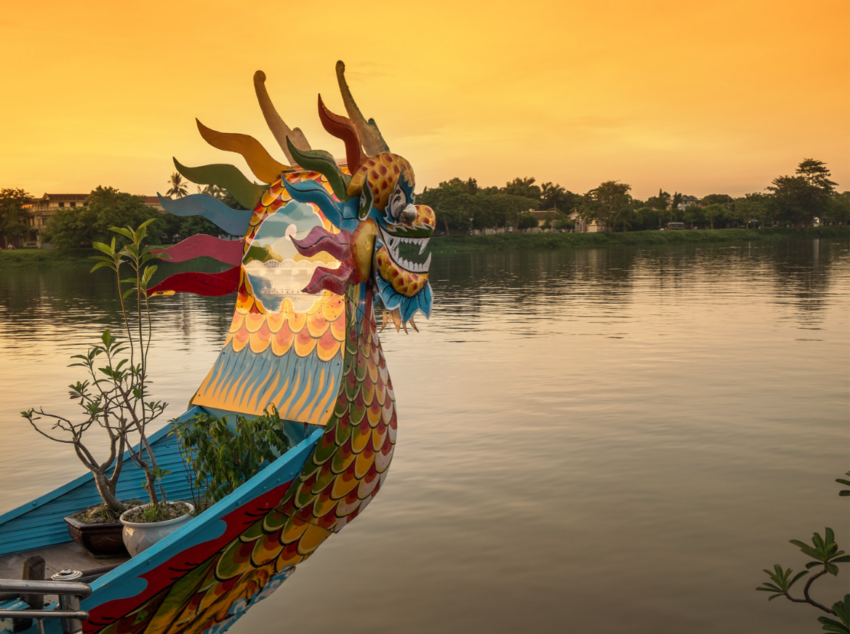
15 DAY ADVENTURE from Hanoi to Ho Chi Minh City
Come travel on the transport and freight ‘lifeblood’ of Vietnam – along the segments of the Reunification Express that will leave you both in awe and inspired. Travel along cliff-top sea view tracks, into tunnels framed with jungle, down iconic ‘Train Street’ and through magazine-famous mountain passes.
You’ll experience both Vietnam’s best, and its secret-best! Have heartfelt moments with locals, eat your way through incredible food, browse the produce at colourful markets, explore a melting pot of architectural styles and stay in gorgeous and boutique accommodation.
Vietnam’s trains are a slow traveller’s piece-de-resistance, so sit back and enjoy the ride in the company of no more than 12 in your grou p. All those people flying across the country have no clue what they’re missing!
November 2024
Starts: Hanoi, November 1, 2024
Finishes: – Ho Chi Minh, November 16, 2024
Price – $8,866 AUD (per person twin share)
Single supplement: $2,076 AUD
Doing our November trip?!
Your 16-Day itinerary is HERE.
February 2025
Start: 7 February 2025
Finish: 21 February 2025
Price: $9,365 AUD per person (twin share)
Private Supplement: $2,359 AUD per person
Start: 21 February 2025
Finish: 7 March 2025
Trip Breakdown
Trip length.
15 days, 14 nights
According to departure date
- $1,900 AUD deposit, per person
- 2-week cooling-off period applies
- Lifetime deposit. If you need to cancel, your deposit is transferable to other trips
- Twin Share: we’ll match you with a roomie if you’re travelling solo.
- Private supplement available (see above) Tip Kitty: $210 AUD
Please refer to our payment terms in the FAQs.
Meeting point
GM Premium Hotel, Hanoi
Ending point
Hotel Des Arts, Ho Chi Minh City
Maximum 12 people.
- Meals : 14 breakfasts, 1 Brunch, 7 lunches and 8 dinners
- List transport: 5 x trains, 1 x Overnight Cruise, 4x full day private air-conditioned transportation and all private transportation transfers listed.
- 12 nights boutique and premium accommodation, 1 night cruise, 1 night overnight train
- 1 top-rated tour leader throughout and specialist guides along the way.
- All listed activities and more!
- International flights
- Travel insurance (compulsory)
- Any visas required
- Late check-out at hotels
- Meals and drinks not mentioned in the itinerary
- Drinks with included lunches and dinners
- Tip kitty (See FAQs for more information)
- Personal expenditure
Have a group?
Contact us and we can arrange a private departure.
Trip Highlights
Ride the Hanoi train through Train Street
Luxury Overnight Cruise in secluded Lan Ha Bay
Foodie Tour in Hue aboard a pedal powered rickshaw
The Vietage Luxury Carriage trip
Evening cultural show at the Saigon Opera House
Explore the Mekong Delta
What our Vietnam MagRailers say
- Trip Details
Train Journeys Included
Day 2: Train ride via famous Train Street
Day 5 : Overnight train to Dong Hoi
Day 6 : Train to Hue, Evening Foodie & Cyclo Tour
Day 8: Train to Hoi An
Day 10: The Vietage Luxury Train Carriage to Quy Nhon
Accommodation Preview
All Accommodation on this trip is 4 and 5 stars. Here are some examples:
GM PREMIUM HOTEL - (2 NIGHTS)
ALLEGRO HOI AN RESORT - (2 NIGHTS )
Anantara Quy Nhon Villas - (2 NIGHTS)
Trip Summary
2025 itinerary.
Day 1: HANOI
Welcome to Vietnam! Your VIP treatment starts right away. One of our team will meet you as you exit the plane and guide you through the immigration process. They’ll even help you retrieve your luggage – when does that ever happen? Once you’re through immigration, they’ll deliver you safely into the hands of your guide, who will whisk you directly to the hotel.
Tonight, get to know the group over dinner for the first catch up – at one of our favourite local restaurants, of course!
ACCOMMODATION: GM Premium Hotel – Deluxe room (or similar) INCLUDED: Dinner
Day 2: THE OLD QUARTER
Early mornings in Hanoi are all about makeshift market stalls and boisterous coffee houses. So, let’s skip the hotel breakfast and fill up on crusty baguettes stuffed with fresh ingredients, as you explore Hanoi like a local with your guide. Here’s a tip! Try the local (Vietnamese recipe) iced coffee, or the egg coffee if you dare – these are unique to Vietnam.
Hanoi’s Old Quarter has been around for more than 1000 years, and while you wander along its cobblestone lanes today, you’ll catch the heady scent of incense wafting from ancestral temples, and come to understand how the city’s many cultural incarnations contribute to its eclectic charm. Wrap up the day over a relaxing drink in a neighbourhood Bia Hoi or Beerhall.
ACCOMMODATION: GM Premium Hotel – Deluxe room (or similar) INCLUDED: Breakfast and Lunch
Day 3: LAN HA BAY
Cruising on Halong Bay is on plenty of travellers’ bucket lists. But have you heard of Lan Ha Bay? It’s remote compared to its celebrity neighbour, has scenery that is just as jaw-dropping, and best of all, none of the tourist hordes!
You’ll transfer by road after breakfast and set sail by lunchtime on The Heritage Cruise. Join in with the deserted-beach and water-cave excursions, make use of the onboard kayaks, or just relax on your cabin’s private balcony, cocktail in hand, watching the sunset over the Gulf of Tonkin.
ACCOMMODATION: Heritage Cruise – Ocean Cabin (or similar) INCLUDED: Breakfast, Lunch and Dinner
Day 4: LAN HA BAY AND SLEEPER TRAIN
Early risers can join the Vovinam (Vietnam’s martial arts) class on the sundeck. Then jump aboard a traditional rowboat to go into the Light and Dark Cave. You’ll glide through the cave’s opening which is framed by fig trees and orchids, and into its silent darkness, only to be bathed in light once more when you pop out the other side and into the hidden lagoon.
After Brunch, it’s time to say your goodbyes to the Heritage crew and reunite with your guide and driver for the last road transfer of the trip. This afternoon you’re back in Hanoi with just enough time to stretch your legs and maybe pick up that last minute Hanoian souvenir.
Day 4.5: OVERNIGHT TRAIN TO DONG
After a local restaurant dinner with your fellow MagRailers , it’s All Aboard your first ride on Vietnam’s Reunification Express: Hanoi to Phong Nha. Yep – your first long-haul train ride is a sleeper! They’re 4 berthed shared compartments with toilets at the end of the carriage. But if you fancy a little privacy, private berths can be arranged!
INCLUDED: Brunch and Dinner
Day 5: PHONG NHA
The train should pull into Dong Hoi Station around 6am and your room will already be prepared for you at the Lake House. Take a rest, and breakfast at your leisure, before regrouping later to visit Phong Nha Cave. As the riverboat chugs along the Son River, you’ll be forgiven for thinking you’ve stepped back in time. This prehistoric-like landscape is backdrop-perfection to riverside villages barely changed in centuries. And the sound of children playing on the riverbank will joyfully echo in your memory long after you’re back at home.
The entrance to the cave is literally a hole at the base of a towering limestone cliff and your boat will glide right on through. The underground river system stretches for kilometres, but your boat will moor, so you can tread the boardwalk to be closer to the ancient stalactite and rock formations.
Then, back to the Lake House – be sure to use some of your leisure time later today relaxing on your private lakeside balcony.
ACCOMMODATION: Phong Nha Lake House, Bungalow with lake view, or similar INCLUDED: Breakfast
Today’s train to Hue is a three-hour ride on a local train. These trains aren’t known for their punctuality, and there’s nothing further planned today except check-in and, of course, dinner – so why not say hi to some local fellow travellers and sit back and enjoy the ride.
Did somebody mention dinner?
Vietnamese food is to Hue, like Pizza is to Naples – it’s the traditional home of much of Vietnam’s deliciousness. So tonight, we’ve planned our favourite food tour of all! What an enjoyable rush as your cyclo-driver skilfully manoeuvres his rickshaw along tiny alleyways to the best street-food venues in town! Your tastebuds will do a merry dance trying treats like Hue’s crispy savoury pancakes and for your sweet tooth, the sweet soups are surprisingly delicious.
ACCOMMODATION: Eldora Hotel, Deluxe City View Room, or similar
INCLUDED: Breakfast box and Dinner Food Tour
Come out today to see Hue through the eyes of a local. Your neighbourhood guide will share childhood stories about life during the war and intimate family history as you’re led down side-streets abuzz with local life. Then travel by boat to a riverside village whose families have created bronze pieces since the 1500s.
Enjoy your leisure time tonight – your hotel is well situated to wander out and explore the nearby neighbourhoods and local restaurants. It may be that you decide to track down one of your favourite food spots from last night’s feasting for one more serve of your favourite dish!
INCLUDED: Breakfast and Lunch
Day 8: HOI AN
The train leaves for Da Nang at 9am. The trip should only take a round 2.5 hours, but gazing out the window as the train crawls along Hai Van Pass – coastline drama to your left, mountains to your right – you’ll be hoping that time slows. Not surprisingly, this part of the journey features regularly in those ‘10 best’ travel lists we all read. Train trip finished, Hoi An is a 45-minute road transfer from Da Nang Station.
Hoi An. Yes, it’s a tourist hotspot. It’s also a must-see, so we’ve made sure your experience is not a generic one. But first, you need to see what everyone else comes for, and on this afternoon’s walking tour of the old town, you’ll discover why its UNESCO Heritage status is well deserved.
ACCOMMODATION: Allegro Hoi An resort, Junior Suite room (or similar) INCLUDED: Breakfast and Dinner
Day 9: HOI AN
By now your love for Vietnamese food will be an obsession and today you can nurture that along even more! The group will head out on bicycles to follow a food trail – from farm to plate. (Again, it’s an easy ride, but you’re welcome to travel by car.) You’ll meet friendly market stallholders selling local ingredients and farmers who grow them just nearby. At the end, you’ll connect with your chef, learn about cooking, and get to share the spoils over lunch. No previous cooking experience required!
The remainder of the day is at your leisure. Spend it in your splendid accommodation or wander through the old town. It’s user friendly – there’s even an Irish Pub if you’re feeling like a change of scene!
ACCOMMODATION: Allegro Hoi An resort, Junior Suite room (or similar) INCLUDED: Breakfast and Lunch
Day 10: THE VIETAGE LUXURY CARRIAGE TO QUY NHON
There’s an early checkout and breakfast is served in a box, but that’s of no consequence today, because for the rest of the day, you’ll be travelling in luxury. The Vietage carriage departs with the southbound Reunification Express from Da Nang at 8am, and your group will have it all to yourselves – a fitting finale to your train rides!
Once onboard, you’re welcome to sit at the bar – for a specialty coffee, of course! Or settle into your window seat and watch central Vietnam amble by, outside. Keep an eye out for the ruins of the Hindu Champa Kingdom from the 4th century. There’s lunch onboard too, but not just any old lunch. Today it’s first-class all the way!
Today’s journey ends at the oh-so-swish Vietage partner hotel in the resort town of Quy Nhon. Dinner’s arranged at the hotel tonight – that’s if you can drag yourself away from your ocean view villa and its private pool!!
ACCOMMODATION: Anantara Quy Nhon resort, Oceanview Pool Villa INCLUDED: Breakfast, Lunch and Dinner
Day 11: QUY NHON
Fancy a lie-in today? Be our guest! In the afternoon the group will meet up for a tour around the district. Ancient buildings like the one you spotted from the train yesterday are scattered around the landscape and they’re known as Cham Towers. Built at least 1,000 years ago, some are still visited for worshipping today.
Wrap up the day with dinner at a local restaurant. The seafood is so fresh here!
ACCOMMODATION: Anantara Quy Nhon resort, Oceanview Pool Villa INCLUDED: Breakfast and Dinner
Day 12: HO CHI MINH CITY (SAIGON)
You’re out the door after breakfast to catch your flight to Ho Chi Min City. Why fly this leg, I hear you ask? (How dare we avoid the train!) Well, the reason turns out to be simple: there’s just not a lot to see along the way. And it would be a non-stop, arduous, 13-or-more-hour stint on a train that’s at the untidy end of a very long journey.
After the laidback countryside, you’ll instantly feel the big-city energy of Ho Chi Min. It’s the business heart that drives the nation, but it has its traditional neighbourhoods too, if you know where to look. Check into your hotel and head out to explore with your guide. Stops include The War Museum and Saigon Railway Station. We’d like to say we’ve arranged a ride on Ho Chi Min City’s brand-new subway line, but completion dates have been set and reset since 2018, so let’s just wait and see. Tonight, you’re off to a unique cultural performance at the Saigon Opera House!
ACCOMMODATION: Hotel Des Arts , Deluxe room (or similar) INCLUDED: Breakfast, Lunch and Dinner
Day 13: CU CHI TUNNELS
We’ve all heard about the tunnels built by Vietnamese guerrillas during Vietnam’s wars for Independence and Reunification, but to see them first-hand will take your appreciation for their ingenuity to a different level – especially when you see the smokeless kitchen, designed by an army chef back in 1951. Spending a little time underground in the tunnels will give you more insight into wartime survival in Vietnam.
After lunch, the group will head back to Ho Chi Min and the rest of the afternoon is for your choosing. Why not watch the sunset over the city, cocktail in hand, on the terrace of a nearby rooftop bar. Turtle Park is just a short stroll from the hotel too, which livens up each night when locals flock to the pop-up street-food stalls.
ACCOMMODATION: Hotel Des Arts , Deluxe room (or similar) INCLUDED: Breakfast and Lunch
Day 14: THE MEKONG DELTA
The saddest part of today is when you wake up and realise that you have just one full day remaining. But that one day will be lived to the fullest!
The tentacles of the Mekong’s River Delta reach all the way to the city and you’ll travel along one into the heart of the Delta today. Your boat chugs along while daily life in the south unfolds before you – like a movie with an artistically-perfected film set. As your boat draws into the bank along the way, and later when you travel by bicycle or rickshaw, you too will find yourself in that movie scene – meeting with workers and farmers who openly share with you about their lives. The adventure then finishes by row boat along a palm-lined canal – a most quintessential jungle experience to reach your lunch spot!
There’s enough time this afternoon for packing your case and preparing for dinner. And what a farewell dinner it will be, as you reminisce with your new-found friends and raise cheers to each other and your Vietnam adventure!
Day 15: FAREWELL FRIENDS
Swap numbers and emails at breakfast, for it’s time to farewell friends. Your airport transfer is included, and your driver will pick you up 3 hours before your flight departure. Hotel checkout is at noon.
INCLUDED: Breakfast
Frequently Asked Questions
Prior to the payment of your full balance, the final price may change if there is significant variation in the AUD:USD exchange rate. Our trip pricing is determined by what the exchange rates are at the time of publishing the trip.
The pricing on these trips is based on the following exchange rates:
23 February 2024 departure: 1 AUD:0.66 USD
1 November 2024 departure: 1 AUD:0.66 USD
A deposit of $1,900 is required to hold your spot. Payment can be made by credit card (fees apply) or bank deposit.
There is a cooling-off period of 2 weeks. (Applicable to all bookings made 110 days in advance.)
We have implemented a ‘lifetime deposit’ guarantee. Deposits are not refundable, but they are transferable at any time, right up until the first day of the trip.
The final balance of the trip is required 95 days in advance of the departure date. Our suppliers require upfront payment well in advance to guarantee availability.
Australians and New Zealanders require a tourist e-Visa to enter Vietnam, which will cost $25 to $50 USD. When the time comes to apply, we’ll assist with all the info you need.
Your trip has been designed by Mat & Lisa, the two cultural adventure experts behind Magnificent Rail.
Magnificent Rail is brought to you by the same team who built Patch Adventures, a boutique women-only adventure company.
Lisa is a travel guidebook author and photographer. Mat’s first rail journey was an epic adventure through Europe at the age of 13 (accompanied by parents of course.) He has since organised highly successful tours to far-flung destinations around the world. Between them, they have put together this well-balanced adventure for you.
The preparation of this trip has taken months and months of work.
Your trip will be led by local experts that have been selected by our team for their knowledge and experience.
Most of our trips have a tip kitty because many cultures have interesting and diverse rules when it comes to tips. We’ve found it to be the easiest way to combat over-tipping, under-tipping or having the tip fall into the wrong hands. Our goal is for guests to relax and know that the complexities of tipping are taken care of, on their behalf.
For your Vietnam adventure, we ask your contribution be: 3,250,000 VND (equivalent to $210 AUD) to your guide on Day 1. The kitty will be managed by your guide and distributed along the way at restaurants for included meals, hotel staff, drivers, train station porterage and services.
What is not covered is a customary tip at the end of the trip for your guide. If they’ve ensured that your trip is memorable, we recommend the following guidelines:
1,800,000 VND to 2,500,000 VND per person at the end of the trip ($120 – $160 AUD equivalent).
(Exchange Rate used – $1AUD : 15,562 Vietnamese Dong)
Overnight train On the overnight train, you’ll be allocated a soft sleeper bunk. Each compartment has 4 berths: 2 lower and 2 upper bunks. The compartments are airconditioned and open off a side corridor. They can be securely locked from the inside. You’ll be supplied with a pillow, sheet and duvet. You may keep all your bags with you, and the luggage space is beneath the bottom bunks. Shared toilets (including a sit-down style toilet) are located at the end of each carriage. There is an option to secure a private 4-berth compartment available at $112 AUD per berth.
Day train Stations have ‘train hosts’ who take responsibility for the luggage on your arrival at the station and stow the luggage onboard a luggage carriage when the train arrives. There is space for carry-on luggage above and below the seats in the carriage. It’s not a dissimilar situation to luggage when you’re travelling by plane.
So long as you have a general level of health and fitness, you’ll be fine. There’s no specific exercise planned for this trip, but there will be days when you’ll be walking and spending a lot of time on your feet. Daily activities may include city walks or a short bicycle tour on flat terrain and getting on and off various forms of transport.
All activities are optional, meaning that if you don’t feel like it, you can skip it, but it will be impossible to enjoy your trip if you’re not able to do a walking tour for a full afternoon. Unfortunately, this tour cannot accommodate people requiring walking aids.
Will we be picked up at the airport? Yes! One of our friendly team will be waiting for you in the public arrivals area of the airport. You’ll transfer directly to the hotel. The transfer is free and in a private and air-conditioned vehicle, which you will only share if there is anyone else on your flight joining the tour.
When should we arrive? Try to arrive before midday on the start day, although earlier would be recommendable. If possible, come one day early to settle in. We can organise additional hotel nights for you at cost.
Being tour operators (not travel agents), we are not licensed to sell flights. We recommend contacting your trusted local travel agent to book flights, if you’re in need of assistance.
10kg hand luggage and 23kg checked luggage.
Vietnamese cuisine is a combination of the bitter, sour, spicy, sweet, and salty flavours merged into delicious broth and sauces, while rice comes in different shapes and textures.
Many Vietnamese dishes have been influenced by China. It is also possible to see the legacies left by French colonisation, such as baguette bread and coffee.
YES! We can accommodate vegetarian, vegan and gluten-free diets no problems, or any variation of the above. Just let us know in advance. Note: this food is often very simple and may get repetitive.
Whether you are a couple, or a couple of friends, or travelling solo, our Magnificent Rail journeys will appeal to anyone who is inspired by the charm of scenic rail travel and wants to see the best of a country.
Our adventures are designed to appeal to those in their 50s, and 60s and early 70s (but of course, everyone is welcome!) Our clients are curious and active, and want to find the magic of travel again, but with some modern comforts in unique and interesting places along the way. They’ve often avoided tours in the past because they’re not attracted to being herded around in large groups.
They prefer insider perspectives and lingering longer in the right places for a deeper experience.
Send us an email at [email protected] or give us a call at +61 482 095 648 ; A deposit is required to reserve your spot.
Have more questions? Check out our FAQ page!
Other magnificent rail adventures…, scotland rail adventure, northern india.
Vietnam Express Southbound
10 days | discover backwaters, karst-studded bays, bustling cities and bicycle-powered food carts.

Discover the essence of captivating Vietnam on this ten-day tour through backstreets, villages, cities and waterways. Trace the east coast on this fast-paced adventure and take in World Heritage-listed landscapes and towns, feel the buzz of bustling cities and fuel yourself with banh mi and condensed milk coffee. As lively as it is lovely, Vietnam can seem an intimidating place to travel, but your local leaders will guide you to the best street food (and tell you how to order it), introduce you to fishermen on the Mekong Delta and give you the inside scoop on the best tailors in Hoi An. This is an adventure full of life, colour and flavour that introduces you to the highlights of this fascinating nation.
Trip overview
- Fall in love with Vietnam one bite at a time, from pho, slurped on a busy street corner to a vegetarian feast in a Buddhist nunnery.
- Sail through Halong Bay's limestone karsts and island caves, visit a centre that turns the bay's discarded trash into treasures and spend the night checking out the stars on an overnight cruise.
- Travel like a local on a motorbike tour, riding pillion and taking in the historical pagodas, bridges and villages of Hue.
- Embrace a slower pace during a private boat tour of the Mekong Delta and meet local craftspeople in the villages that line the river's myriad waterways.
- Wander through the remarkably well-preserved streets of Hoi An's Old Town on a guided tour, where elegant wooden buildings line the canals.
- By travelling on this trip, you’ll directly support our Intrepid Foundation partner, WildAct. Donations help them run educational programs that aim to stop the illegal hunting of threatened migratory birds in Vietnam.
- In order to see as much as possible, this trip involves some long journeys, including by overnight train where the amenities are shared and basic. For more about what this experience is like, see our blog post here: http://www.intrepidtravel.com/adventures/what-to-expect-on-an-overnight-train-in-vietnam/
- The motorbike tour of Hue has been assessed for safety and is closely monitored (helmets are provided). However, alternative transport can be arranged for those who would prefer not to travel by motorbike.
- Depending on where you come from, the weather in Vietnam might be hotter and more humid than what you are used to. Please consider your suitability for the season you wish to travel in. Check out http://www.intrepidtravel.com/vietnam/weather-in-vietnam for more info.
- Itinerary also runs in reverse, from Ho Chi Minh City to Hanoi. Enter trip code TVSQ on our website for details.
- This trip is a great way to see a lot of Vietnam in a relatively short period of time. If you would like a longer tour in Vietnam, maybe check out Best of Vietnam (TVST).You may also want to check out our South East Asia Loop (TTSVC), or our Best of Vietnam & Cambodia (TVSKC) if you have longer time to explore in the region.
Xin chao! Welcome to Hanoi! Your adventure begins with a welcome meeting at 6 pm at the hotel and is followed by a group dinner at KOTO restaurant. This organisation is dedicated to developing the hospitality careers of disadvantaged youth. If you arrive early, there’s plenty to see and do. Consider booking the Hanoi Street Food Experience at 9 am (see urbanadventures.com/en for details). You'll get to sample delicious Vietnamese cuisine like a true local, stroll through the hidden alleyways and bustling markets and take in a spectacular view of Hoan Kiem lake from a secret café. Or maybe take it at your own pace and wander the Old Quarter to admire the city’s French-colonial architecture.
- Hotel (1 night)
- Hanoi - KOTO dinner
- Hanoi - Women's Museum - VND30000
- Hanoi - Museum of Ethnology - VND40000
- Hanoi - Ho Chi Minh Complex - VND80000
- Hanoi - Hanoi Street Food Experience Urban Adventure - USD40
It’s very important that you attend the welcome meeting as we will be collecting insurance details and next of kin information at this time. If you are going to be late please let your travel agent or hotel reception know. Ask reception or look for a note in the lobby for more information on where the meeting will take place.
To book an Urban Adventure before you meet your tour leader, go to urbanadventures.com/destination/hanoi-tours.
Travel by private minibus to World Heritage-listed Ha Long Bay, which is dotted with sandy coves, grottoes and 1600 limestone islands formed over millennia by wind and water erosion. Board a private boat and cruise the bay, exploring Surprise Cave and perhaps even enjoying a swim from Ti Top Island Beach during the warmer months. Access to Surprise Cave is via staircases. Once inside the cave the pathways are a little uneven and slippery. To end the day, spend an evening aboard the boat beneath the night sky. What better way to get to know your fellow travellers than an old school sleepover in an unforgettable location?
- Overnight boat (1 night)
- Halong Bay - Overnight Boat Cruise
- Halong Bay - Cave entry
- Halong Bay - Kayaking Tour - VND250000
Your travel time today will be approximately 4 hours.
Your wooden junk-style boat has twin-share cabins with air-conditioning and private facilities. There's also a dining room and bar to enjoy lunch, dinner and breakfast.
Kayaking and swimming is restricted to designated zones within the bay.
There are restrictions on the number of boats that are permitted to stay in the bay overnight, sometimes resulting in a shortage. To ensure all Intrepid travellers can enjoy the experience of a night on the water, occasionally you will stay on a larger boat (with approximately 12 cabins) and share your boat with another group. Or your group may be split across different vessels, in which case an Intrepid group leader will be present on each boat. The route taken and inclusions on board will remain the same.
Wake up on the waters of Ha Long Bay, and before you leave the memorable scenery behind, it’s time for one last stop. The Green Life Centre is committed to turning Halong Bay’s trash into treasure by collecting discarded items and skillfully turning them into beautiful handicrafts. Meet the team behind this important cause and learn how to transform rubbish into a useful and reusable bag. After your visit, return by bus to Hanoi. Arrive late this afternoon and enjoy free time until tonight’s train voyage. Be sure to grab a bowl of pho while you’re in town and slurp down this local specialty made from broth, noodles and meat. Maybe chill by Hoan Kiem Lake until you board an overnight train to Hue this evening.
- Overnight sleeper train (1 night)
- Halong Bay - The Green Life Visit
Your travel time today will be approximately 3 hours, not including your overnight train.
Shared day use hotel rooms are arranged in Hanoi if you would like to freshen up before the overnight train (one room for every six group members).
Sleeper trains typically have four or six berth compartments with bench seats that convert into sleeping bunks. A sheet, pillow and blanket are provided, although some travellers prefer to bring their own sleeping sheet. Depending on the configuration of the group, you may need to share with people of different genders or passengers who aren’t part of the group. Your leader will coordinate this and give further information about the train.
Arrive in Hue this morning and transfer to the hotel. Once the imperial capital of Vietnam, Hue holds the treasures of the country’s royal past. Enjoy free time in the morning to rest or explore. If you choose the latter (and who can blame you) the bustling Dong Ba Market is a great place to sample some of the specialties that once graced the Nguyen emperors' tables like banh khoai (royal rice cake). Reunite with the group to visit the war-damaged ruins of the Imperial Citadel, a sprawling city-within-a-city which contains the remains of temples, state houses and the emperor’s palace.
There are no meals included on this day.
- Hue - Imperial City entrance and guided visit
See Hue like a local – from the back of a motorbike! Straddle the saddle and whiz around town with a local guide, taking in historic and contemporary sights along the way. Stop at Thanh Toan to see the 18th-century covered bridge and villagers shopping at their local market. Visit the 17th-century active Buddhist monastery of Thien Mu Pagoda and see the car that belonged to Thich Quang Duc, the monk who self-immolated in 1963 in protest against the treatment of Buddhists by the South Vietnamese regime. For lunch, savour a vegetarian feast in a nunnery. Finish at the lakeside royal tomb of Emperor Tu Duc before heading back to town.
- Hue - Royal tomb of Emperor Tu Duc
- Hue - Highlights & back streets by motorbike
- Hue - Thien Mu Pagoda
- Hue - Motorbike Tour Lunch
The motorbike tour has been assessed for safety and is closely monitored. To participate please ensure your travel insurance covers riding pillion on a motorbike up to 125cc. If you prefer not to participate, please let your leader know and they will arrange car transportation (cost included).
This morning travel by bus through coastal rice paddies and the spectacular Hai Van Pass. After a photo stop on the way, arrive into Hoi An. Recently declared a World Heritage site, Hoi An was a major international trading port during the 17th, 18th and 19th centuries. Today, parts of the beautifully-preserved town retain the feel of centuries past. It's also a shopping mecca, famous for its plethora of tailors. When you arrive, your leader will take you on a sightseeing walk through the Old Town to visit a handful of the city's major attractions. You’ll also be given a sightseeing pass so you can further explore select attractions at your leisure.
- Hoi An - Old Town walking tour
- Hoi An - Food Adventure Urban Adventure - USD44
Your travel time today will be approximately 3 hours.
Today is a free day to explore Hoi An. Maybe browse the cobbled streets and art galleries or hire a bike and cycle through rice paddies out to Cua Dai Beach. Maybe browse for paintings, ceramics and colourful cloth lanterns in the town’s markets and preserved Chinese shophouses. If you’re craving a new look, you could pay a visit to one of the hundreds of tailors and get something special made. Hoi An is also known for its delicious regional food, so be sure to enjoy a meal at a riverside restaurant or perhaps partake in a cooking class.
- Hoi An - Private Hoi An: My Son Discovery - USD77
Today take a short, early morning flight to Ho Chi Minh City. Formerly known as Saigon, Ho Chi Minh City has a fascinating history and is arguably Vietnam’s capital of commerce and culture. After landing, take a sightseeing tour around the city by bus. Pass the Reunification Palace, Notre Dame Cathedral and the Opera House, then stop in at the War Remnants Museum to discover some of the sobering stories of the 20-year-long Vietnam/American War.
- Ho Chi Minh City - War Remnants Museum
- Ho Chi Minh City - City tour
- Ho Chi Minh City - Reunification Palace - VND40000
- Ho Chi Minh City - A O show - VND1050000
- Ho Chi Minh City - Saigon Street Food by Night Urban Adventure - USD36
Your travel time today will be approximately 1.5 hours.
This morning head out on a day trip to explore the Mekong Delta. Board a private boat to Ben Tre to visit the coconut gardens and stop at a local home to sample tropical fruits and coconut jams. After, paddle in sampans (small rowing boats) past coconut trees along the Mekong Delta. Take a tuk-tuk tour around the villages and learn about rural life and the industry created around coconut products like brooms and coconut fibre mats. Eat lunch at a restaurant in the heart of the Delta, sampling regional specialties such as the famous elephant ear fish. Cruise the major waterways to Ben Tre boat pier, then return by bus to Ho Chi Minh City. This evening, perhaps head out to sample some local specialties as a final farewell with your fellow travellers and leader.
- Mekong Delta - Mekong Delta Day Trip & Village Tuk-Tuk Tour
- Mekong Delta - Lunch
There are no activities included and you’re free to depart your accommodation at any time as long as you comply with check out time. If you would like to spend some more time in Ho Chi Minh City, just speak to your booking agent.
- Ho Chi Minh City - Cu Chi Tunnel Experience Urban Adventure - USD45
8 breakfasts, 3 lunches, 2 dinners
Boat, Motorbike, Overnight sleeper train, Plane, Private Minibus, Taxi, Sampan, Tuk-tuk
Hotel (7 nights), Overnight boat (1 night), Overnight sleeper train (1 night)
Dates and availability
Important notes.
1. A single supplement is available if you’d prefer not to share a room on this trip. The single supplement exclude Day 2 (Overnight boat) and Day 3 (Sleeper Train) where you will be in shared accommodation and is subject to availability. Please speak to your booking agent for further information. Rooms booked only for day use are also excluded. 2. Please provide your full name exactly as per passport at the time of booking (including any middle names listed on your passport) for train and flight tickets. Fees may apply for amendments to details within 45 days of departure, and in some cases you will be required to cover the cost of issuing new tickets. 3. This trip includes a domestic flight. Checked luggage allowance is a maximum of 20 kilograms, plus up to 7 kilograms carry on luggage. Any excess luggage charges will need to be paid directly to the airline at check-in.
Want an in-depth insight into this trip? Essential Trip Information provides a detailed itinerary, visa info, how to get to your hotel, what's included - pretty much everything you need to know about this adventure and more.
Filter by rating
- Search Please fill out this field.
- Manage Your Subscription
- Give a Gift Subscription
- Newsletters
- Sweepstakes
- Destinations
This Might Be the Best Country to Experience by Train, According to a Travel Photographer
In college, I studied American history. The Vietnam War is an integral part of that story, and it has always been a prominent event in my mind.
My parents got married in 1969, and while my dad didn’t fight in Vietnam, both he and my mom protested the conflict here in the States. When I was about 10 years old, in 1986, they took me on a six-week trip to Asia. It felt like we traveled everywhere — China, Burma (now Myanmar), Malaysia — but we didn’t go to Vietnam because it hadn’t opened up yet.
I’ve traveled a lot at this point in my life, and I’ve long felt a specific pull toward that missing experience. Through reading history and literature, I’d developed these ideas of what the North and the South were like, how they were distinct because of the way they’d been governed and developed. In many ways, the most tangible connection they shared was the North-South Railway, a 1,072-mile network built by the French during colonial rule that stretched from Hanoi to Saigon (now Ho Chi Minh City). Rebuilding this infrastructure, which was originally constructed in 1936 but bombed and nearly decimated during the next 40 years of war, became a signature project for the postwar government, which managed to repair thousands of tunnels, bridges, and stations in less than two years.
The railway’s reopening in 1976 symbolized the country’s coming back together — hence its nickname, the Reunification Express. The more I researched, the more I felt like the train was the most cohesive, immersive way to experience a wide swath of the country. I convinced my high school friend Tess to tag along as my “assistant.” We’d traveled by rail through Europe together in our twenties, but hadn’t had the chance to spend much time together since.
Our seven-day trip started with 48 hours in Hanoi, with the Sofitel Legend Metropole as our base. The capital city felt chaotic but vibrant — dripping hot during the day, but cool and clear in the early morning. A guide took us through the wild markets, and we ate papaya salad and pork-and-crab dumplings that the vendors turned in the fryer with beautiful long chopsticks. And while I’d eaten Vietnamese food before, I discovered that pho — basically the country’s version of chicken-noodle soup — makes a perfect breakfast. It sounds counterintuitive to eat something hot when it’s scorching outside, but it actually cools down your body. During the day, we caught taxis and tuk-tuks and had to fight our way through streets packed with motorbikes. We’d stop at shops selling fabrics in a riot of colors, and the markets were even livelier at night when the lights came on and more people came out.
From there, we took a four-hour bus ride to Ha Long Bay to spend a day and night cruising on one of the old-fashioned Chinese-style junks that ply these waters. The midday heat could get oppressive, but in the morning and evening hours, there were these sublime moments when the temperature cooled and everything felt peaceful. I snapped pictures during a hiking excursion on one of the islands, and some kayakers drew my eye, but most captivating were the fishermen who live and work on their boats, leaving them only to sell their catch at market. The area in general sparked my imagination partially because the scale of the topography was so amazing and much of it is inaccessible, but more because as I sat on the roof watching the scenery pass by, I could imagine what it had been like during the war.
After Ha Long Bay, we headed back to Hanoi to board our first train, a 17-hour overnight stretch that took us along the coast south to Da Nang. I learned quickly that, as with photography, taking the train in Vietnam requires flexibility, but you start to find humor in situations that don’t go as expected. I’d read the train schedule wrong, which meant we had showed up with about three minutes to spare before the train departed. For the first hour, Tess and I hunkered down by the water cooler while the conductors figured out which car we were supposed to be in. The train cars were all nice and modern, but the sleeping arrangements and seating types varied, as did the air-conditioning.
On every assignment, it seems like I have to learn a new way of photographing. In this case, I woke up at 4:30 a.m. to shoot at sunrise and spent a good portion of the morning trying to convince the conductors to unlock the windows so I could get better shots unobstructed by the glass. The train went through rice fields with Catholic churches in the distance, and then along the coast, which is tropical with the green sea and white angel’s trumpet flowers growing everywhere. At some point, one of the conductors even grabbed my camera and took portraits of me.
We pulled into Da Nang in the afternoon and hopped in a taxi to Hoi An, a picturesque port town where I could see Vietnamese history punctuated by Chinese, French, and Japanese influences. At first, it felt touristy, but that feeling subsided at night, when we took a boat out onto the Thu Bon River and bobbed past lanterns in the water. The real magic happened the next morning, when I woke to walk around 5:30 a.m. I loved being up before everyone else arrived. It gave me the chance to appreciate the textures and colors — the magenta of the flowers and the orange and yellow of the lanterns in this speckled light.
Related : Hoi An Is the Best City in the World - and the Street Food is Only the Beginning
Another 17-hour train ride — decidedly less bucolic than the first — took us from Da Nang to Ho Chi Minh City, which is where the complicated layers and history of the country came into the starkest relief for me. Vietnam is one of five remaining Communist countries, and this is very much a city in change, being modernized and developed over and over. At the War Remnants Museum, there was an exhibition of combat images taken by members of the Magnum photographers’ collective, and though I’d seen many of them before, revisiting them after having just traveled through the land where it all took place stirred intense emotions.
The funny thing is, not many people take the train through the country and see the sights these days, because it’s very slow and the delays can be frustrating. At one point, when one of our departures was pushed five hours back, I got fed up and wanted to fly between cities instead. But that’s when Tess reminded me: taking our problems in stride would give us a new perspective — which was the whole point of going to Vietnam in the first place.
Related Articles

- Search for:
- Why Sjourney
- The Accommodation
- Dining on train
- Relax on train
- Description
- IN/exclusion
- Time & rate
- Booking Function
- Photoshoot 1st
- Video Clip 1st
- Head Office
- Contact Details
- Social Media
- Hotel Collections
SJourney – The First Luxury Train Travel in Vietnam
Indulge in spectacular journey, sjourney – journey beyond your imagination.
SJourney introduces the sole and first-ever luxury train journey across Vietnam, opening an adventure to indulge in the beauty of cultural coalescence, contemporary art, people, and natural landscapes. The train travels along the S-shaped strip of land, departing from Hanoi Capital, stopping at numerous majestic destinations and arriving lastly in Ho Chi Minh City. Each destination is meticulously planned with exclusive experiences. “Anticipating before the question” is our motto, which aims to genuinely make your trip convenient and relaxing. We look forward to welcoming you on board!
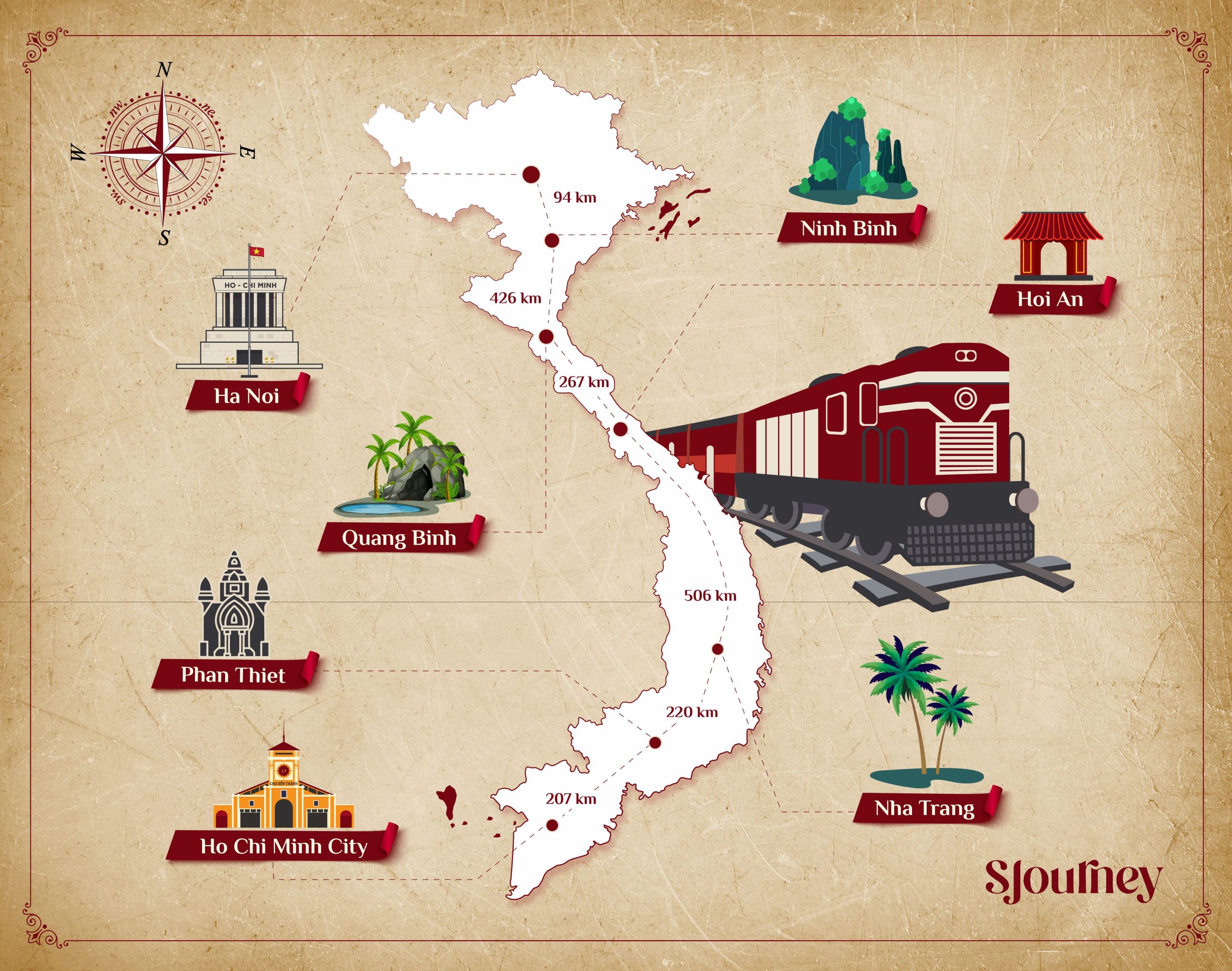
Experiences

Heritage & Culture
SJourney is a distinctive artistic journey with a unique, elegant blend of cultural hues. Passengers can admire Vietnam from a unique perspective. We anticipate every moment of the trip to be an exceptional and everlasting memory.
The SJourney train bears the mark of Indochine style – symbolizing the harmonious blend of classical Asian culture and the modern, romantic allure of French culture. Wherever you may come from, you can expect a sense of familiarity within the Vietnamese identity, which is the gift of cultural influences throughout the length of history. The journey allows you to enjoy it from your own unique perspective.
Culinary art
Vietnamese cuisine is known for its variety of fresh foods and abundance of regional spices. Therefore, Sjourney is not only a trip of cultural discovery but also a unique culinary experience.
With fresh local ingredients everyday, our talented chefs will deliver a sophisticated culinary experience with a diverse menu ranging from Western to Asian dishes. The menu is changed daily depending on the destination. We are always ready to accommodate personal preferences, dietary habits, and individual requests.
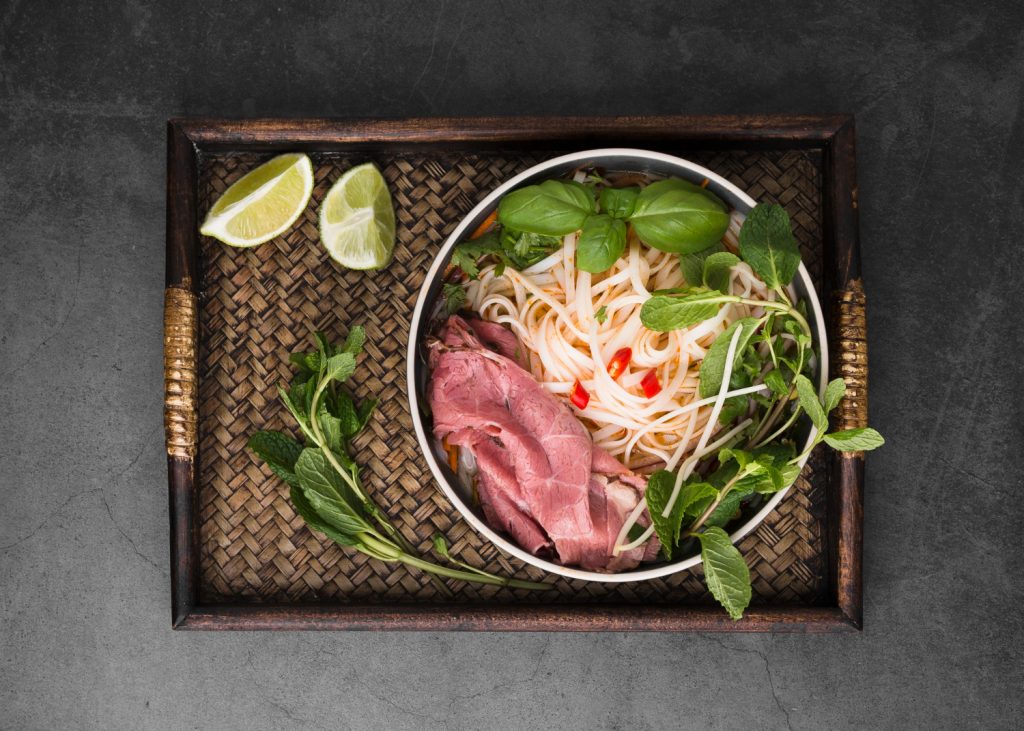
Exclusive show
Onboarding the SJourney trip, travelers not only have a well-deserved rest but also experience exclusive performances . Visitors immerse themselves in Vietnamese art imbued with national identity.
Twin cabins
Your next journey awaits….
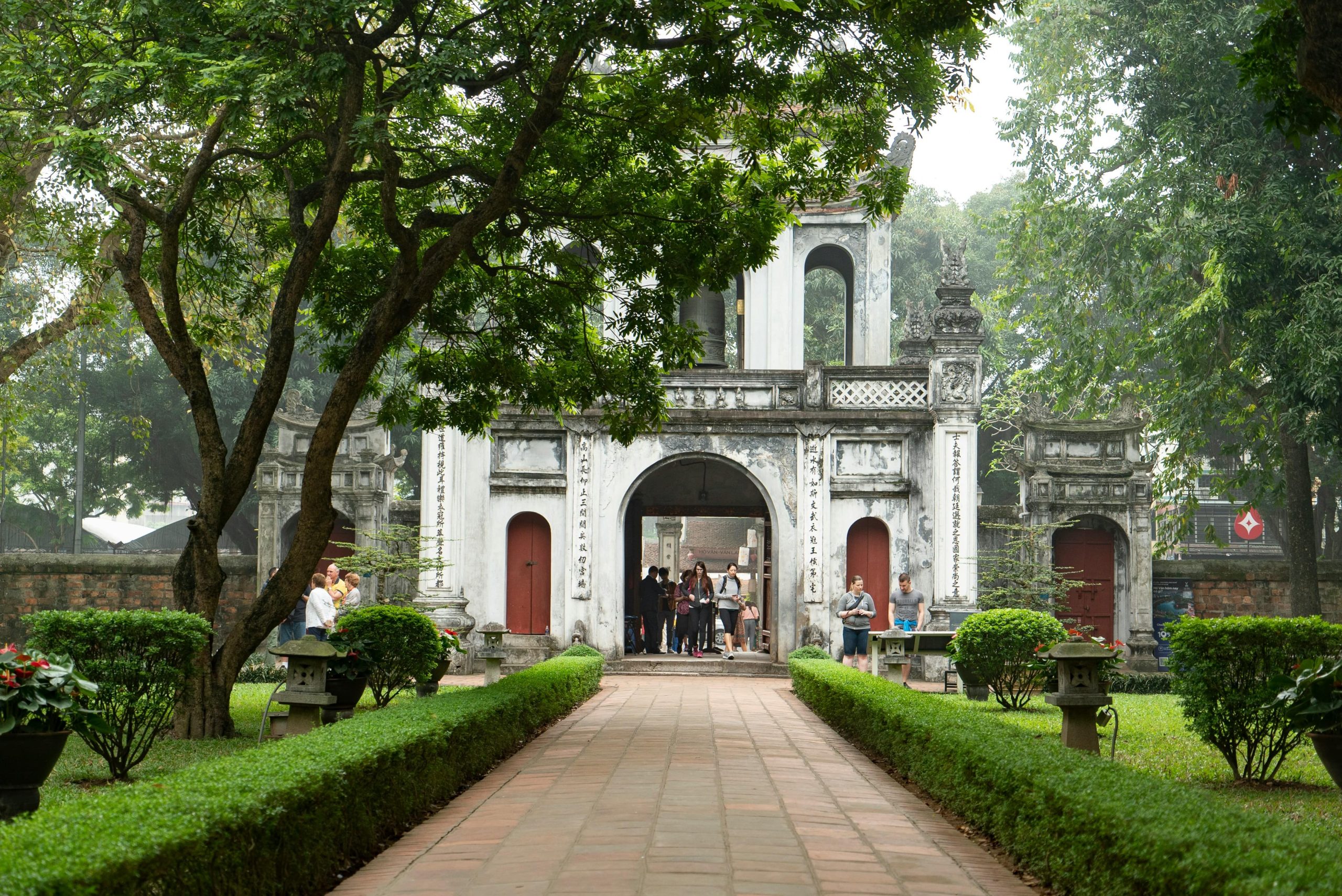
Departure From Hanoi
Welcome to Hanoi!
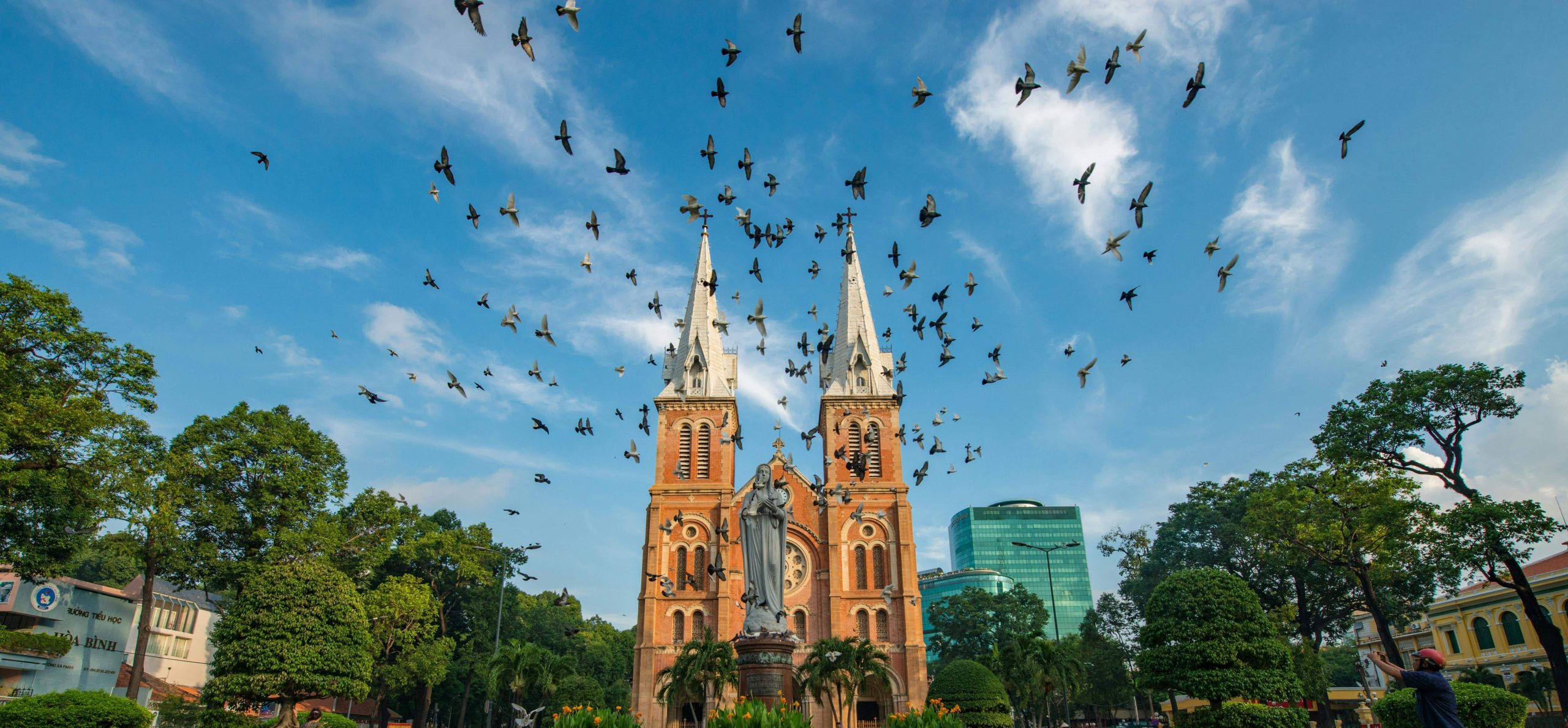
Departure From Ho Chi Minh
Welcome to Saigon !
Our Hospitality Partners
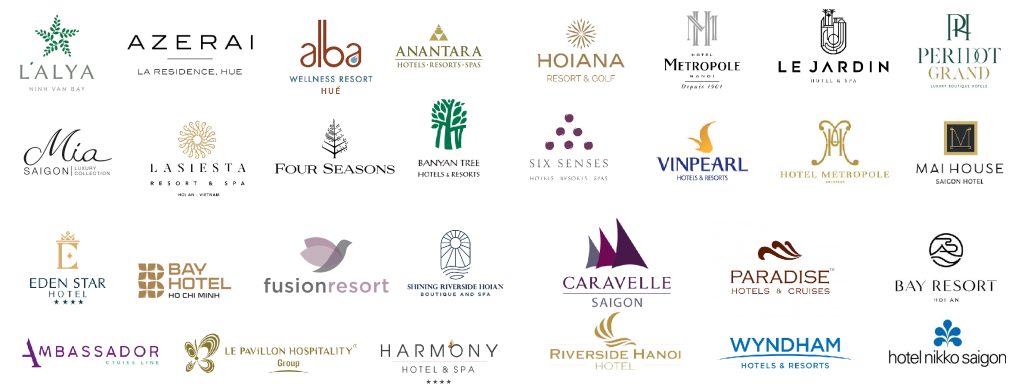
Send Us a Message
Follow us to discover more exciting details about the journey.

Username or email address *
Password *
Remember me Log in
Lost your password?
Group Tours
Vietnam Tours - 18 Day Rail Tours of Vietnam (18 days)
Cambodia Tours - The Past and The Present: Angkor to Phnom Penh (6 days)
Laos Tours - Jewel of The Mekong & Plain of Jars (7 days)
GRAND Tour of INDOCHINA - Vietnam, Cambodia & Laos (27 days)
Vietnam Tours - Ticketed Rail Tour of VIETNAM (18 days)
Vietnam Tours - 15 Day Rail Tour of VIETNAM (15 days)
Shore Excursions from Cruise Ships
From Vietnam Ports - Saigon, Nha Trang, Phu My, Chan May, Da Nang, Hai Phong, Halong, Quy Nhon (1 days)
From Cambodia Port of Sihanoukville - The Glory of Angkor (3 days)
Short Stays
Vietnam Highlights - Saigon to Sa Pa (10 days)
Vietnam Explorer - Saigon to Ha Long Bay (14 days)
Laos Tours - Jewel of The Mekong: Vientiane and Luang Prabang (5 days)
Cambodia Tours - The Glory of Angkor (4 days)
Bicycle Tours
Vietnam Bicycle Tours: 5, 8 and 12 Day Itineraries (12 days)
To contact us: Franko's Vietnam Tours 3 Hillson Grove OCEAN GROVE, VIC 3226 Australia Tel: 0414 40 30 38 Email: [email protected]
Website: www.frankosvietnam.com
W E L C O M E
...and thank you for visiting
FRANKO’S Rail Tours of VIETNAM
If you were looking for the very best way to see Vietnam , or you are a train buff, or you are interested in tours to CAMBODIA and/or LAOS , or just looking for a great holiday and a chance to do something DIFFERENT , then you can relax …you’ve found us!
Our experience of rail tourism in Vietnam is second-to-none and goes back to the very first rail tour in 1992 … long before Vietnam became a tourist hot spot. Since that time our focus has been on providing the best value rail tour holiday in Asia. We combine the experience and knowledge gained over many tours to design comprehensive, informative and fun itineraries based around our private rail carriages, good hotels, good food, hand-picked guides, and one of the most interesting rail routes in the world .
It really is the very best way to see Vietnam!
(*see FEEDBACK from earlier tour clients)
FRANKO’S Rail Tours travel the length of Vietnam by private train - from the Mekong Delta to the Red River Valley and Chinese Border . Visiting 7 different regions of VIETNAM
...an unforgetable travel experience!
STOP THE PRESS!
Hi everyone ...a quick word from FrankO.
Sorry to break in here ...just need to ensure website visitors
are advised about:
The LATEST NEWS on our Rail Tours in 2024
I can now confirm that there is now only
ONE Rail Tour of VIETNAM still available in 2024.
Tour #2 will BEGIN in early November
(Tour Dates 03 - 20 November 2024)
(Vacancies exist. Please indicate your interest early)
END of NEWS insert. Thanks!
Besides Vietnam , our tours also visit historical Angkor & Phnom Penh in CAMBODIA ; and Vientiane , Luang Prabang and the mysterious Plain of Jars in charming LAOS - please check out all FRANKO’S Tour Destinations on this site...they are tried & tested and waiting for you.
I trust that you can navigate successfully around our website to find the tour information that you desire. Should that not be the case, then please feel welcome to call/email us at any time …happy to assist you. If you notice that something is not included in our information, or is unclear, then please let us know and we’ll fix it pronto ...one never stops learning! Happy also to provide presentations for travel groups, clubs (ie Probus, Rotary), etc. Details at News/Specials page.
IMPORTANT INFORMATION on PRICING All prices on this website are in US Dollars (USD)
(USD prices converted to AUD prices at time of payment) (Non-Australian clients can pay with USD-Euro-GBP via PayPal) *See " Tour Dates & Prices " for all Tour Prices
Please enjoy our website. You might begin your visit by simply scrolling down this page to find an Introduction to our Rail Tours , plus advice on Airfares and tour sizes. Links to all FRANKO’S tours can be found in the left column on every page on this website.
I’d also recommend that you click onto Why The Train? to see just what a difference it makes in turning good tours into
unforgetable tours! Hope to see you one day on your first (or your next) FRANKO’S Tour of VIETNAM, CAMBODIA or LAOS.
Sincerely, Frank O’Brien
**** **** **** **** **** **** Take your partner on A Rail Tour of VIETNAM in 2024
A fantastic holiday awaits!
**** **** **** **** **** **** **** **** **** **** **** ****
FRANKO’S Rail Tours of VIETNAM A.B.N. 82 679 818 112 Travel Agent Licence: 32735 (AUSTRALIA)
Memento: FRANKO’S has tours for everyone:
The Retirees, The Idle Rich, The Idle Not-So-Rich, The Railway Fans,
The People Who Like it Quiet, The People Who Like a Good Time,
The People Who Like Asia, The People Who Have Never Been to Asia,
The People Who Want to Learn Something, The People Who Like Our Radio Ad! The Young-At-Heart, The Adventurers,
The Veterans, The Gastronomes, The Culture Vultures, and
Those Who Have Always Wanted to Travel to Exotic Destinations but Somehow Never Got Around to It.
Plus lots of others!
No glossy brochures ...just a Free DVD and a website
with up-to-the-minute tour information that informs and advises.
Everyone has loved THE TRAIN ...that sure spreads-the-word!
So far, so good!
LOOKING FOR A TERRIFIC HOLIDAY?
SOMETHING DIFFERENT?
Here’s a quick introduction to our most popular tour: (see full details under: Group Tours - 18 Day Rail Tour of Vietnam)
18 DAY RAIL TOUR of VIETNAM (by Private Train)
VISITING: Sai Gon - Mekong Delta - Cu Chi - Long Tan Nha Trang - Da Nang - Hoi An - Hue Ninh Binh - Ha Noi - Sa Pa - Ha Long Bay
There are many ways to see Vietnam as you travel from the Mekong Delta in the south to the Red River Delta and Chinese Border in the far north (or vice-versa), but no better way than by train. NOT just any train, but a train with our own specially prepared and staffed, private charter carriages that stay with us throughout the journey. This tour is UNIQUE.
FRANKO’S train offers the most comfortable, relaxing way to travel through Vietnam ...and it’s GREAT FUN! 18 adventure-filled days taking in the history, sights and charms offered by this beautiful country and it’s hard-working, friendly people. Experienced guides, good hotels, fantastic food, great entertainment, and sensational shopping ensures everyone is programmed to fully enjoy this once in a lifetime experience . TOUR PACKAGE includes 4 Star hotels (w/late checkouts!); ALL meals (yum!); ALL in-country transport (transfers, coach, boat & train); ALL entry fees, a day/night cruise on Ha Long Bay, a visit to Sa Pa, and the services of an experienced Tour Manager and a National Guide . Our packages can also include the option of an escorted overnight tour to LONG TAN , NUI DAT , VUNG TAU and BA RIA .
RAIL TOUR PRICES (not incl airfare). 18 Day Tour in 2024 is priced from * $4000 pp/ts (Standard). Superior Tour is * $4200 pp/ts .
* Option of 5 Star hotels on Rail Tour ...from * $5500 pp/ts with Superior Class rail.
Single Supplement cost (Single traveller/single occupancy hotel room) is $705.00 (4 Star hotels), or $1200.00 (5 Star hotels).
*See Tour Dates & Prices for all Rail Tour price options in 2024
* Consider that this is a fully escorted 18 day tour (17 nights) visiting ALL of Vietnam’s attractions, with all meals, late hotel checkouts, AND the unique advantage of THE TRAIN ... superb value!
* Almost every tour escorted by Frank O’Brien (Franko) ...a Vietnamese speaker since 1968 and a pioneer in the resurrection and promotion of Viet Nam as a tourism destination after so many years of war and hardships. Frank will introduce you to Vietnam no matter your age or personal interests ...or pay for your drinks!
*Minimum Rail Tour size is 12 persons. Maximum 26. (Av 16) Private Rail Tour Group Charter. Min 12 / Max 39 persons 18 Day Ticketed Rail Tour. Minimum 2 persons.
* Note. If minimum numbers for 18 Day Rail Tour are not reached,
FRANKO’S guarantee to provide t hose clients already booked
with an amended 18 day itinerary (same dates) based on
3 nights by train (not 5) with 2 extra nights in 4 star hotels (Hoi An-Ha Noi).
Tour will still be fully escorted. We guarantee no one will be disappointed !
AIRFARES Clients can book/purchase their airfares to/from Vietnam at the travel agency of their choice, or FRANKO’S can secure air tickets for clients under our group booking arrangements. We aim to secure best prices on offer ...as a free service. Singapore, Malaysian, Thai, Vietnam and JetStar airlines offer flights to Saigon and return from Hanoi.
Only Vietnam Airlines have direct flights to Saigon from Melb-Syd.
*Only Vietnam Airlines offer 40kg luggage allowance
*Other airlines offer 20-30kg luggage allowance
CLICK onto our 18 Day Rail Tour of Vietnam and check the Itinerary to see just where we go,
what hotels we stay at ...and how long we are there! There’s also a DELUXE version of our Rail Tour to cater for up to 10 comfort loving travellers ...who can go whenever they wish!
Tours of LAOS and CAMBODIA
Vietnam Coracle
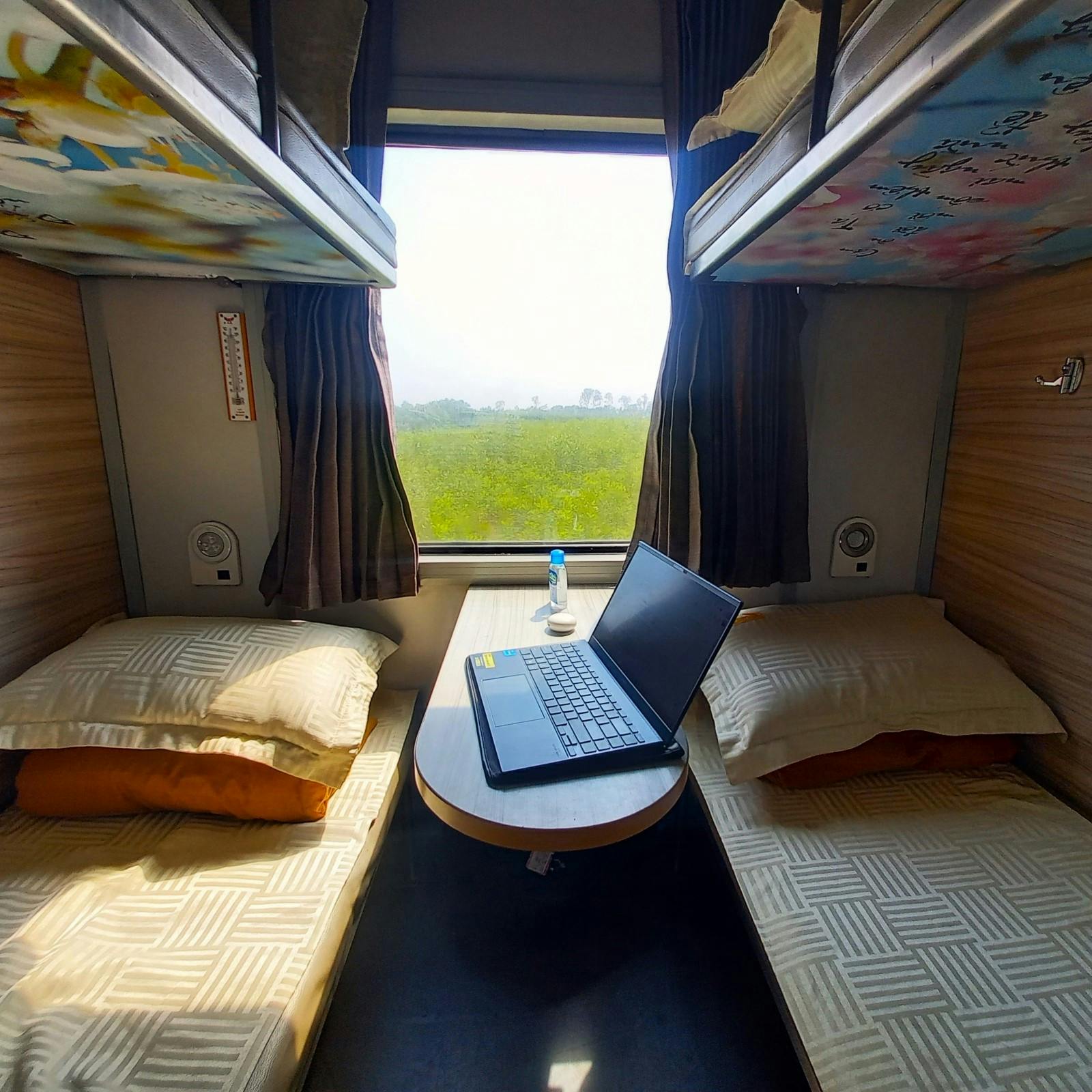
Train Travel in Vietnam: A Guide
First published July 2023 | Words and photos by Vietnam Coracle

Tom Divers is the founder and creator of Vietnam Coracle. He’s lived, travelled and worked in Vietnam since 2005. Born in London, he travelled from an early age, visiting over 40 countries (he first visited Vietnam in 1999). Now, whenever he has the opportunity to make a trip, he rarely looks beyond Vietnam’s borders and his trusty motorbike, Stavros . Read more about Tom on the About Page , Vietnam Times and ASE Podcast .
Train journeys in Vietnam are more than just a means of getting from A to B: they are an experience. On Vietnam’s railways, travellers get a genuine sense of the country and start to appreciate nation-defining characteristics, such as changes in the landscape, climate, food and accent from one region to another. Unlike taking a domestic flight, train travel is richly rewarding, providing travellers with a social, culinary and cultural experience. Taking the train in Vietnam is nothing like it is in Europe, North America, Japan or China: rail travel in Vietnam is low-tech, slow, informal, and exciting. What’s more, train travel is relatively cheap, comfortable, efficient and easy to book. If you enjoy journeys and the act of travel, you’ll almost certainly enjoy travelling by train in Vietnam.
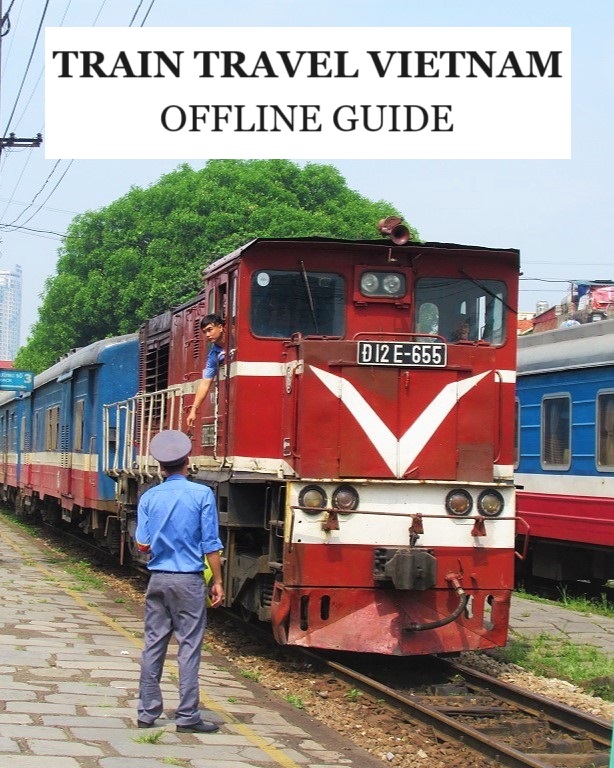
Get the Offline Guide & Map $15
- Custom-designed PDF version of the Train Travel in Vietnam guide
- Instructions to load the map to your phone & use it offline
- Full use of guide & map anywhere, anytime
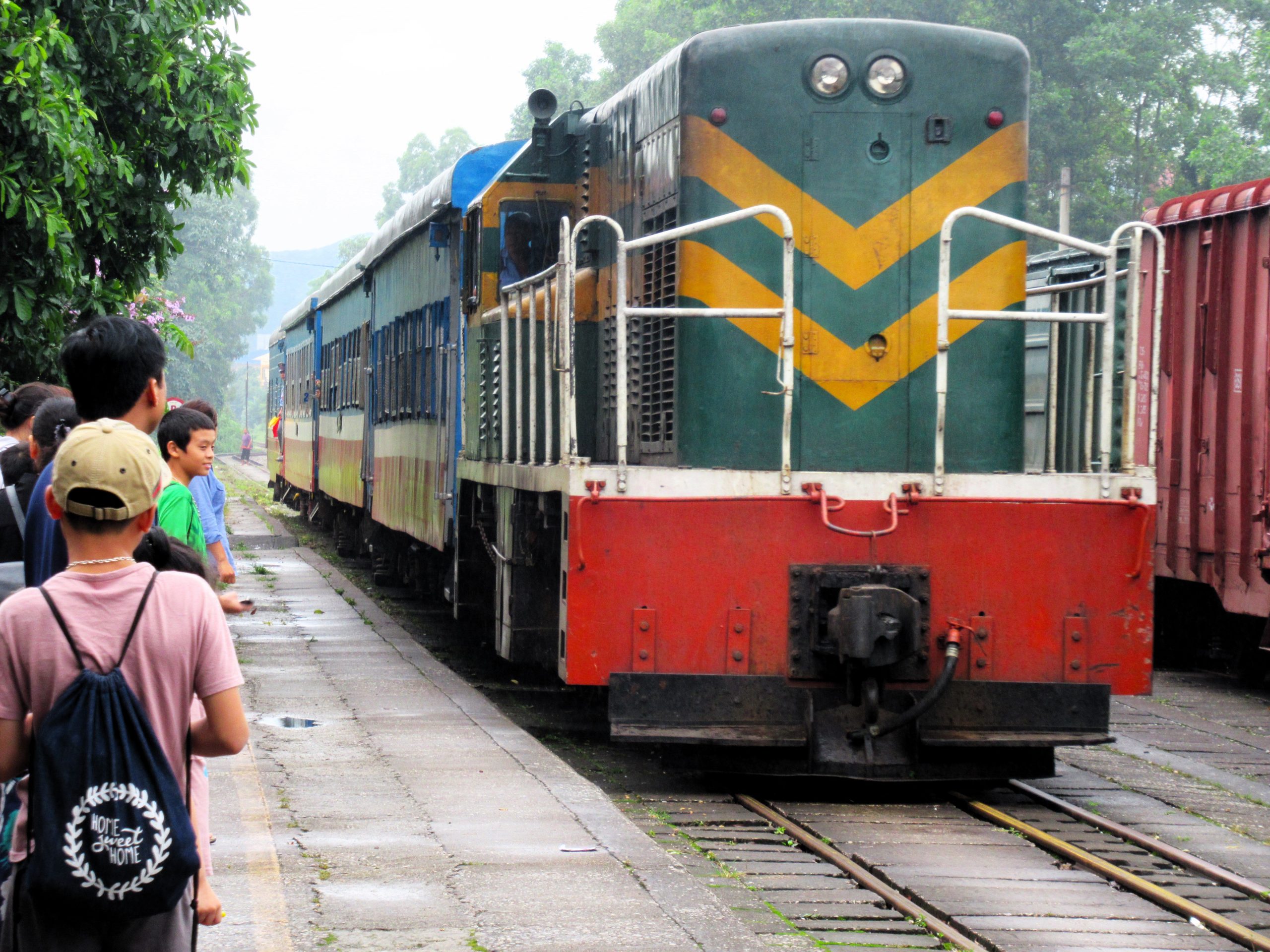
[ Back Top ]

TRAIN TRAVEL IN VIETNAM
A Guide to Riding the Railways
This guide is intended to provide travellers with a practical overview of how to travel by train in Vietnam and why it’s a rewarding travel experience. I’ve included information about train routes, booking tickets, classes of travel, food and much more in order to paint a picture of what train travel is like in Vietnam. On my map I’ve marked all rail routes and major stations, as well as some of the most scenic sections of track. You can book train tickets directly from this page using the Baolau.com search boxes and links. (For excellent historical information about Vietnam’s railways, read ‘Railways & Tramways of Việt Nam’ by Tim Doling.)
Routes & Schedules
Booking Tickets
Seating & Sleeping
Food & Drink
The Journey
Related Guides
Please Support Vietnam Coracle Make a donation or become a patron if you enjoy this website. Vietnam Coracle is totally free & independent. I do not receive payment for anything I write. Thank you, Tom
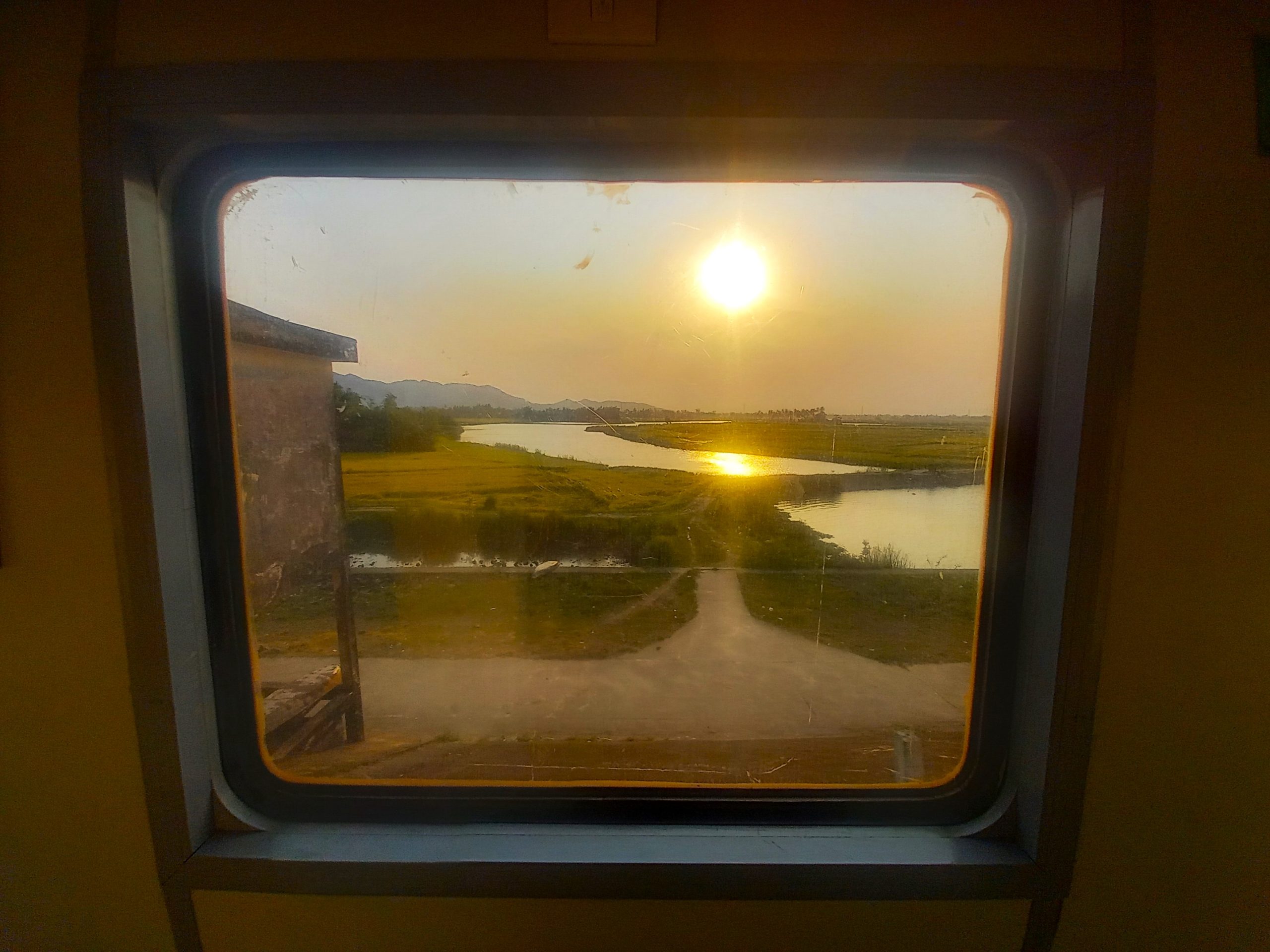
[ Back to Contents ]
Train Routes & Stations in Vietnam
ROUTES & SCHEDULES :
Vietnam Railways operates a main south-north line and several spur lines. There are dozens of potential routes and station stops across the nation: use my train map for an overview. Schedules, times and ticket prices are easy to search, browse and book using the Baolau.com search box below, or vnr.com (the Vietnam Railways website), or at any major train station where the national train schedule is displayed on large billboards.
Reunification Express ( Transindochinois ):
Vietnam’s main railway line runs from Saigon (Ho Chi Minh City) in the south all the way to Hanoi in the north, stopping at over 20 stations along the way. Roughly following the coast for over 1,700km, the south-north line connects almost all major coastal cities between Saigon and Hanoi ( see map ). This line is known today as the ‘Reunification Express’, and in French colonial times it was called the Transindochinois . There are at least 6 trains every day in both directions on the ‘Reunification Express’ between Saigon and Hanoi. The journey between the two cities takes more than 32 hours. In addition, several other trains ply specific sections of the south-north main line, stopping at smaller stations as well as major ones. You can easily check schedules, times and ticket prices by using the Baolau.com search box below or vnr.com or at any major train station.
Spur Lines:
In addition to the main south-north ‘Reunification Express’ route, several spur lines branch off to other destinations. These include: Hanoi→Hải Phòng , Hanoi→Lào Cai , Hanoi→Lạng Sơn , Hanoi→Hạ Long, Hanoi→Thái Nguyên, and Saigon→Phan Thiết . However, schedules on these spur line routes are irregular and subject to change, particularly in the post-pandemic period. Check schedules, times and ticket prices using the Baolau.com search box below or vnr.com or ask at the relevant train stations.
* Always book train tickets at least a few days in advance or more if travelling during public holidays or on weekends
SEARCH TRAIN ROUTES & SCHEDULES :

BOOKING TICKETS :
Booking train tickets is now very easy and efficient. You can book tickets directly from this page on almost all train routes in Vietnam by using the Baolau.com search box below. Type in your departure and arrival stations and the date of travel and click ‘Search’. This opens a new page with all train times and prices in all classes for that day and that route. Choose your train time and class then click ‘Book Now’. Next, choose your exact carriage, seat or sleeping birth on the train map, enter your details and make payment online. You’ll receive an e-ticket with a QR code in your email inbox which you can show to station staff on your phone before boarding the train. Your ticket has a carriage number and seat/bed number on it.
Alternatively, you can book tickets in-person at any train station, but not much English is spoken, or you can use vnr.com (the Vietnam Railways website) to make a booking, but their site is not as good or as easy to use as Baolau.com . (Note that there’s a small service charge with Baolau.com , but this is a very small price to pay for the convenience of using their system.)
BOOK TRAIN TICKETS :

SEATING & SLEEPING :
There are 4 ‘classes’ of seating and sleeping on Vietnam’s railways (see below for descriptions and photos of each one). Which class you choose depends on the length of the journey you’re taking and on your budget. Most trains on most routes (even shorter spur routes, such as Saigon→Phan Thiết and Hanoi→Lào Cai ) offer both seating and sleeping compartments. As a general rule, seating is fine for daytime journeys under 8 hours, but sleeping compartments are better for night trains or any journey over 8 hours. The 4 classes are:
- Hard Seat (fan)
- Soft Seat (air-con)
- 6-Bed Sleeper (air-con)
- 4-Bed Sleeper (air-con)
SEARCH TRAIN TICKETS :
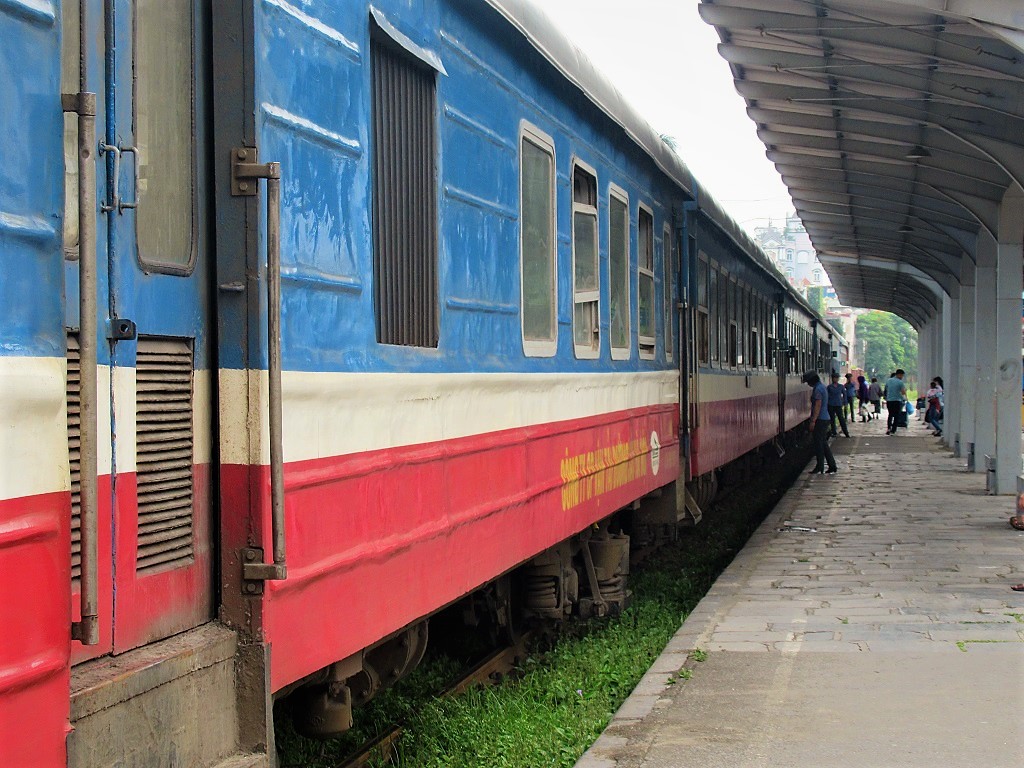
[ Back to Classes ]
Hard Seat :
Typically the last couple of carriages on a train, the hard seat class is the cheapest and sparsest available on Vietnam’s railways. The wooden seats are absolutely fine for shorter journeys, such as Hanoi→Hải Phòng or Hanoi→Lạng Sơn . But on longer trips the carriages, which are fan-cooled, not air-conditioned, can become stuffy and uncomfortable. However, the ambience is informal and social: families with kids playing in the aisles, picnics on the floors, and chickens in cardboard boxes. On short hops this can be a good experience; on long-hauls it can be a test of endurance.
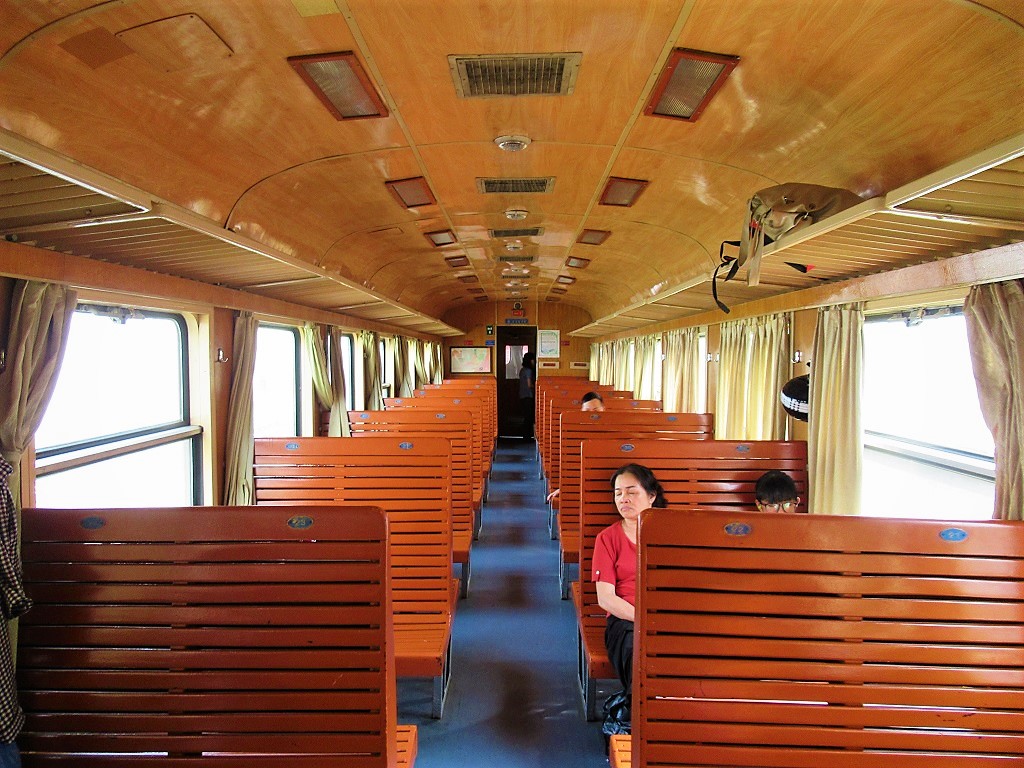
Soft Seat :
Soft, coach-style seating on reclinable chairs in an air-conditioned carriage, the soft seat class is ideal for daytime journeys of a few hours or more. Comfortable, cool, bright and spacious, most passengers will be fine in one of the soft seats for any medium-length journey. The windows are large, the ceilings are high and the air-con is effective. Ticket prices are reasonable and more affordable than sleeping compartments, but if you’re travelling overnight, don’t expect to get too much sleep in a soft seat. For daytime journeys on routes such as Huế→Đà Nẵng, Saigon→Nha Trang, Quy Nhơn→Đà Nẵng, soft seat class is all you need.

6-Bed Sleeper :
Separate air-conditioned compartments of 6-beds connected by a common aisle, this class allows passengers to lie down in comfort, but it can feel a little cramped if all 6 beds are occupied. The beds are arranged in two rows of bunks. Try to avoid taking the top bunk bed, which has very little space between the bed and the ceiling and can be mildly claustrophobic on long journeys. On night journeys, the middle bunk is best for sleeping, but on day journeys, the bottom bunk is best for comfort, because you can sit-up or lie-down and see out of the window. In my opinion, 6-bed sleeper class is good for shorter overnight journeys, such as Hanoi→Lào Cai or Saigon→Nha Trang. There is also good potential for social interaction as you are sharing quite an intimate space with 5 other passengers. Clean linen, a blanket and a pillow are provided.

4-Bed Sleeper :
The most comfortable class on Vietnam’s trains, these sleeper compartments have 4 beds in a private cabin arranged in two rows of bunks. The beds are comfy, the air-con is powerful (bring a sweater), there’s plenty of space on the top and bottom bunks, and it’s a cozy place to be for a long rail journey. Clean linen, blankets and pillows are provided, there’s a power outlet and USB charger for electrical devices, and each bed has its own reading light. Although the bottom bunk is slightly more expensive, if your main concern is sleeping, you should opt for the top bunk . This is because when your head is on the pillow on the bottom bunk you can hear and feel every bump on the tracks. My advice is: on a long night train, book the top bunk and enjoy a decent night’s sleep; for long journeys during the day, the bottom bunk is better for looking out the window, sitting at the table and working on your laptop. For long-haul rail journeys in Vietnam, such as Saigon→Đà Nẵng, Hanoi→Huế, or Saigon→Hanoi, the 4-bed sleeper class is by far the most comfortable and romantic.
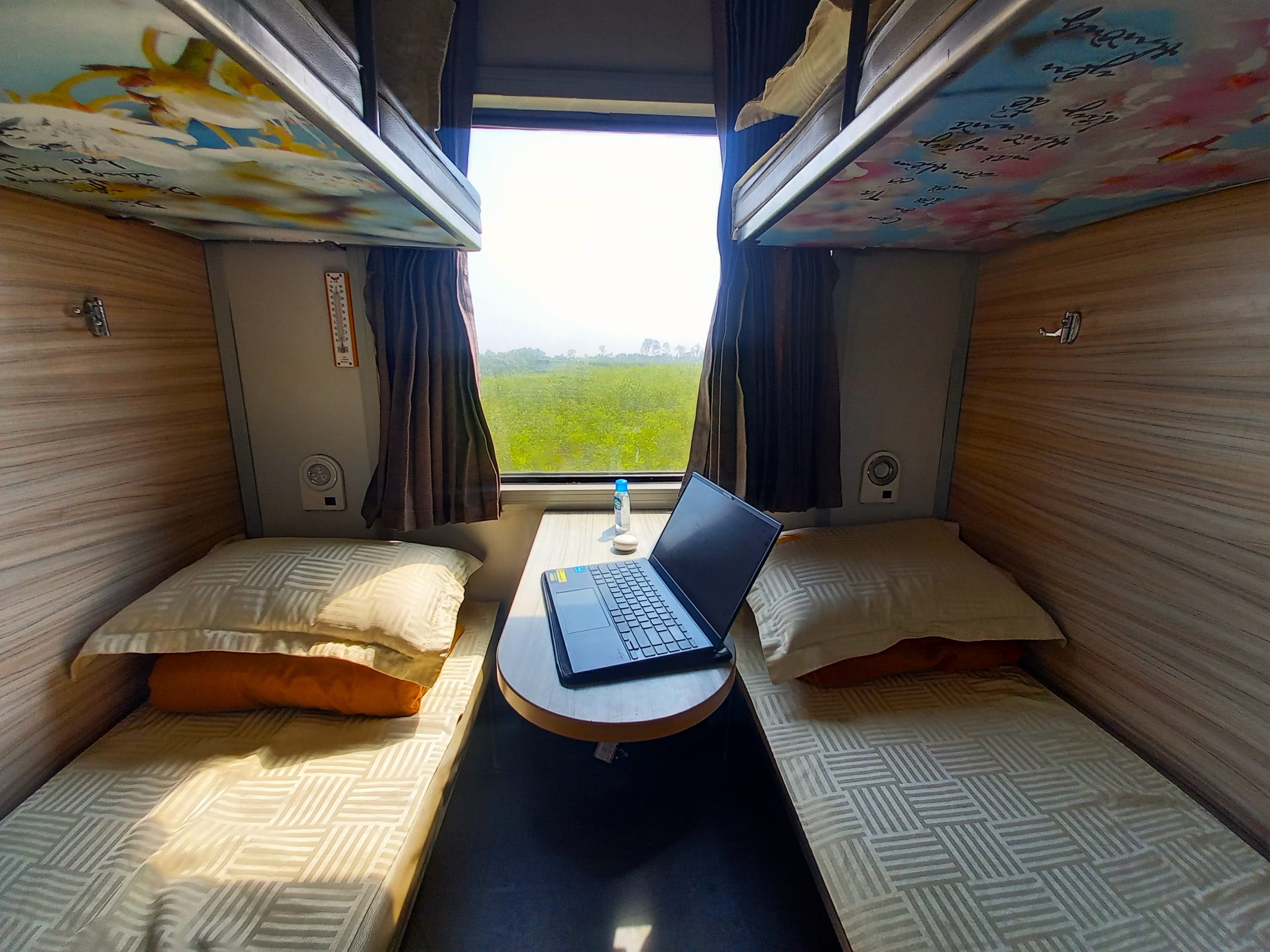
FOOD & DRINK :
Eating and drinking on Vietnamese trains is nothing like it is on European or North American railways. Vietnam’s dining culture is sophisticated, regionally diverse, highly social, affordable, and oftentimes very informal. This is as much the case on the railways as it is in normal, everyday life. Most trains have a dining car (usually towards the back on the train), food and drink trolleys which regularly ply the aisles in all classes, and a hot water dispenser at the end of every carriage. In addition, passengers are allowed (and the majority do) to bring their own home-cooked picnic food onboard for the journey. If that weren’t enough, vendors board trains at stations, walking up and down carriages shouting their wares – hot, local specialities – for a brief few minutes before the train departs. Finally, all stations have at least one coffee shop, a convenience store and food outlet.
As is the case in most culinary contexts in Vietnam, travellers with an adventurous palate, few dietary quibbles, and an open mind will get the most out of their dining experience on Vietnamese trains. Leave your preconceived ideas of dining etiquette, cleanliness and ‘morality’ at home.
There are several ways to eat and order food on trains. If you bring your own picnic , you may consume it at your seat or sleeping birth, but not in the dining car. The dining cars (some of which are fairly grimy) only seat about a dozen passengers and they can become quite rowdy and cramped at mealtimes. However, there’s something undeniably romantic about railway dining cars. Sit down and order a drink (coffee, soda, beer), a snack (hard boiled eggs with salt and pepper, fresh green, sour mango) or a meal (hot phở or hủ tiếu noodles or steamed rice with stir-fried vegetables, meat, fish and soup) and watch the landscape roll by.
Alternatively, wait for the meal trolleys to reach your seat or sleeping compartment. Fresh rice meals ( cơm ) are served from a large ‘hot trolley’, including a huge vat of piping hot steamed rice and half a dozen dishes to choose from. These are all on display, so passengers can easily point and order. Typically you’ll find the following dishes: stewed pork ( thịt kho ), marinated pork cutlet ( sườn ), pork rolled in aromatic betel leaves ( chả lá lốt ), fried fish ( cá chiên ), and fried spring rolls ( nem rán ). Prices are 50,000-100,000vnd ($2-$4) per meal. Although there aren’t really any vegetarian or vegan options, you can try saying Tôi ăn chay (I’m vegetarian). All the food is freshly cooked, unlike the factory-prepared, vacuumed-packed items sold on UK trains, for example.
In addition, regional specialities are loaded onto the train at different stops along its route and then sold to passengers. This is a remarkable, unique, endearing and very Vietnamese aspect of railway dining. Some examples are: steamed whole corn on the cob at Long Khánh station from the fields outside your window; wonderfully exotic dragon fruit at Bình Thuận station from the plantations you can see from the train; bánh nậm (delicate steamed rice cakes) at Huế station; and nem chua (delicious cured pork sausages) at Thanh Hóa station.
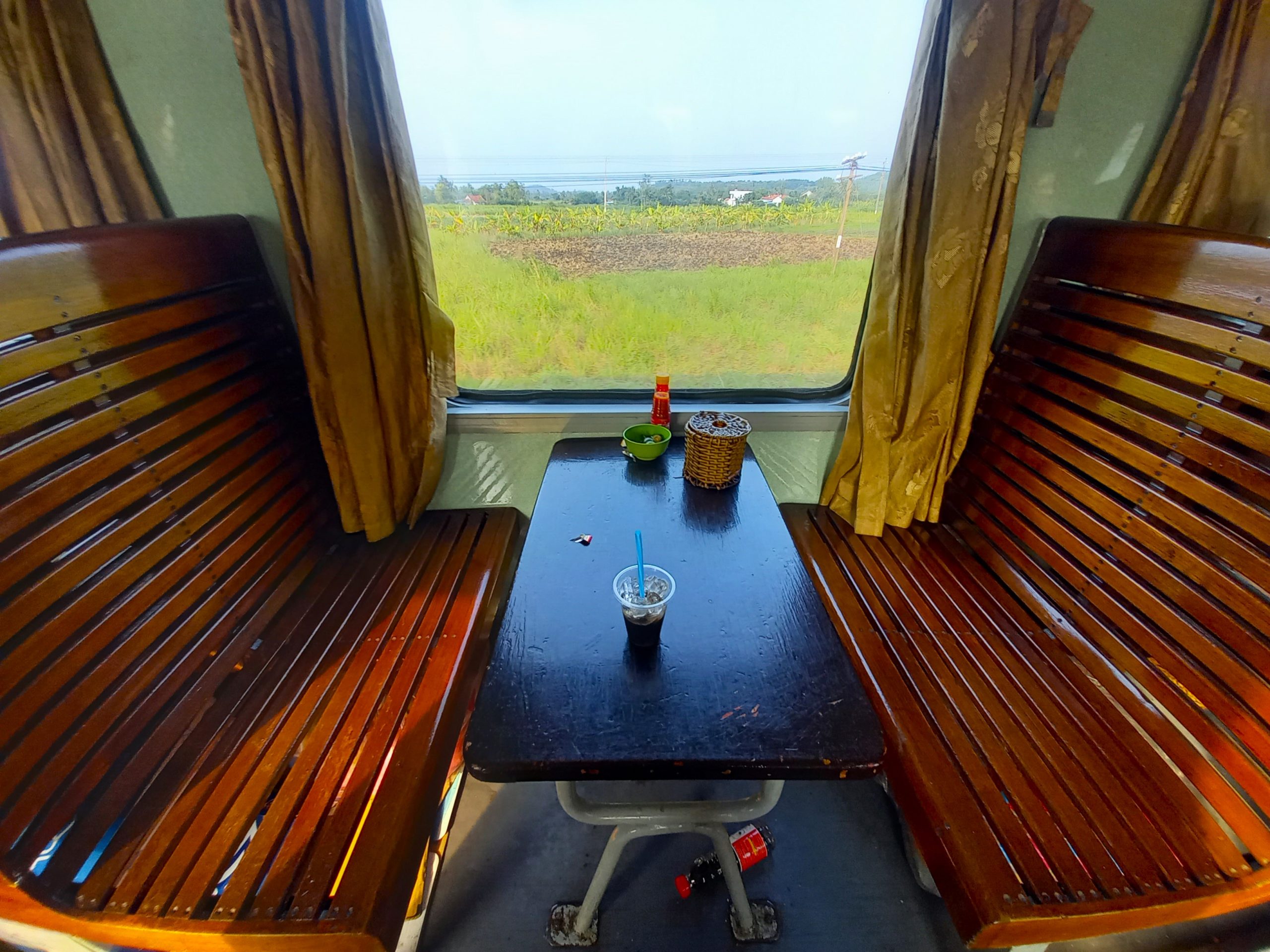
THE TRAINS :
Trains on the main south-north line between Saigon and Hanoi are large and long, usually 10-15 carriages in length with capacity for several hundreds of passengers. Trains on spur line routes are generally shorter, sometimes only 3-4 carriages in length, depending on the route. The trains are pulled along the rails by enormous diesel locomotives resembling the ones you might see in an old Soviet propaganda poster. I don’t know enough about trains to name or date the carriages and engines, but I suspect they’re not particularly modern; many are probably reused carriages from old Chinese and Russian trains, but that’s only a guess.
The carriages, painted white, blue and red on the exterior, are wide, high and spacious and the level of cleanliness is acceptable, if not exceptional. Most of the carriages are functional and coach-like, but sometimes they can be cozy and very comfortable. Some of the dining cars are romantic-looking wooden compartments, like something from the U.S. Pacific Railroad in the 1870s, but others are bleak and utilitarian in appearance. The dining car tends to become the train’s ‘pub’ on long journeys: loud, drunk men, cigarette smoke and a boisterous atmosphere.
Toilets vary considerably from carriage to carriage, regardless of what class you’re in, so it’s worth walking up and down the train to find the ones in best condition. There are both ‘sit-down’ toilets and ‘squat’ toilets. Wash basins are located at the end of each carriage and are fine for washing hands and brushing teeth.
Staff range from young twenty-somethings to old, weathered-looking ‘lifers’, who’ve been working on the rails for 40 years. The railway is state-run and I would guess wages aren’t high, nor is it a glamourous job. It shouldn’t be a surprise, therefore, that some staff, particularly older ones, can be rather brusque with foreign passengers. However, smiling and patience go a long way in Vietnam and I’ve met some remarkably kind, gracious and helpful staff on Vietnam’s trains. The general level of ‘customer service’ is informal, polite and well-meaning.
BOOK YOUR TRAIN JOURNEY :
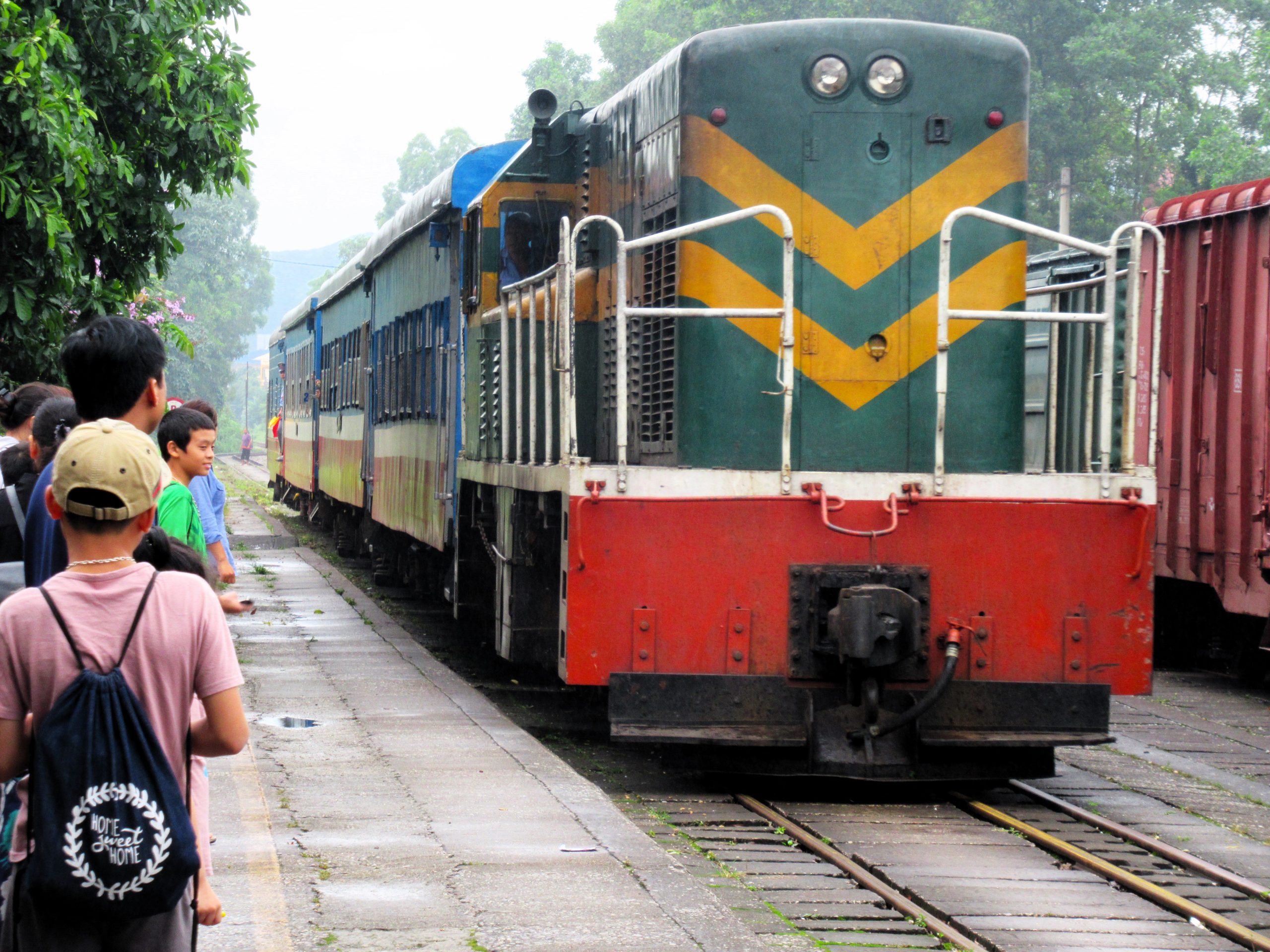
THE JOURNEY :
Departing from train stations in Vietnam is always exciting, but particularly on early morning departures or night trains. There’s an atmosphere on the platform: the sound of the locomotive humming as if steeling itself for the long journey ahead; the flow of people through the station entrance and into the carriages; the sense of expectation; the hoot of the horn before departure; and the slow, grinding shift of motion echoing from carriage to carriage as the train crawls out of the station. Moving through the city at processional speed everything stops to let the train by, watch it go, honour it as it passes: traffic on the city’s busy arteries comes to a standstill at level crossings, pedestrians look up from their meals, stop their work, look out of windows trying to catch a glimpse of the train as it parades by.

Unlike highways, the railway passes through rural areas without anything between the track and the landscape. On the south-north main line in particular, because of Vietnam’s unique geography with the coastal plains to the east and the Trường Sơn Mountains to the west, the scenery is often sublime. There are moments when the track echoes the coast and the train comes within metres of the ocean; at other times, the railway detours inland through bright rice paddies with purple mountains looming behind. On long train journeys in Vietnam you get a real sense of the size, scale and topography of the nation. The train travels at just 50-80kmph – an ‘understandable’ speed – which allows you to study the landscapes in detail. Whether lying in your sleeping birth gazing out the window at an ocean vista, sitting at a wooden table in the dining car with a coffee as a monsoon shower passes over the train, or reclining in your seat staring at a waterway winding into the mountains, there’s some sensational scenery to be seen on Vietnam’s railways.

Train travel in Vietnam can be a social experience, even if travelling alone. Sharing a sleeping cabin for many hours with several strangers is an inherently intimate situation which lends itself to social interaction with your fellow passengers. I’ve met people on Vietnam’s trains many times. One of the endearing qualities of Vietnamese life is the informality of social situations. The train is no different. Children play in the aisles, teenagers huddle on top bunks with their phones, business people tap away at their laptops, extended families of eight people bundle into 4-bed compartments for a picnic lunch of grilled chicken and sticky rice, while older men stand in the narrow gap between carriages puffing on cigarettes. The charm and social cohesion you often see and experience with Vietnamese street life also takes place on Vietnam’s railways.

Taking the train in Vietnam is much more than a means of transportation: it’s an experience, and one which, for travellers, can begin to illuminate aspects of Vietnamese life and culture. From the landscapes outside the window you get an impression of the terrain and geography of Vietnam; from the passengers that come and go from your cabin you get a sense of different regional accents; from the local speciality food sold on the train at different sections of the route you get an idea of the culinary diversity of Vietnamese cuisine; from the weather – the sun that bakes the carriages, the rain that lashes the train – you begin to understand Vietnam’s complex climate from southern to central to northern regions; and you even get a sense of history from the French colonial-era stations, the Cham temples at Tam Kỳ and Diêu Trì, and the multitude of pagodas and churches you see along the way. All this is in addition to the universal magic of travelling by train, such as lying down in your bunk bed and being rocked to sleep by the rhythmic rattle of the rails and occasional howling of the horn in the night.
BOOK A TRAIN JOURNEY IN VIETNAM :
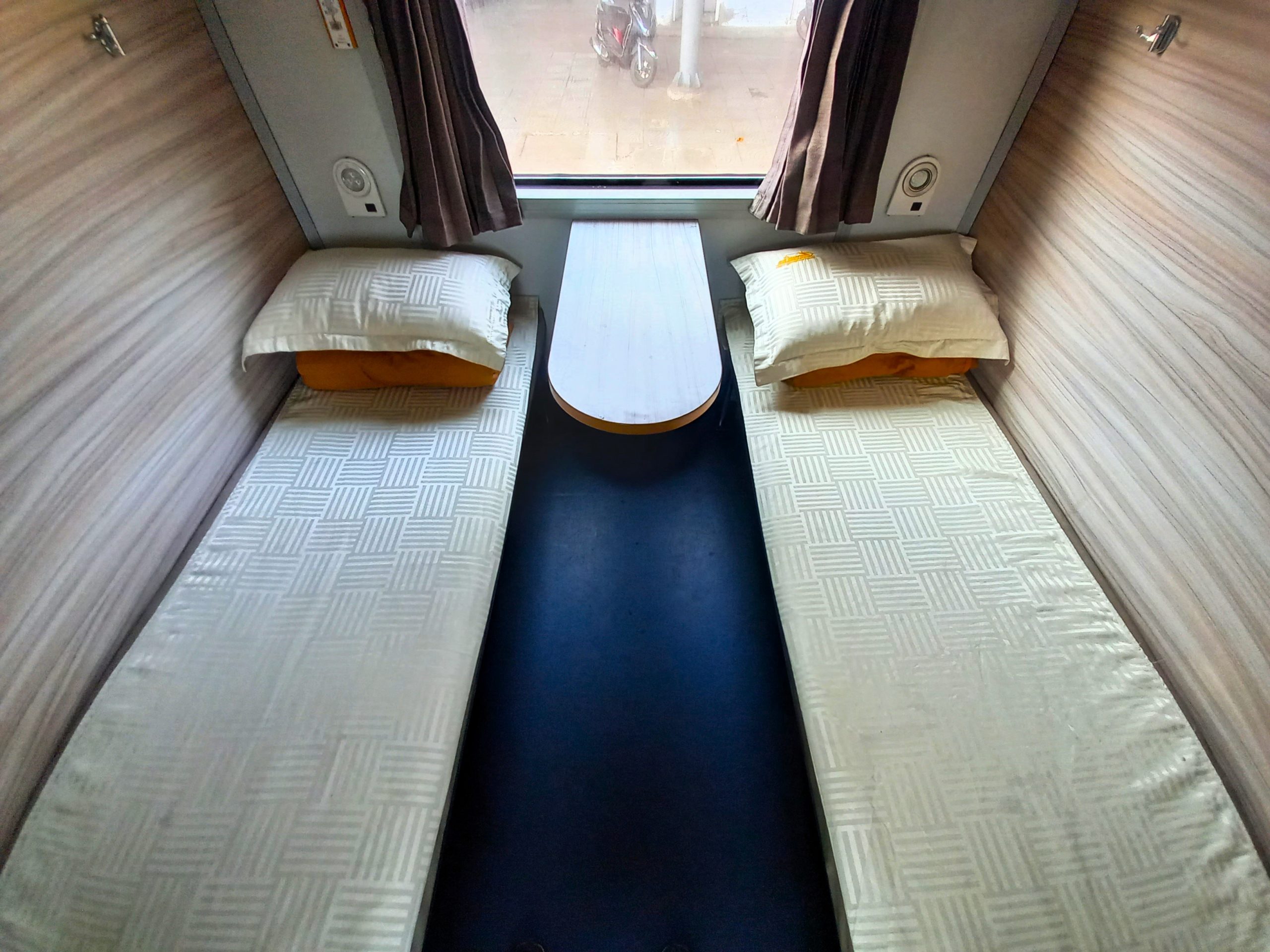
* Disclosure: I never receive payment for anything I write: my content is always free and independent. I’ve written this guide because I want to: I like train travel in Vietnam and I want my readers to know about it. For more details, see my Disclosure & Disclaimer statements and my About Page
RELATED GUIDES :
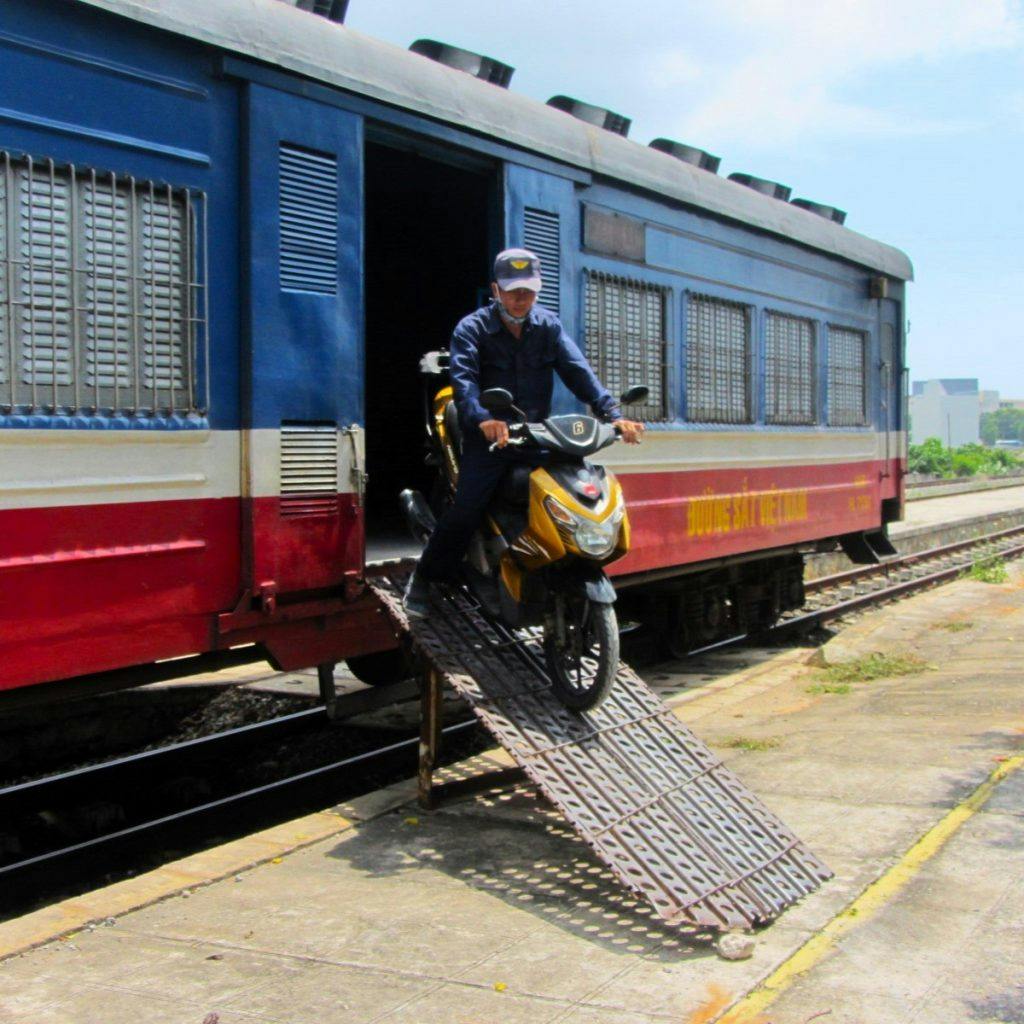
How to Send a Motorbike on the Train
Put your motorbike on the train & send it from one destination to another. This is a convenient, reliable & efficient service for riders in Vietnam…
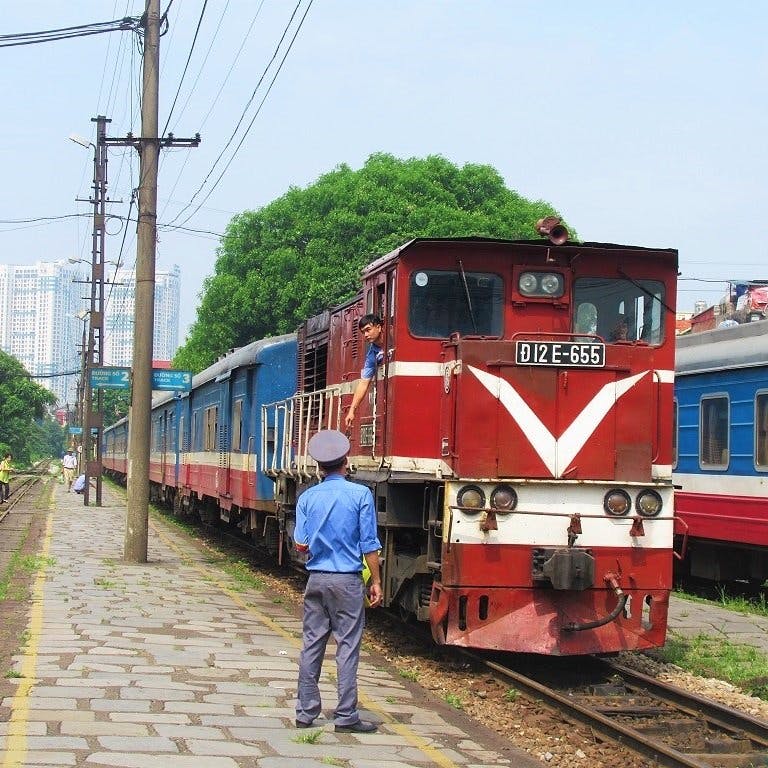
Hanoi to Hai Phong by Train: Passengers & Motorbikes
The Hanoi↔Hai Phong train is a brilliant option for travellers with motorbikes looking to get from the capital city to Cat Ba Island (or vice-versa), without having to negotiate the horrible highways….
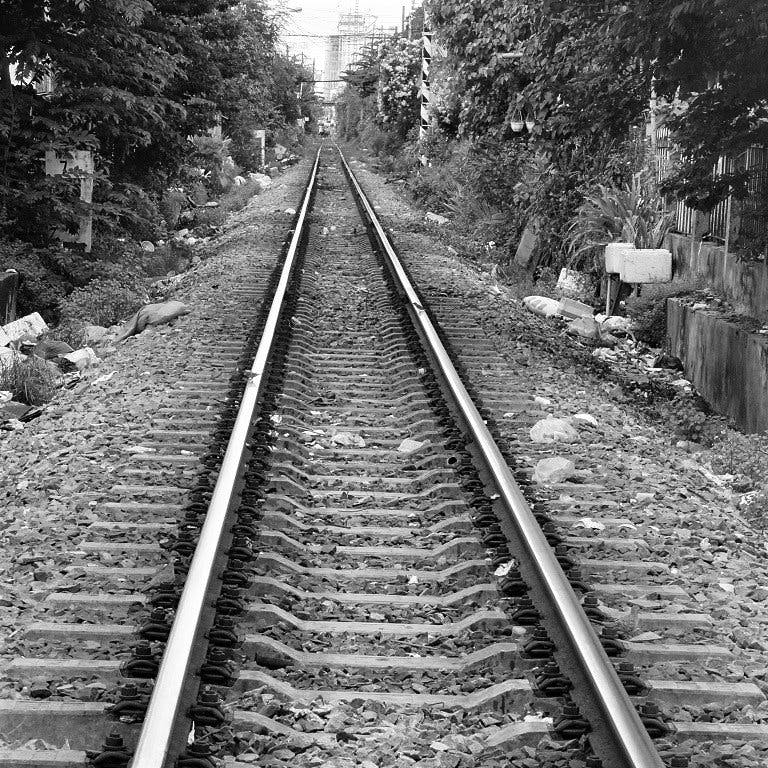
Exploring Saigon’s Railway Tracks: A Guide
Lined with intriguing architecture, temples, shrines, pagodas, fruit trees, flowers, cafes, casual dining & other such urban miscellanea, exploring the lanes alongside Saigon’s railway tracks, on foot or on two wheels, is a fascinating experience….
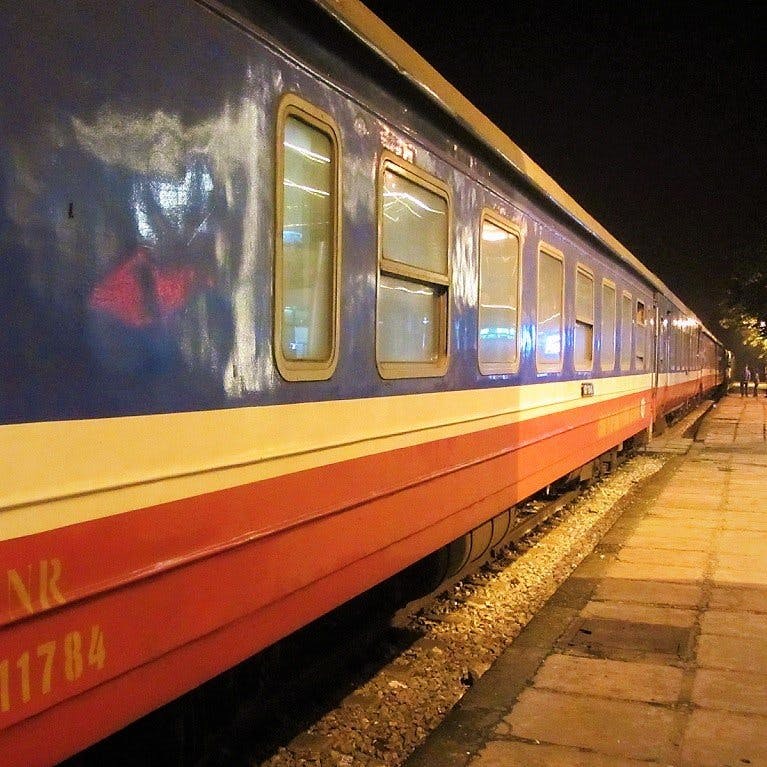
The Fanxipan Express: Hanoi to Lao Cai by Train (Passengers & Motorbikes)
Rattling through the night from the capital city, along the Red River Valley, and into the northwest mountains surrounding Lao Cai on the Chinese border, the Fanxipan Express is a romantic rail journey that’s cheap, comfortable & easy to organize….
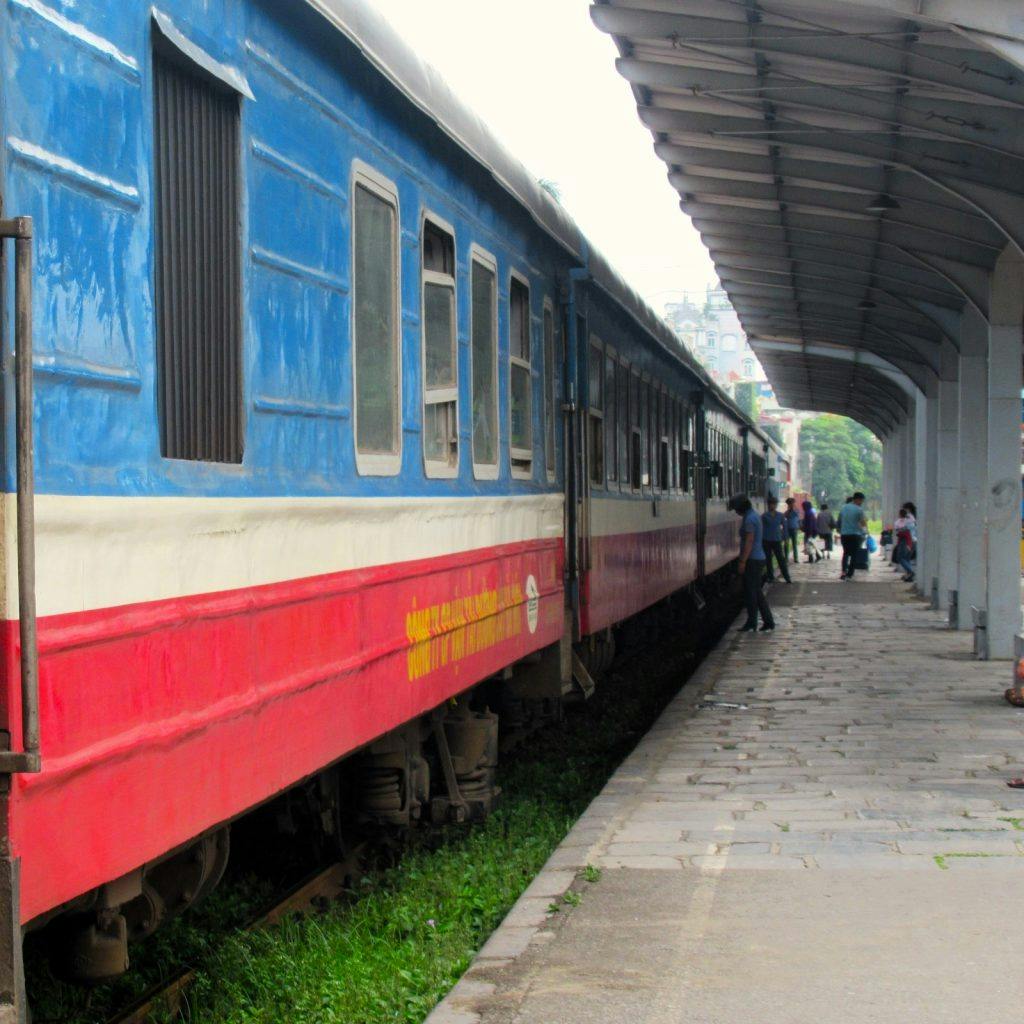
Saigon to Phan Thiet by Train: Passengers & Motorbikes
The daily, non-stop express train between Saigon & Phan Thiet/Mui Ne is a cheap, easy, fun, fast & efficient way to get from the city to the beach. Put your motorbike on the train with you & let the rails carry your wheels….
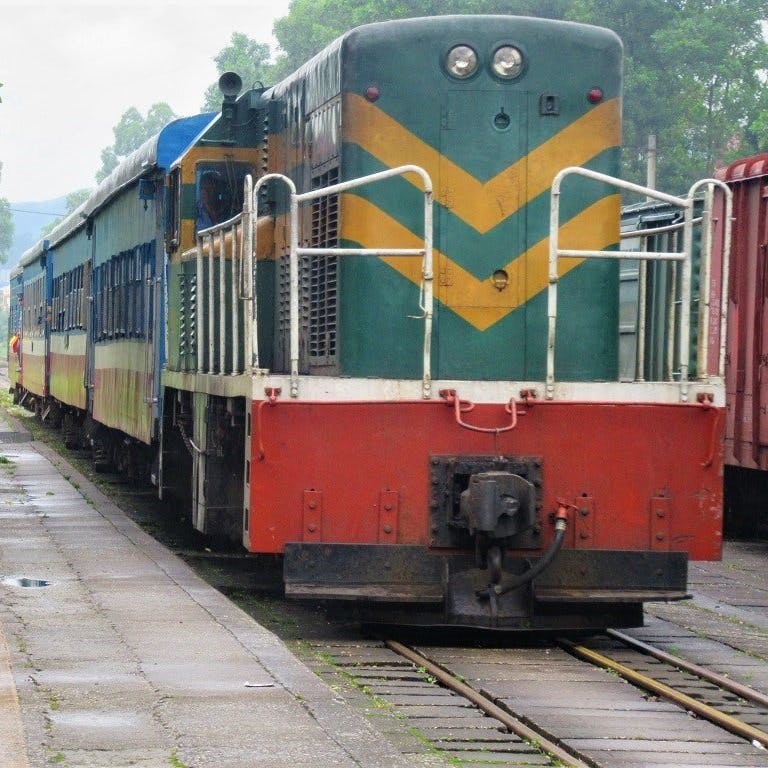
Hanoi→Lang Son→Dong Dang by Train: Passengers & Motorbikes
A train runs once daily in both directions between Hanoi, Lang Son & Dong Dang, on the Chinese border. Linking Vietnam’s capital with its mountainous northeastern provinces, this is a scenic rail journey & passengers can carry their motorbikes on board
Questions, updates and trip reports are all welcome. However, please keep comments polite and on-topic. See commenting etiquette for details.
Hi Tom, We are travelling from Hanoi to HCMC. Are there sleeper cabins on a ‘better’ side? There will be 3 of us travelling. 🙂 Belinda
Hi Belinda,
Sleeper cabins are generally only on one side of the train, so you don’t have a choice. Either way, the view from the train should be good/interesting 🙂
Great content! Might be a stupid question but is there any difference between the North to South train or the South to North train? Thanks
Sorry for my slow reply – my computer was broken.
No, there’s no difference between the north-south train and the south-north train: they are the same trains.
Im looking to train journey in vietnam.is it possible to get a train journey sllowing me to stop at a town enroute for a few days n continue my journey???thank you
Hi Raymond,
Just buy your train tickets separately for each leg of your journey. For example, buy a ticket from Ho Chi Minh to Danang, then buy your ticket from Danang to Hue, etc.
Hi tom.. many thanks for taking time to reply to me much appreciated. Ray,
Been waiting several weeks for the Baolau prices to load for the dates I want to travel–still says “not yet open”– but they have been up the whole time on the Vietnam Railways website. Also curious, the times and fares differ fairly dramatically from Baolau to VR for the exact same dates and routes. In an email response from Baolau, they said that the times and fares can be different and to check schedules carefully before travelling. I would like to use Baolau based on your hearty recommendation AND the fares appear (who knows why!) to be about 3x cheaper, but I am wary because of the discrepancies. May be best to just book directly through the carrier and not try to get a deal…?
Hi Jennifer,
I’ve never had any problem booking with Baolau before. It is generally more user-friendly than the Vietnam Railways website, especially for travellers without prior experience of Vietnam.
What time period are you trying to book for? If it is a public holiday, then that might be the reason for the discrepancies in fares.
April 13 us quite close to the King Hung holiday, which is April 18 in 2024, so that might be a reason why there’s conflicting information on trains and prices, however that seems unlikely.
Hi, we are an older well travelled couple, I do all the planning and organizing and am thinking of grabbing our backpacks, flying into Vietnam and just hitting the road (tracks)? We both travel light, this sounds like a fun holiday for us. What do others think?
Sounds like a good idea to me!
Thank you for this well written and detailed article. My husband and I are planning our first trip to Viet Nam. As we always try to build trips around train travel, you’ve provided the foundation for our trip.
Thank you! I hope you and your husband enjoy your trip.
There are also a couple of 2 sleeper cabins on SE2 between HCM and Hanoi.
Oh great. I’ve seen the 2 bed sleeper cabins a couple of times, but didn’t know it’s specifically the SE2 train that has them.
Wonderful, well written article – informative, but also conveying so much emotion about the experience
Thank you, Greg! Glad you enjoyed it.
Really nice piece Tom – makes me determined to return to the rails after far too much flying in Vietnam. The train’s are always a memorable experience ! May I recommend that Hanoi – Nanning route which I’ve used several times now if only for the border pantomime !
Thanks, David.
I’ve always wanted to try the rail journey across the border into China, but haven’t done it yet, although I have been to the last stop in Vietnam, at Dong Dang – great station!
You are using an outdated browser. Please upgrade your browser to improve your experience.
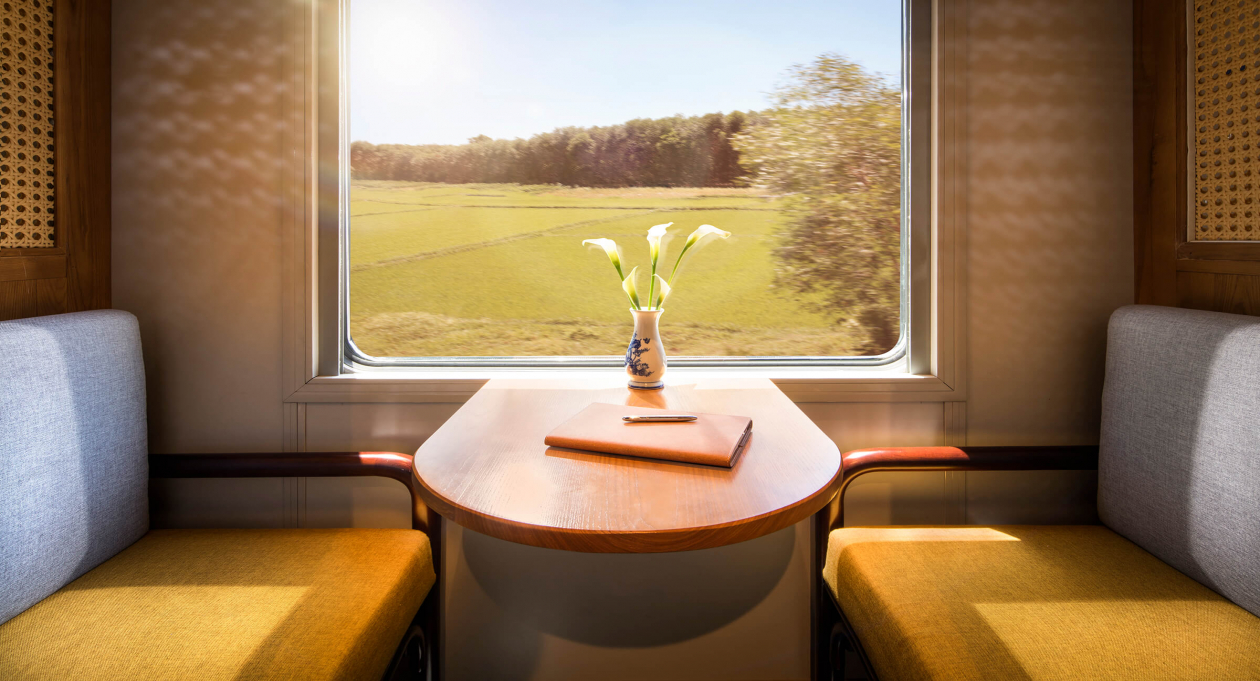
- The ultimate luxury train experience in Central Vietnam
When it comes to bucket-list travel experiences, taking a trip on a luxury train is right up there. There’s just something about travelling by train that’s filled with nostalgia and romance; evocative of simpler, slower days gone by. The sound of the train on the tracks, the rhythmic pace, and the ability to gaze out at the countryside, lost in thought, contributes to a vintage experience few wouldn’t want to savour. Add gourmet dining, VIP treatment and facilities, and you’re sure to arrive at your destination feeling refreshed, pampered and inspired.
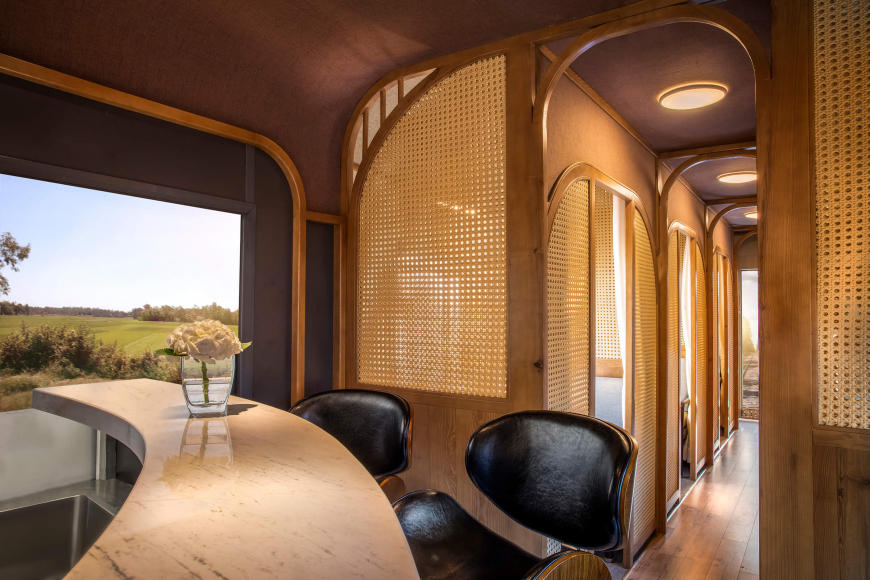
Source: thevietagetrain
Want to experience a first-class train ride through stunning Central Vietnam landscapes, without having to overnight? Be transported back in time on The Vietage, a luxury train ride that goes between two of Vietnam’s best beach destinations, Danang and Quy Nhon.
The Vietage
Starting in Danang in the morning and returning in the evening, the 318-kilometre (six-hour) journey takes you along part of the country’s historic “reunification line”, passing through Tra Kieu, Tam Ky, and Quang Ngai stations. On the way, you’ll get to admire the beauty of Central Vietnam, with its vivid green rice paddies, verdant mountains and sparkling coastline.
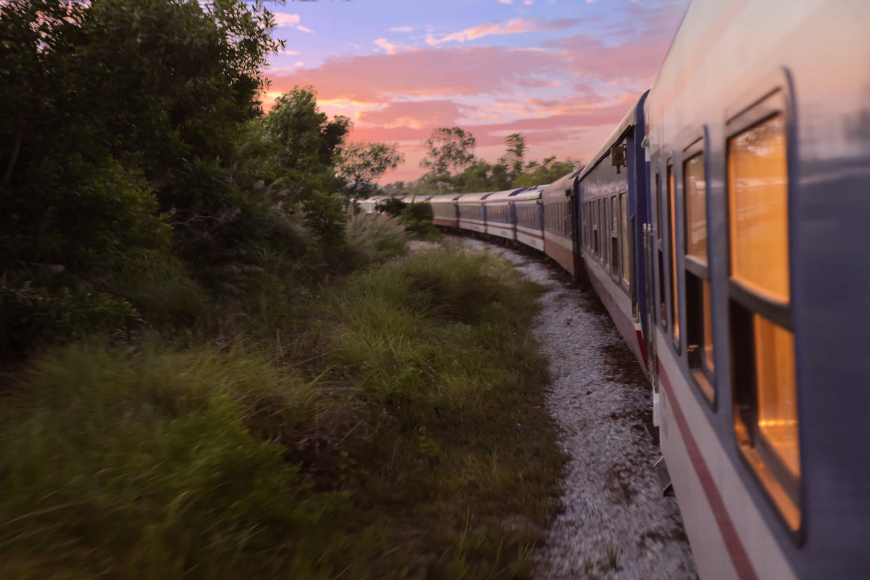
When CNN named this train ride among Asia's six most amazing rail journeys, they said: "The scenery is as peaceful as it is lush: water buffaloes graze in wide-open fields, humble villages flit by and impossibly green fields beg to be photographed."
The Vietage was started by the Anatara hotel group in 2020, originally as a service for their hotel guests to move between two of their properties − Anantara Hoi An Resort and Anantara Quy Nhon Villas, remote beachfront villas with their own plunge pools. The Vietage is actually a rail carriage on a regular train, which has been refurbished into luxury cabins and operates every day of the week. And it’s open for anyone to enjoy, not only Anatara guests. Exclusivity is assured, as numbers are capped at 12 passengers between six double cabins, window seats guaranteed.
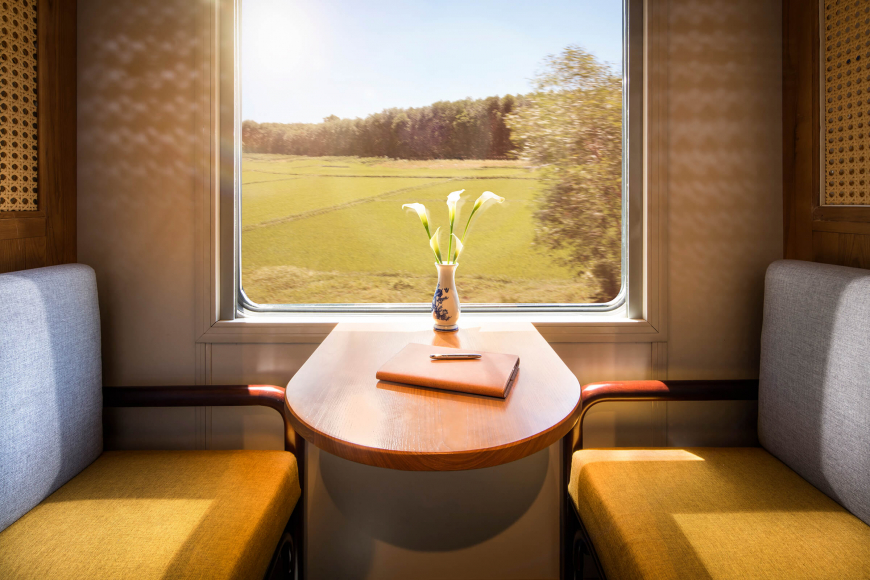
The VIP treatment
You’ll be greeted on the platform with a welcome drink, and treated like royalty for the entire trip. For your fare, you also get free-flowing drinks (including wine and beer, bubbly, soft drinks, mocktails, cocktails, tea or coffee), head-and-neck massages with a window view, and a three-course gourmet meal inspired by French and Vietnamese cuisine. Luxury treats, such as champagne, caviar, foie gras and lavish cheese platters, are on hand if you pre-order. In addition, many ingredients are locally sourced specialities. Think pepper from Phu Quoc Island, onions from Ly Son island, and so on.
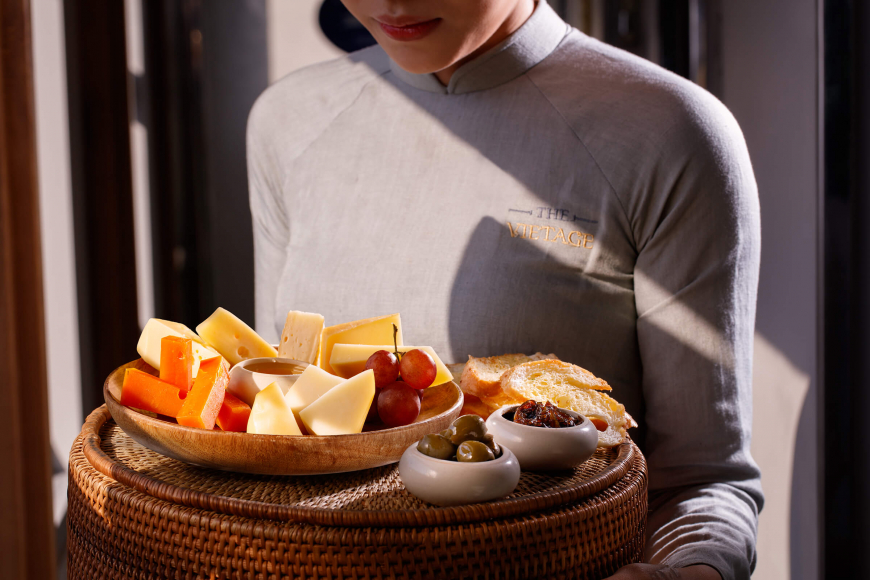
And all of this plays out in beautiful spacious, surroundings. The wooden Art Deco interiors nod to the colonial era, with a caramel colour palette and rattan screens adding calm cohesion to the look. The seats in the private cabins can be converted into beds, for anyone wanting a nap. There’s a swanky horseshoe-shaped bar with a wine cellar and marble countertops, where the top-quality refreshments are served in style. Travelling with kids? There’s a kids’ menu as well as activities to keep them entertained en route.
- You are here:
- Things to do
Create an account
Already have an account? Click here to sign in
By clicking submit, you agree to our Privacy Policy and Terms of Use
Sign in with your social accounts
Sign in with your email
Forgot password? Click here to get it back
Don't have an account? Sign up here
Forgot Password
The entered email has subscribed for Vietnam Tourism monthly newsletter

Traveling by Train in Vietnam: Our Guide
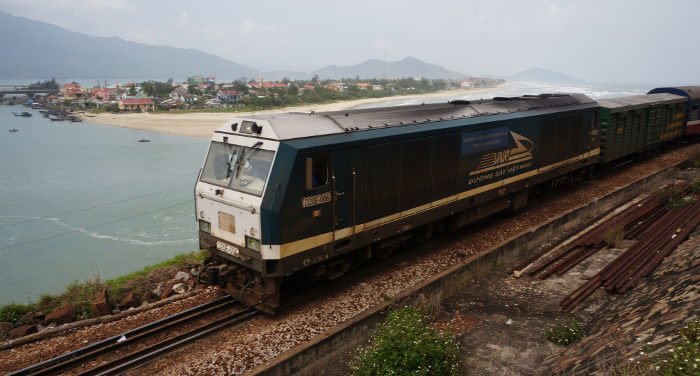
An interesting option to cross Vietnam (or just to cover a part) is to take the train: which is certainly the oldest and most famous means of transport in Vietnam. From the trains you can enjoy breathtaking views and have an authentic experience in contact with the local population.
Vietnam’s shape is perfect for going from north to south, or viceversa, and you certainly won’t get lost anywhere. Moreover, traveling by train has other advantages, especially if you’re in a rush and want to slowly enjoy the atmosphere of the trip in order to discover the country.
How to book and buy a train ticket in Vietnam
Traveling by train within Vietnam is a different and stimulating experience, even though many young travelers prefer to cross the country seated on an old motorbike or in a bus.
After deciding how to travel and where to go, to buy a ticket you can go to one of the ticket offices found inside the station. Remember to bring your passport with you, because it will be required in order to buy your ticket or confirm your booking and information on your ticket.
Buying a ticket in a Vietnamese station could be complicated if you can’t find anyone who speaks a little English. It happened to me! No reason to panic. There will be someone who’ll know a few words in French and you’ll certainly manage to make yourself understood with gestures and some help.
Nevertheless, if you want to avoid finding yourself in long, enigmatic situations and risk missing your train, you can opt for making your purchase online before leaving, such as on Baolau .
The other advantage of booking online is that you can buy your ticket ahead of time without having to go to the station twice!
Classes and seat types on Vietnamese trains: soft and hard seat
In Vietnam there are different types of trains, indicated by the initials SE, TN or STN. The SE1, SE2, SE3 and SE4 are the best trains. Depending on the train you choose, there could be some or all types of coaches.
As in Europe, in Vietnam too the most comfortable class is first class. The first class wagons are furnished with the most comfortable seats, air conditioning, and power outlets. For night trains running long routes, in first class there are compartments with bunk beds, a private sink, a table, bedding and covers.
Included in the price you’ll also get a meal, something similar to those of the airlines. Another excellent thing about Vietnamese trains are that kids under 5 years old travel for free.
Supposing it’s a 7 hour trip, the price for a journey of this type could cost you about 20 American Dollars.
Second class offers a few more comforts (such as beds, or chairs that are less comfortable than those in first class). In third class you’ll instead find rigid wooden seats.
In general, in Vietnam you have to choose your seat and category. You can choose a hard seat, which as the name would suggest is a rather uncomfortable chair, usually made of wood. These seats are usually chosen by the Vietnamese since they’re the cheapest ones.
Or you could choose a soft seat, or slightly more comfortable chair that might recline but not as far as a bed, which is certainly less comfortable than a bed but good for a trip that isn’t too long. For short routes you can also decide to travel like a local and sit in a hard seat.
For more intensive trips choose a sleeper – bunks that vary between hard and soft depending on the number of bunks in the same compartment or carriage.
Keep in mind that they’ll try to sell you bunks with 4 spots and air conditioning, or in other words, the most expensive ones. If you’ve read this article, you’ll definitely know to ask for a different type of seat that would be cheaper.
There are also luxury trains that travel through Vietnam.
Train itineraries in Vietnam
Below I’ll recommend three splendid train itineraries that start from Hanoi .
From Hanoi to Sapa: 296 km in 8 hours
Traveling from Hanoi to Sapa by train is a spectacular experience during your trip in Vietnam . You’ll travel comfortably and at a low price. There are different options you could choose from, leaving Hanoi at night. The end of the line is Lao Cai , a town at the border with China, and from there you can continue on to Sapa with a minibus.
Depending on the station, the trains could be full of tourists, since Sapa is a popular mountain town. At the end of the year, for example, there shouldn’t be huge crowds, while from the end of the year to March I’d recommend that you book your train ahead of time. You can do so via internet, through Baolau , for example.
You’ll be surprised by the number of trains that travel the Hanoi-Sapa route: SapalyTtrain, King Express, Fanxipan, OrientalExpress and others. Really, these companies have only one or two carriages which when put together make up one single train. The offerings, both in terms of price and services onboard are more or less the same.
2. From Hanoi to Halong Bay
As I said in this article , there are many ways to get to Halong Bay, but there’s only one train which is still rather unknown that connects Hanoi to the bay.
In fact, you could avoid the many agencies offering complete packages with transfers and itineraries, and leaving from Yen Vien station, get to Halong. It’s a local train and count on just a few cars with wooden benches. Try it only if you want to have a fascinating experience far from the crowds.
3. From Hanoi to Ho Chi Minh City
Have you ever heard of the Reunification Express? This is the train that crosses the whole of Vietnam, from north to south or from south to north, from Ho Chi Minh to Hanoi or viceversa . The Reunification Express is the country’s historic train that covers more than 1000 kilometers for a total of 34 hours of travel.
It might not be the cheapest or fastest way to cross Vietnam, but it is definitely the most fascinating way of seeing the entire country, crossing through villages, beaches, mountains, rice paddies and cities in the company of other travelers, but especially many Vietnamese who’ll get on at the countless stations in between. You shouldn’t make the trip all at once.
How does the Reunification Express work? You should choose which stations you want to get off at to visit, and buy tickets for those specific ones. In fact, it allows you to get off at the station you choose and get back on the train the next day for your next destination, without a time limit – except that of your visa.
Just the departure from Hanoi will already present a fascinating scene when you find yourself in the Old Quarter with your mouth open, among cramped alleyways suspended between various eras and thousands of colors.
The price of a ticket varies depending on the intermediate stops you decide to make between Hanoi and Ho Chi Minh. For example, the route between Nha Trang and Ho Chi Minh could cost about 20 Dollars and so on.
Final advices
Although Vietnam is not a dangerous country, as is the case with all of southeast Asia, I recommend that you travel safely by respecting a few small precautions. With a little good sense you can travel anywhere!
Traveling slowly by local means on unusual routes means pleasant encounters that are also often noisy. This is something to consider even depending on which seat you choose on the train. It’s nothing to worry about however, traveling by train will be an experience that will remain indelible in your memory.
I also recommend that you bring along some food for long trips, even though there will certainly be Vietnamese that will come aboard the train and will offer you something to buy.
Here’s a detailed map of the rail network in Southeast Asia.
About The Author
Elena Muscas
Related posts.
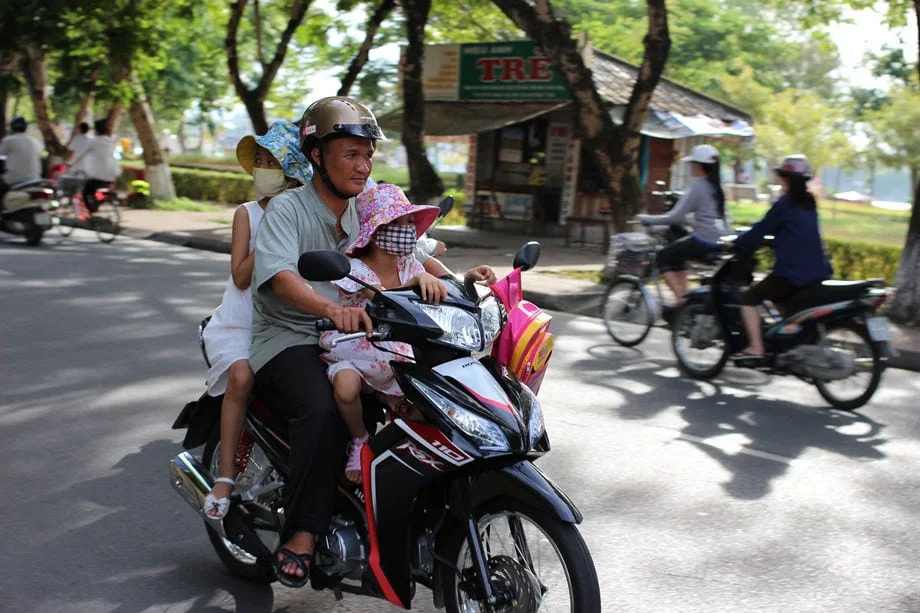
Ten unconventional habits of Vietnamese (photo stories)
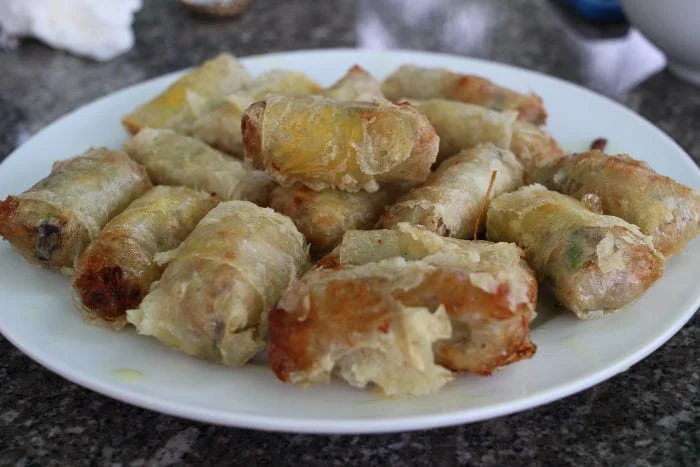
Mama I wanna be a playboy in Saigon
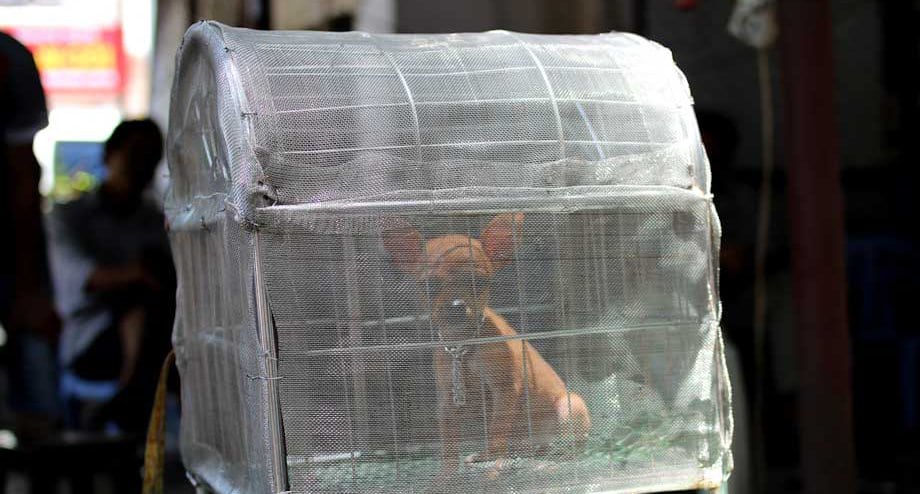
Dog meat in Vietnam (photos NSFW)
Leave a comment cancel reply.
Your email address will not be published. Required fields are marked *
Save my name, email, and website in this browser for the next time I comment.
Privacy Overview
Get 3 Months FREE with EXPRESS VPN
+ Best VPN For China + 30-Day Money-Back Guarantee + 24/7 Live China Customer Support + 3 Months Free on 12 Months Package
- Privacy Policy
- Terms & Conditions
Vietnam Train Tickets
- Orient Express Train
- Lotus Express Train
- Fansipan Express Train
- Livitrans Express Train
- Sapaly Express Train
- Chapa Express Train
- Laman Express Train
- King Sapa Train
- Viollete Express Train
- FROM HANOI Trains from Hanoi
- HANOI TO SAPA Trains Hanoi to Sapa
- FROM DANANG Trains from Danang
- FROM NHA TRANG Trains from Nha Trang
- FROM HUE Trains from Hue
- FROM HCM CITY Trains from Ho Chi Minh City
- About Us About Us
- Privacy Policy Privacy Policy
- Terms & Conditions Terms & Conditions
- Contact Us Contact
Trains from Bien Hoa
Trains from danang, trains from dieu tri, trains from dong hoi, trains from hai phong, trains from hanoi, trains from ho chi minh city, trains from hue, trains from mui ne, trains from muong man, trains from nam ninh, trains from nha trang, trains from ninh binh, trains from phan thiet, trains from sapa, trains from tuy hoa, trains from thanh hoa, trains from thap cham, trains from vinh, your tickets, 4 steps to book.
- Search or Select Train
- Fill in all the useful information required
- Get Tickets in Vietnam
F.Asked Questions
- Why book with us?
- How can I pay for my ticket?
- How do I get my train tickets when I completed payment for my ticket?
- When I pay the train tickets on your website successfully but you confirm that my order is unavailable. So, How long can I be refunded of money?
- What are the baggage regulations for train in Vietnam?
- How do I buy tickets for my Children?
- I purchased your train tickets, but I can’t get the train at my booking date. What are the refund regulations for train in Vietnam?
- How to book a train ticket with Vietnam-Railway.com?
- Can I get the train to Hoi An?
- Is it possible to purchase a ticket that allows for multiple stops?
- Incase we forget or lost our luggages on train, can we take them again ? how?
- Can we take our motorbikes when travelling on train ? how much does it cost ?
- Can I take our pets on train?
- How can I get tickets if I buy tickets of tourist train ?
- If I lose my tickets of reunification train, How can I get on train ?
- For VIP cabin of tourist train, If i myself travel alone, Can I book for it ?
- If I haven't received my tickets yet, How should I do?
Vietnam Train Schedule
- Train from Sapa
- Train from Hanoi
- Train from Ninh Binh
- Train from Vinh
- Train from Dong Hoi
- Train from Hue
- Train from Danang
- Train from Dieu Tri
- Train from Nhatrang
- Train from Thap Cham
- Train from Mui Ne(BT)
- Train from Phan Thiet
- Train from Ho Chi Minh
Customers' Testimonials
Welcome to vietnam train - an online sales agent for vietnam railways providing vietnam train tickets for your trip to all of the destinations in vietnam..

IMAGES
VIDEO
COMMENTS
Make your Vietnam railway booking to embrace the epic romance of train travel on exquisite journeys. From the heritage charm of Hoi An to the sparkling shores of Quy Nhon, or the bustling coastal city of Nha Trang heading north to Quy Nhon, The Vietage by Anantara combines old-world comfort, breath-taking views and gourmet dining experiences to ...
Local Vietnamese Tales. Your hosts onboard the train will weave stories about local history as the scenery unfolds. Vietnam ...
VIEW ALL VIETNAM HOLIDAYS. VIEW ALL VIETNAM ACTIVITIES. Call us on 0208 150 5150, for International callers 004420 8150 5150, send us an e-mail [email protected] or just use the form opposite. Discover Vietnam by train and get a completely different perspective of this captivating country as you travel up the spine of the country.
The price of tickets depends on your train and which class you book. Hard seats is the cheapest and least comfortable option. Soft sleeper is suitable for long distances at night, but also more expensive (recommended!). For a ride from Hanoi to Hue you pay around 500,000 Dong, which is around $ 22.
Indulge in delectable local cuisine in the scenic landscapes of Vietnam, discover Cambodia's ancient temples and rich history, and witness some of the most iconic landmarks on our Cambodia and Vietnam tours. Uncover the beauty of Vietnam and Cambodia with us. Excellent 7,581 reviews on. Find out more with a free brochure and enjoy weekly travel ...
Train travel in Vietnam has a generally good safety record, with safety measures in place to ensure the well-being of passengers. Trains are equipped with safety features, and staff are trained to handle emergencies effectively, providing passengers with peace of mind during their journey. 10.
Visit two major attractions of southern Vietnam—one historical, one natural, both cultural—on this full-day tour to the Cu Chi Tunnels and the Mekong Delta from Ho Chi Minh City. Explore the tunnel system and learn about its role as a hospital, living quarters, storage, and more during wartime, and then cruise through the canals of the ...
Cambodia by Private Train. from $7,985 AUD pp. Discover the tour. Experience Vietnam on this small group escorted tour. Travel by private train & sail Halong Bay in a special boat. Visit Hanoi, Hoi An and Ho Chi Minh. Book now!
Fare around VND 568,000 ($30) with a comfy soft sleeper berth. Day 2, travel from Nanning to Guangzhou by high-speed train in just a few hours, leaving Nanning main station on train D3625 at 13:22 and arriving Guangzhou South at 17:22. The fare is around RMB 172 ($25) in 2nd class or RMB 275 ($40) in 1st class.
Relax along the serene waters of the Mekong River or magical Ha Long Bay. Discover visually striking floating villages and emerald green rice paddies. Learn all about the country's colonial-era history or explore the rural countryside. Vietnam is a land of breathtaking beauty and cultural charms. It's exotic, bustling, and a feast for the senses. Unforgettable travel moments are everywhere.
1. Hai Phong to Hanoi train route - panoramic view of the Red River. Image credit: Báo Du Lịch From Hai Phong's Railway Station, passengers can buy train tickets at VND130,000 (~USD5.61) for a 2-hour-and-45-minute ride to Hanoi.. Covering 102KM, the railway route between Hanoi and Hai Phong is filled with picturesque landscapes such as rice fields and bustling streets portraying vibrant ...
The Hanoi Hue train can take around 14 hours and costs from $36 to $80 . Every day, there are 5 trains serving this line including Vietnam Railways night or day trains and luxury tourist train companies such as Livitrans (SE3 and SE4), Laman (SE19), Lotus (SE19 and SE20) and Violette (SE1 and SE3).
The Hanoi Hue train can take about 14 hours and costs between $36 and $80. Each day, there are 5 trains serving this route including night or day trains of Vietnam Railways and luxury tourist train companies such as Livitrans (SE3 and SE4), Laman (SE19), Lotus (SE19 and SE20) and Violette (SE1 and SE3).
15 DAY ADVENTURE from Hanoi to Ho Chi Minh City. Come travel on the transport and freight 'lifeblood' of Vietnam - along the segments of the Reunification Express that will leave you both in awe and inspired. Travel along cliff-top sea view tracks, into tunnels framed with jungle, down iconic 'Train Street' and through magazine-famous ...
10 Days | Discover backwaters, karst-studded bays, bustling cities and bicycle-powered food carts. 5 out of 5 based on 1177 reviews submitted. Explorer. From. AUD $1,432. Add to my wishlist. View dates and book. Show all the images.
The train rounds a bend on the Hanoi-to-Da Nang leg of photographer Katherine Wolkoff's journey in Vietnam. Photo: Katherine Wolkoff In college, I studied American history.
SJourney introduces the sole and first-ever luxury train journey across Vietnam, opening an adventure to indulge in the beauty of cultural coalescence, contemporary art, people, and natural landscapes. The train travels along the S-shaped strip of land, departing from Hanoi Capital, stopping at numerous majestic destinations and arriving lastly ...
FRANKO'S Rail Tours travel the length of Vietnam by private train - from the Mekong Delta to the Red River Valley and Chinese Border. ... ONE Rail Tour of VIETNAM still available in 2024. Tour #2 will BEGIN in early November (Tour Dates 03 - 20 November 2024) (Vacancies exist. Please indicate your interest early)
Train travel in Vietnam can be a social experience, even if travelling alone. Sharing a sleeping cabin for many hours with several strangers is an inherently intimate situation which lends itself to social interaction with your fellow passengers. I've met people on Vietnam's trains many times. One of the endearing qualities of Vietnamese ...
On the way, you'll get to admire the beauty of Central Vietnam, with its vivid green rice paddies, verdant mountains and sparkling coastline. Source: thevietagetrain. When CNN named this train ride among Asia's six most amazing rail journeys, they said: "The scenery is as peaceful as it is lush: water buffaloes graze in wide-open fields ...
The SE1, SE2, SE3 and SE4 are the best trains. Depending on the train you choose, there could be some or all types of coaches. As in Europe, in Vietnam too the most comfortable class is first class. The first class wagons are furnished with the most comfortable seats, air conditioning, and power outlets. For night trains running long routes, in ...
Vietnam Train Online Ticket Reservation with detailed train schedules on all routes: Hanoi, Ho Chi Minh City, Hue, Danang, Sapa and Nha Trang. About Us; ... On Vietnam-railway.com, you'll find Vietnam Railways train for domestic travel, cheap tickets, Web Check-in information, baggage and travel advice. ...
Hanoi Jeep Tours: Food+ Culture +Fun By Vietnam Army Legend Jeep. 6,666. Recommended. 99% of reviewers gave this product a bubble rating of 4 or higher. Bus Tours. from . ... Private Hanoi City Half-Day Tour with Train Street Visiting. 112. Recommended. 98% of reviewers gave this product a bubble rating of 4 or higher. Historical Tours. from .
The cost of a one-way Vietage journey is $420 per person. The new route departs from Nha Trang Train Station at 2 p.m., arriving at Dieu Tri Station in Quy Nhon at 6:29 p.m. For those preferring ...